
The Project Gutenberg eBook of The story of chamber music, by Nicholas Kilburn
Title: The story of chamber music
Author: Nicholas Kilburn
Release Date: March 4, 2023 [eBook #70203]
Language: English
Produced by: Andrew Sly, MFR, Linda Cantoni, and the Online Distributed Proofreading Team at https://www.pgdp.net (This file was produced from images generously made available by The Internet Archive)

MUSIC-STORY
SERIES
CHAMBER MUSIC
CONTENTS
LIST OF ILLUSTRATIONS
TRANSCRIBER’S NOTES
The Music Story Series
Edited by
FREDERICK J. CROWEST.
The
Story of Chamber Music
The Music Story Series.
Already published in this Series.
THE STORY OF ORATORIO. By Annie Patterson, B.A., Mus. Doc. With Illustrations.
THE STORY OF NOTATION. By C.F. Abdy Williams, M.A., Mus. Bac. With Illustrations.
THE STORY OF THE ORGAN. By C.F. Abdy Williams, M.A., Mus. Bac. With Illustrations.
THE STORY OF CHAMBER MUSIC. By N. Kilburn, Mus. Bac. (Cantab). With Illustrations.
The next volume will be
THE STORY OF THE VIOLIN. By Paul Stoeving. With Illustrations.
This Series, in superior leather bindings, may be had
on application to the Publishers.
[ALL RIGHTS RESERVED.]

Sir E. Burne-Jones, pinx.
F. Hollyer, photo.
Chant d’Amour.

BY
N. Kilburn
Mus. Bac. (Cantab.)
Conductor of the Middlesbrough, Sunderland, and
Bishop Auckland Musical Societies.
London
The Walter Scott Publishing Co., Ltd.
New York: Charles Scribner’s Sons
1904
-v-

Berlioz, who, by the way, wrote no chamber music save a serenade for two flutes and harp (“L’Enfance du Christ”), in his imaginative fashion somewhere speculates as to which of his own works he would preserve if it were ordained that all except one should perish. In like manner, we may ask ourselves which of the great forms of musical composition we would plead for in case all the rest were doomed to destruction. Music for the orchestra, with its vivid colours, its strength and delicacy; the vast range of choral music; works for the organ, that huge modern plexus of pipe and reed;—these and others no doubt have strong claims on our musical affections. But, if forced to such a choice, it is certain that many a musician would, without hesitation, pledge himself to uphold the claims of Chamber music, for who can measure the almost infinite variety and charm which it affords, and that, too, with the slenderest means?
Probably no other form of music would wear so well as this, and to hardly any other could we turn, day by day, with such abiding satisfaction. Of course, in a-vi- matter of this kind unanimity is not to be expected, and some will no doubt take exception to the view here stated; but, all the same, it may be confidently asserted that the more this kind of music is cultivated, and the more thoroughly its literature is known and studied, the less divergent will opinion tend to become.
The term chamber music, excluding piano solos, which, strictly speaking, do not come under this head, embraces compositions in the form of duets, trios, quartetts, and other larger combinations, for strings (i.e. violins, violas, ’cellos, and double basses), and for wind instruments (chiefly wood wind and horns), both with and without the pianoforte.
Of all the musical forms, this of chamber music is the most adapted for home consumption, and its cultivation by any community may safely be taken as a strong proof of an advanced condition of musical taste.
As regards the present day tendency, no doubt many chamber works are written too much in orchestral style; and, in addition to this, there has arisen an inclination on the part of some composers to make this form express more than it seems naturally fitted to do. We allude to string quartetts such as Raff’s op. 192, “Die Schöne Müllerin,” and Smetana’s “Aus meinem Leben,” which introduce the programme idea into chamber music.
It should not, however, be overlooked that this tendency is by no means absent in the compositions of earlier times. Among others, Bach and Beethoven-vii- contributed towards it; and in a number of Haydn’s string quartetts we find a proneness towards realism, although the usual classical form is in no way violated; such, for example, as op. 33, No. 3, “The Bird”; op. 50, No. 6, “The Frog”; op. 64, No. 5, “The Lark”; op. 74, No. 3, “The Rider.” It is not to be taken that Haydn gave these names to the movements, but that the imitations, while artistically good, are too obvious to be overlooked, and have led up to the fancy titles which have grown round the compositions.
Even in the earliest forms of vocal music such realism may occasionally be found. Mr. Henderson, in his book, How Music Developed, tells of certain composers, about the year 1550, who tried to imitate natural sounds and movements. He names a work by one Jannequin, in which an attempt is made to portray the street life of Paris; and that, too, in a piece written for four voices, and entirely unaccompanied! As showing how, with a difference, history repeats itself, one can hardly help being reminded by this of an orchestral composition by a distinguished musician of our time which has for its purpose the portrayal, in vivid musical colours, of the street life of great London city. We allude, of course, to Dr. Elgar’s Cockaigne overture, “In London Town.”
It is also now the custom to perform chamber music in large concert halls. No doubt, so far as the public is concerned, this is convenient, and maybe it is, financially, essential. None the less it cannot but be regarded as a perversion, for such music is heard to the-viii- greatest advantage under what may be called domestic conditions. Richard Wagner said that he never knew what Beethoven’s sonatas really meant until he heard them played by Liszt, under the most sympathetic conditions, at Wahnfried, his (Wagner’s) residence in Bayreuth.
The String Quartett may be regarded as the prototype, on the instrumental side, of chamber music, and along with it must be placed the other like forms of Quintett, Sextett, etc.; also the Octett, and Double Quartett, which differs in its antiphonal style from the Octett.
All these imply the opportunity for perfect intonation. The use of the pianoforte, however, introduces another “atmosphere.” Perfect intonation is no longer possible, and the purity which the “strings” afford is of necessity somewhat marred.
It may no doubt be fairly urged that “all life is but a compromise,” and that the utility of the pianoforte and the splendid array of compositions which it has called forth condone its defects. This is unquestionably true, but none the less it must be said, in spite of the practical hindrances which exist, that the imperfect intonation of the tempered scale falls short of the artistic ideal.
The late Sir G.A. Macfarren, although an advocate of the tempered scale, acknowledges that “on the voice and on bowed instruments the smallest gradations of pitch are produceable, and so all notes, in all keys, can be justly tuned, which, among others, is one reason for-ix- the exceptional delight given by music that is represented by either of these means.”[1]
Those who are interested will find the matter fully argued in Perronet Thompson’s treatise on Just Intonation, in the preface of which work the case against the tempered scale is thus stated with characteristic fervour:—“Among the signs of progress in these times (1850!) is the growing discontent with the thing called temperament. Instead of being considered as the crowning exertion of musical skill, it begins to be viewed as a lazy attempt to save trouble, like nailing a telescope to one length for all eyes and distances, or making the fingers of a statue of one medium size. The belief also gains ground that all who are able, as for example singers and violinists, do without it, or more properly, perform in tune in spite of it.”
On the other side a high authority[2] says:—“An ideally tuned scale is as much a dream as the philosopher’s stone, and no one who clearly understands the meaning of Art wants it.” And farther on he adds:—“It will probably be a good many centuries before any new system is justified by such a mass of great artistic works as the one which the instincts of our ancestors have gradually evolved for our advantage.”
Thus we find that one view is based on the ideal principle that if, on instruments of the piano and organ type, one key can be put in perfect tune, the whole matter becomes only a question how practically to get-x- over the mechanical difficulty of modulation into other keys. The other view, of course, is that by the compromise of putting all keys a little out of tune you solve the difficulty most easily; that our present musical system, to which is due the wonders of our present-day music and its magnificent literature, is based on the tempered scale; and, above all, that it works well.
This question no doubt belongs, strictly speaking, to the science of Acoustics; but of all the forms of the art, chamber music is the one most affected by intonation, hence these few words on a deeply interesting matter, which may some day become one of the practical considerations in connection with music.
N.K.
May, 1904.
-xi-

THE BEGINNINGS OF CHAMBER MUSIC.
| PAGE | |
| How Chamber Music began — Early Chamber Music compositions — Musical position of England — Purcell — J.S. Bach — Great violin makers — Haydn and Mozart — Corelli and the compass of the violin — William Shield and 5/4 time | 1 |
CHAMBER MUSIC INSTITUTIONS AND CONCERTS.
| John Banister’s concerts — Thomas Britton, the musical coalman — Britton’s concerts — “Music Meetings” — Oxford Music School — Pepys’s Diary — Evelyn’s Diary — Frederick the Great — Bach and the Emperor — The Emperor Frederick’s compositions — Dando concerts — John Ella and The Musical Union — Analytical programmes and position of platform — Quartett Association — Dannreuther’s Musical Evenings — Sir Charles Hallé’s recitals — Monday Popular Concerts — Joachim — Various chamber music institutions — Japanese chamber music | 12 |
-xii-
HAYDN, P.E. BACH, DITTERSDORF, HANDEL.
| J.S. Bach — Joseph Haydn — Philipp E. Bach — Dittersdorf — Early quartetts of Haydn, Mozart, and Beethoven — Silence as an effect in music — Haydn’s quartetts — Haydn’s Kaiser Quartett — Haydn’s other chamber music — Handel | 37 |
MOZART.
| Mozart’s C major Quartett — Mozart’s string quartetts — The genius of Mozart — Mozart’s other chamber music — Wagner on Mozart — Mozart’s letter to his father | 59 |
BEETHOVEN.
| Beethoven as democrat — Rhythmic similarities — Beethoven’s first and last compositions — Musical humour — The distinction in Beethoven’s chamber music | 71 |
SCHUBERT, MENDELSSOHN, SCHUMANN, AND SPOHR.
| Schubert as song-writer — Schubert’s chamber music — Mendelssohn — Mendelssohn’s position in England — Mendelssohn’s character — Mendelssohn’s chamber music — Schumann — Schumann as absolute musician — The E♭ Piano Quintett — Piano trios — Spohr’s opinion of Beethoven’s work — Characteristics of his compositions | 82 |
-xiii-
BRAHMS AND DVOŘÁK.
| Opinions of Brahms — Weingartner — H.T. Finck — Bülow on Rubinstein — H. Davey — Schumann — W.J. Henderson — Philip Spitta — Sir Hubert Parry — W.H. Hadow — Piano Trio, op. 8: two versions — Horn Trio, op. 40 — String Sextett in B♭ — String Sextett in G major — Piano Quartett in G minor — Quintett in F minor — String Quartetts — Thematic resemblances — String Quintetts — Clarinet Quintett — Dvořák — Revival of Bohemian music — Birthplace and early career — Criticisms on his works — His symphonic poems for orchestra — An American national style of music — The Negro Quartett — String Quartetts — Piano Quartetts — Piano Trios — String Sextett — Other chamber music | 101 |
CHAMBER MUSIC OF THE RUSSIAN COMPOSERS.
| Russian chamber music — Glinka — Quartett by Ippolitoff-Ivanoff — Quartett by Gretchaninoff — Mozart on melody — Russian schools of musical thought — Belaieff — String Quartett on name Belaieff — Arensky — Trio in D minor: Arensky — Sokoloff — Tanyeëff — Kopyloff — Tschaïkovsky | 133 |
RICHARD STRAUSS AND ANTON BRUCKNER.
| Position with regard to classical form — Strauss’s chamber music — Bruckner’s character and individuality — Bruckner’s symphonies — String quintett in F major — Hanslick on Bruckner’s works — Krehbiel on Bruckner’s Seventh Symphony — Weingartner’s opinion | 177 |
-xiv-
CHAMBER MUSIC OF RECENT TIMES.
| Trio by E. Schütt — Trio by Kirchner — Raff’s C minor Trio — Balfe’s Trio in A major — Trio: C. Hubert Parry — Trio: Bargiel — Sterndale Bennett’s Trio, op. 26 — Trio, D minor: F.E. Bache — Trio, E flat: Nawratil — Trio: Goetz — Trio: Schmidt — Other Trios — String Trios — Quartett: Mackenzie — E flat Quartett: Rheinberger — Quartett: W. Rabl — Quartett: Prout — Quartett: Verdi — Quartett: Onslow — Quartett: W.H. Veit — Unusual combinations | 191 |
| Appendix A. — Chronological and Biographical | 209 |
| Appendix B. — Glossary of Terms | 244 |
| Index | 249 |
-xv-

| PAGE | |
| “Chant d’Amour”: Photogravure after Sir E. Burne-Jones’s Painting | Frontispiece |
| A Group of Musicians | 15 |
| The Joachim Quartett | Face 32 |
| Beethoven | Face 71 |
| Brahms | Face 101 |
| The Bohemian Quartett | Face 123 |
| Ippolitoff-Ivanoff and Arensky | Face 135 |
| Richard Strauss | 178 |
-1-
The
Story of Chamber Music.

THE BEGINNINGS OF CHAMBER MUSIC.
How Chamber Music began — Early Chamber Music compositions — Musical position of England — Purcell — J.S. Bach — Great violin makers — Haydn and Mozart — Corelli and the compass of the violin — William Shield and 5/4 time.
“In the time of the Frankish kings,” says Mr. H.E. Krehbiel,[3] “the word chamber was applied to the room in the royal palace in which the monarch’s private property was kept, and in which he looked after his private affairs. When royalty took up the cultivation of music it was as a private, not as a court function, and the concerts given for the entertainment of the royal family took place in the king’s chamber or private room. The musicians were nothing more nor less than-2- servants in the royal household. This relationship endured into the present century. Haydn was a Haus-officier of Prince Esterhazy. As vice-chapelmaster he had to appear every morning in the prince’s ante-room to receive orders concerning the dinner music and other entertainments of the day.”
This may be taken as one explanation of the origin of chamber music. Another is that near the end of the fifteenth century, madrigals and other pieces which no doubt were originally intended for singing began to be described as “madrigali et arie per sonare et cantare,” or, in the plain English of the time, “apt for voices and instruments,” by which is meant that the instruments joined with the voices probably at first to support them, both performing the same music.
About the same period and earlier it became customary to introduce instrumental music at the banquets of the wealthier classes, and what may be regarded as chamber music was used as a stimulus and a cover for conversation, a practice not even yet quite obsolete.
From some such sources it seems likely that this form of music made a beginning. Composers then began to turn their attention to the growing requirements of such performers, and we find that many works were issued chiefly in the form of Courantes,-3- Sarabandes, Gavottes, Gigues, and other dance forms. Music called Fancies, and sets of Ayres, and other pieces for lutes (a kind of guitar), and viols (the predecessor of the violin), also incidental music for masques, were much in vogue in England about this time, composed, among others, by Morley, Gibbons, John Dowland, Mace, Sympson, Jenkins, Lawes, and Locke. Hugh Aston, an instrumental composer of distinction, may also be mentioned. He left, among other works, a hornpipe which is remarkable. There is also a virginal book in the library at Cambridge that contains two or three hundred pieces for virginals, which instrument was a kind of harpsichord. In 1611 a collection of music for the same instrument was issued, the compositions of Byrd, Bull, and Gibbons. It was called “Parthenia.” Byrd’s “Variations on the Carman’s Whistle,” and Sellinger’s “Round,” are noteworthy works. John Jenkins published sonatas for two violins and a bass, with thorough bass for the organ and theorbo.
This was the great period of English music. Our position as compared with other nations was one of artistic supremacy, and we ought not to forget this as Continental writers are apt to do to-day.[4]
-4-
Later on compositions such as we have mentioned were followed both in England and on the Continent by works of a more highly organised character, and to some of them the titles Sonata and Concerto were applied. These must not, however, be confused with the music of like name of our day, for they were much simpler in construction, and contained little or nothing of what we call development.

Thus we find, to name but a few examples, that Reinken (1623-1722), a pupil of the celebrated Amsterdam composer, Sweelinck, wrote a notable Quartett, or Suite, for two violins, viola, and bass, which he called “Hortus Musicus.” Our own Henry Purcell (1658-95), whose compositions in many styles are so justly held in high esteem, left among others the so-called Golden Sonata, one of a fine set for stringed instruments. Corelli (1653-1713) too, a distinguished violinist and composer, of-5- Italian origin, published in 1685 (the year J.S. Bach was born), twelve chamber sonatas for two violins, ’cello, and harpsichord.
John Sebastian Bach (1685-1750), whose mighty influence pervades the art of music of our day, and seems likely to increase in the future, wrote in all styles, even that of the Humorous Cantata. We need, however, here only mention his clavier music, which alone extends to four goodly-sized volumes; his compositions for clavier and strings, and flute; and, especially as belonging more particularly to chamber music, the Sonata in C major for two violins and clavier; another in G major for flute, violin, and clavier; and also that in C minor for the same instruments, from the so-called “Musical Offering,” which was written for the Emperor Frederick the Great of Prussia, on a theme given to Bach by that monarch himself.
Among those more or less distinguished composers who contributed to the store of chamber music about this time, may be named Geminiani (1680-1762), Tartini (1692-1770), Giardini (1716-96), Pugnani (1731-98), and Philipp Emanuel Bach (1714-88), a son of John Sebastian. These lead up to, among others, Dittersdorf (1739-99), Boccherini (1743-1805), and-6- Haydn (1732-1809), whose first String Quartett was published in 1755.
It may not, however, be overlooked that the influence of the great violin makers, the families Amati, Guarneri, and Stradivari (1535-1745), contributed not a little to the advancement of chamber music, for these men were no mere artisans engaged in the manufacture of instruments from a commercial point of view. Rather were they true artists, and the product of their labours furnished both performers and composers the highest means of artistic expression. During the period in which they worked, the old viol was gradually changed into the violin, viola, and ’cello of our time, a change which has had a most important and far-reaching effect on the entire art of music.
With Joseph Haydn (1732-1809) we enter a new era, for before the time
of this master and of Mozart, says a high authority,[5] “such a form
(the string quartett) hardly existed, and their work with it was such
as almost to complete its artistic maturity in the course of one
generation.” The same writer also states that prior to the time of
these two great masters “the pleasure of the player-7- was more studied
than that of the auditor,” by composers of chamber music. In this
connection, technically considered, it is interesting to note that
Corelli, who has already been mentioned as a distinguished performer
on the violin as well as a composer, regarded the note D
 as the upward limit of the violin’s compass, and he refused to entertain,
on the ground that it was impossible, any passage written higher than
this note.[6] Yet in Haydn’s Quartett op. 76, No. 5, which was written
not so very long after the time referred to, there is a violin passage
that reaches the note F♯ one octave and two notes higher than Corelli’s
limit; also in the finale of the same composer’s Quartett op. 77, No.
2, a passage reaching an octave higher, and in other of his quartetts,
the adjacent high notes C and B♭ are frequently written. Thus we see
that along with the growth of musical ideas there was a corresponding
expansion of technical means.
as the upward limit of the violin’s compass, and he refused to entertain,
on the ground that it was impossible, any passage written higher than
this note.[6] Yet in Haydn’s Quartett op. 76, No. 5, which was written
not so very long after the time referred to, there is a violin passage
that reaches the note F♯ one octave and two notes higher than Corelli’s
limit; also in the finale of the same composer’s Quartett op. 77, No.
2, a passage reaching an octave higher, and in other of his quartetts,
the adjacent high notes C and B♭ are frequently written. Thus we see
that along with the growth of musical ideas there was a corresponding
expansion of technical means.
As regards the music of this particular period, even in features which are generally supposed to belong exclusively to modern music, it is interesting to find that the older composers have really set the pattern. For example, the popular idea is that the 5/4 movement-8- in Tschaïkovsky’s Pathetique Symphony is a rhythmic novelty. Yet in a set of six chamber trios published in 1790 by William Shield (1748-1829), Musician-in-Ordinary to his Majesty, may be found such a movement, and this is all the more curious seeing that it is marked “Alla Sclavonia,” thereby betokening some connection between Russian music and this unusual kind of time. Shield was a prolific writer of works both practical and theoretic. Some forty, now forgotten, operas are credited to him, but his songs remain among the best which England has produced, such for instance as “The Wolf,” “Old Towler,” “Arethusa,” and “The Thorn.”
We quote a portion of the String Trio which has been mentioned:—
Giuoco: Alla sclavonia tempo straniere con variazione.
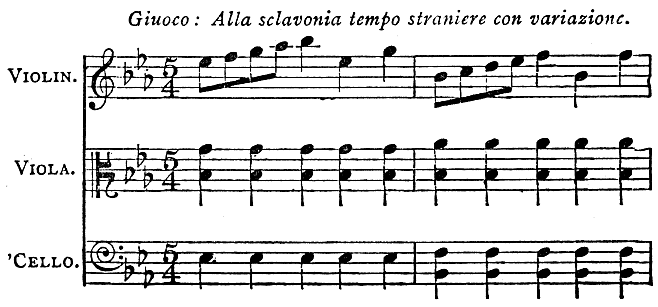
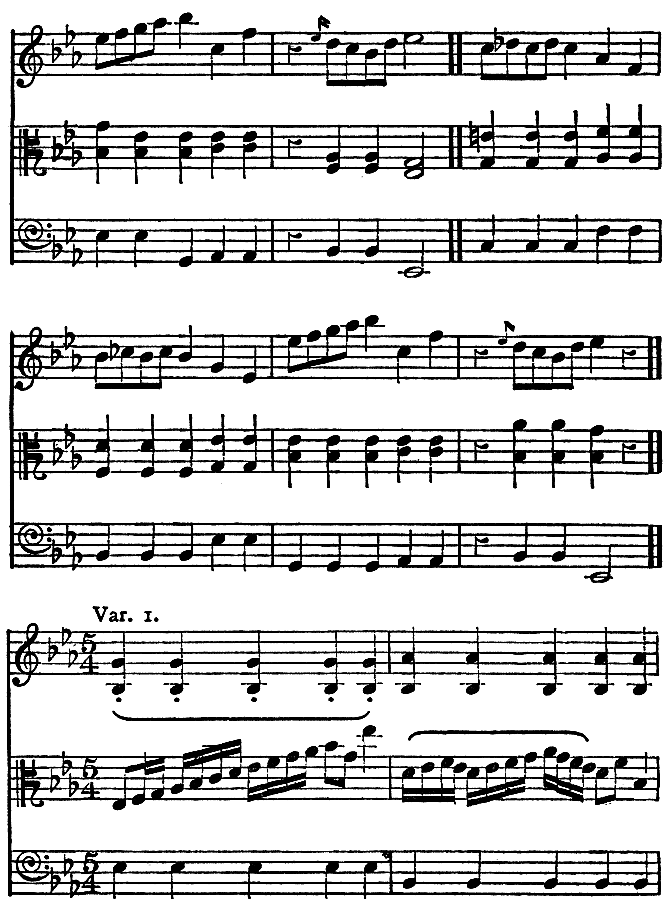
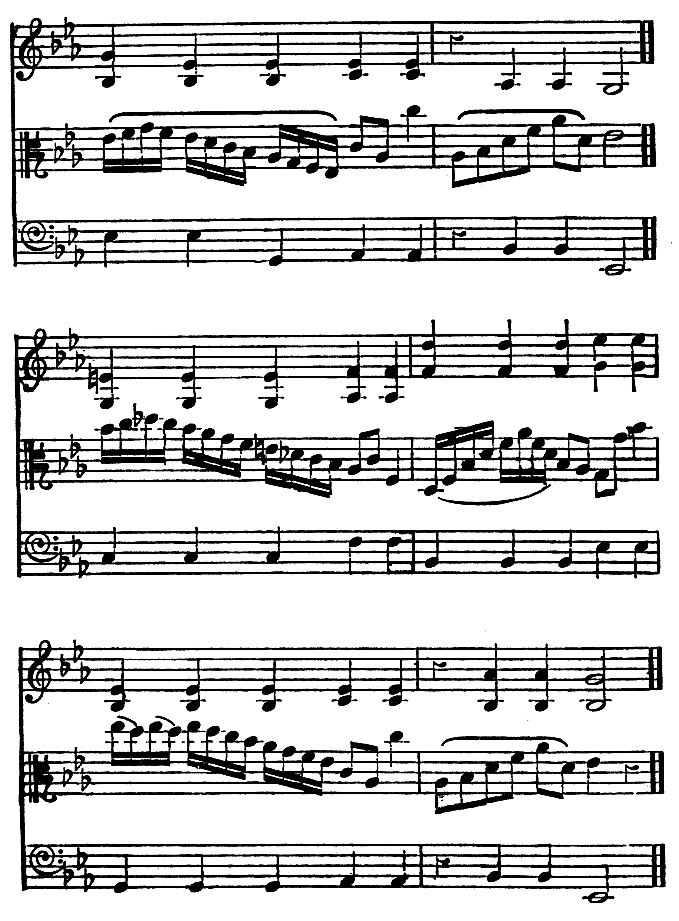
-11-
The 2nd variation has a syncopated figure in the first violin part.
The 3rd variation gives the solo part to the violoncello, and this leads to a coda concluding the movement with a repetition of the original theme.
-12-
CHAMBER MUSIC INSTITUTIONS AND CONCERTS.
John Banister’s concerts — Thomas Britton, the musical coalman — Britton’s concerts — “Music Meetings” — Oxford Music School — Pepys’s Diary — Evelyn’s Diary — Frederick the Great — Bach and the Emperor — The Emperor Frederick’s compositions — Dando concerts — John Ella and The Musical Union — Analytical programmes and position of platform — Quartett Association — Dannreuther’s Musical Evenings — Sir Charles Hallé’s recitals — Monday Popular Concerts — Joachim — Various chamber music institutions — Japanese chamber music.
With the general advancement which we thus see had taken place in instrumental music, there naturally arose a desire for its performance, and this led to the establishment of Concerts, both private and public.
Burney in his History of Music tells us that upon the decease of Baltzar the Lubecker, who was the first leader of King Charles the Second’s new Band of Twenty-four Violins, John Banister (1630-79), the first Englishman who seems to have distinguished himself on the violin, succeeded him. This musician was one of the first who established lucrative concerts in-13- London. These were advertised in the London Gazette, and in No. 742, for December 30th, 1672, there is the following advertisement:—“These are to give notice that at Mr. John Banister’s house, now called the Music School, over against the George Taverne in White Fryers, this present Monday will be music performed by excellent masters, beginning precisely at four of the clock in the afternoon, and every afternoon for the future, precisely at the same hour.”
There are a number of such advertisements, and in the Gazette of December 11th, 1676, Banister’s performance is announced to be held at the Academy in Little Lincoln’s Inn Fields, where it was to begin “with a parley of instruments composed by Mr. Banister, and performed by eminent masters.”
In Mr. North’s Memoirs of Music we have a more minute account of these performances:—“Banister having procured a large room in White Fryers near the Temple Back Gate, and erected an elevated box or gallery for the musicians, whose modesty required curtains, the rest of the room was fitted with seats and small tables, alehouse fashion. One shilling, which was the price of admission, entitled the audience to call for what they pleased! There was very good music, for Banister found means to procure the best hands in-14- London, and some voices, to assist him, and there wanted no variety, for Banister, besides playing on the violin, did wonders on the flageolet to a thro’ base, and several other masters likewise played solos.”
Banister had his first lessons from his father, who was one of the waits in the parish of St. Giles-in-the-Fields. He left behind him a son, John, who became an excellent performer on the violin, and was one of King William’s band, and also played first violin at Drury Lane when operas were first performed there.
In 1678, a year before the decease of the elder Banister, a club for the practice of chamber music, established by Thomas Britton, the celebrated small-coal man, had its beginning, and continued until 1714. Britton[7] (1651-1714) was born in Northamptonshire, and apprenticed to a London coal-dealer; he afterwards carried on business in Aylesbury Street, at the corner of Jerusalem Passage, Clerkenwell, as a small coal (probably charcoal) dealer. He seems to have been a man of progressive mind, and to have cultivated an extensive knowledge of many subjects, including both theoretical and practical music. His learning indeed seems to have led to his being regarded-15- with suspicion on the part of certain narrow-minded and superstitious people, who attributed to him even so strange a mixture as atheism, Jesuitry, and magic.

There does not, however, seem to be any foundation for the imputations which were made against him, for he appears to have been a sincere, plain man, but endowed with fine natural tastes, which raised him so far above his class that he had to pay the usual penalty for such superiority.
-16-
As a result of his study of music he established the club to which reference has been made. Here weekly concerts were held in a large room over his place of business in Clerkenwell, and these became exceedingly fashionable. The performers were drawn from among the most distinguished musicians, professional and amateur, such as Pepusch, Wollaston (the painter), John Banister, John Hughes (the poet), and Abel Whichello. It is also said that Handel frequently played the harpsichord, but the records do not entirely agree on this point. These concerts, which seem to have been due to Britton’s personal influence, together with the mutual love for bibliographical and other studies held by many of his audience, were at first free, but afterwards a subscription was levied. There appears to be no doubt that many learned and titled people, such as the Earls of Oxford, Pembroke, Winchelsea, and Sunderland, were subscribers, and that they fully appreciated and acknowledged the high conversational powers and book learning of the musical small-coal man.
Britton’s books were sold after his death, and the catalogue was issued as “The Library of Mr. Thomas Britton, small-coal man, deceased, who at his own charge kept up a consort of musick above forty years in his little cottage. Being a curious collection of-17- Books in Divinity, History, Physick, and Chimistry, in all volumes.”
His portrait by J. Wollaston, who was one of his supporters, hangs in the National Portrait Gallery in London. So recently as 1892 concerts called the Britton Concerts were given in his memory at the Hampden Club, Phœnix Street, St. Pancras, London.[8]
About the year 1680 the principal music-masters in London, perceiving an eagerness in the public for musical performances, caused a room to be erected in York Buildings and purposely fitted up for concerts, where the best compositions and performers of the time were to be heard. This was called the “music meeting,” and this room was for a long time the place where the lovers of music assembled at the benefit concerts of the most eminent professors of the art.
As regards the provinces, in 1665 a music school was founded at Oxford by the members of the old Oxford meetings which were suppressed during the Rebellion. Anthony Wood speaks of these meetings when King Charles was driven to Oxford. This new (1665) school, it is quaintly recorded, was furnished “with a number of instruments, including an organ of four stopps, and-18- seven desks to lay the books on, at two shillings each.” Subscription concerts were given, and these Oxford gatherings were the first of which any account is to be met with, indeed they seem to have been the only association of the kind in the kingdom. (Hawkins, History of Music.)
For the common and ordinary people there were entertainments suited to their notions of music; these consisted of concerts in unison, as they were called, of fiddles, hautboys, trumpets, etc., performed in booths at fairs held in and about London, but more frequently in certain places called music-houses, of which there were many in the time of King Charles II.
Among the first of this kind was one known by the sign of the Mitre near the west end of St. Paul’s Cathedral. This was about the year 1664. The name of the master of this house was Robert Hubert, alias Forges, who besides being a musician was a collector of natural curiosities.
Another well-known place of this kind was in Stepney, where there was an organ and a band of fiddles and hautboys, and here at times dancing was allowed.
As quaintly casting light on the musical condition of things during this period, the following extracts from Pepys’s Diary may be given:—
“Oct. 1, 1667. To White Hall: and there in the-19- Boarded Gallery did hear the musick with which the King is presented this night by Monsieur Grebus, the master of His musick; both instrumental (I think twenty-four viols.) and vocall; an English song upon Peace. But God forgive me! I never was so little pleased with a concert of musick in my life. The manner of setting words and repeating them out of order and that with a number of voices, makes me sick, the whole design of vocall musick being lost by it. Here was a great press of people, but I did not see many pleased with it, only the instrumental musick he had brought by practice to play very just.”
“Febry. 27, 1668. With my wife to the King’s House to see The Virgin Martyr, the first time it hath been acted a great while; and it is mighty pleasant; not that the play is worth much, but it is freely acted by Beck Marshall. But that which did please me beyond anything in the whole world was the wind-musique when the angel comes down; which is so sweet that it ravished me and indeed, in a word, did wrap up my soul so that it made me really sick, just as I have been formerly when in love with my wife; that neither then nor all the evening going home and at home I was able to think of anything, but remained all night transported, so as I could not believe that ever any musique hath-20- that real command over the soul of a man as this did upon me; and makes me resolve to practice wind-musique, and to make my wife do the like.”
In Evelyn’s Diary of November 20th, 1679, we find the following:—“I dined with Mr. Slingsby, Master of the Mint, with my wife invited to hear musick which was exquisitely performed by foure of the most-renown’d masters: Du Prue, a Frenchman, on the Lute; Signor Bartholomeo, an Italian, on the Harpsichord; Nicolao, on the violin; but above all for its sweetnesse and novelty, the Viol d’amore of five wyre strings plaied on with a bow, being but an ordinary violin played on, lyre-way, by a German. There was also a Flute-douce, now in much request for accompanying the voice. Mr. Slingsby, whose sonn and daughter play’d skilfully, had these meetings frequently in his house.”
In Hawkins’s History under the date November 23rd, 1685, we find a copy of an advertisement of the publication of several sonatas “composed after the Italian way, for one and for two Bass Viols with a thorough Bass, by Mr. August Keenell,” and of their being performed at the Dancing School, Walbrook. Also at the school in York Buildings, some performances on an instrument called the Baritone by the same Mr. Keenell. Again on January 25th, 1693, it is stated that “at the-21- Concert room in York Buildings will be performed Mr. Purcell’s Song composed for St. Cecilia’s day in the year 1692, together with some other compositions of his, both instrumental and vocal, for the Entertainment of His Highness Prince Lewis of Baden.”
Other institutions such as the Academy of Ancient Music, established in 1710, The Anacreontic Society (about 1770), the Ancient Concerts (about 1776) did much for the cultivation of good music, but they were not specially concerned with chamber music.
Of foreign doings, Hawkins relates that in 1598 “upon the arrival of Margaret Queen of Austria at Ferrara to celebrate a double marriage, between herself and Philip III. of Spain, and between Archduke Albert and the Infanta Isabella, the King’s sister, at the monastery of St. Vite the nuns performed a concert in which were heard Lutes, Double Harps, Viols, and other kinds of instruments.” Also in an Italian work of this period called Il Desiderio there occurs a long dialogue on the concerts which were then the entertainment of persons of the first rank in the principal cities of Italy, particularly Venice and Ferrara. The Accademia degli Filarmonica, an important Italian institution, was begun at Vicenza, exactly when is not now known, but certainly before 1565, for in that year the Accademia degli Incantenati was incorporated with it.-22- To this “the nobility and gentry were used to resort once a week to entertain themselves with music.”
Brahms is reported to have said, “Be careful how you speak of the music of princes. One never knows who may have written it.” But even with this note of warning in mind, the story of the Emperor Frederick the Great of Prussia can hardly be passed over, seeing how influential must have been the support which he accorded to the art and to his musicians—Quantz, who composed so many works for the flute (the Emperor’s beloved instrument); C.H. Graun, the conductor; J.G. Graun, the violinist; and especially Philipp Emanuel Bach, a son of the great John Sebastian. The Emperor was accustomed to spend some £7000 a year on his Court music, which shows that it was an affair of considerable importance.
A pleasant and interesting account is recorded of the meeting of J.S. Bach with the Emperor. It was on a Sunday evening in the spring of 1747, as the Emperor was about to open his concert with a flute solo, the stranger’s list was brought to him. Having read it, flute in hand, he turned to the band and said excitedly, “Gentlemen, old Bach is come.” The flute was laid aside, and Bach was sent for at once, no time being allowed him even to change his travelling dress. The-23- elaborately formal greetings over, Bach was invited to try the numerous Silbermann pianos distributed through the palace, the band following from room to room as he tried each instrument. Frederick expressed a desire to hear a six-part fugue, which Bach then improvised with the utmost skill on a theme given to him by the King. Next day, wishing to hear him on his more congenial instrument, the King escorted Bach to all the organs in Potsdam.
One outcome of this visit was the so-called “Musical Offering” which Bach wrote on his return to Leipzig. It consists of an elaborate working out of the royal theme named above, and the work is dedicated to the Emperor.[9]
It is said that the Emperor’s chamber concerts were dominated by himself and his flute, for virtually the only music performed was that of Frederick himself and his master, Quantz. Artistically there does not seem much to commend in this, and indeed, if accurately recorded, it raises serious doubts of the Emperor’s musicianship. But nevertheless the compositions which this remarkable man left behind him are of a kind to make one pause before accepting such a view of the matter, for at the command of the present German Emperor, and under the editorship of such eminent-24- musical authorities as Spitta, Count Waldersee, and Barge, four volumes of these compositions have been published. They consist of twenty-five sonatas for flute and piano, and four concertos for flute and stringed orchestra.
“An examination of the King’s musical MSS., made at the instance of the Minister of Education, has shown that the compositions, written entirely by the King himself, are not only of historical interest, but exhibit command of artistic form and talent for musical invention; a healthy musical life breathes through them; the slow pieces frequently surprise us by their beautiful melodies full of warm feeling, and by their brilliant passages. Such fervour inspires them that the publication of these noble works, which solaced the monarch amid the troubles of his country and in his old age, in the loneliness of his high office, will present the personality of the great King in a new and important aspect. The notion that Frederick merely sought an agreeable pastime in flute-playing will be removed by this edition of his works; his admirers will learn to see in old Fritz a creative musician of deep feeling and noble simplicity.”[10]
-25-
The following fragment, which is quoted from the slow movement (Grave) of the Emperor’s Third Concerto, will show better than any mere description the quality of his music, which certainly warrants the expressions given below from Professor Spitta’s preface to the edition referred to above:—
From the 3rd Concerto for Flute and Strings.
Frederick the Great.
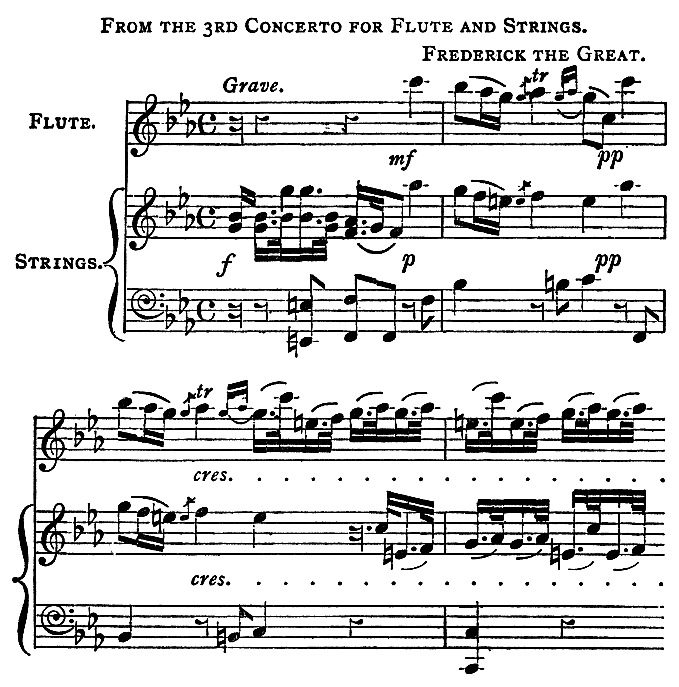
-26-
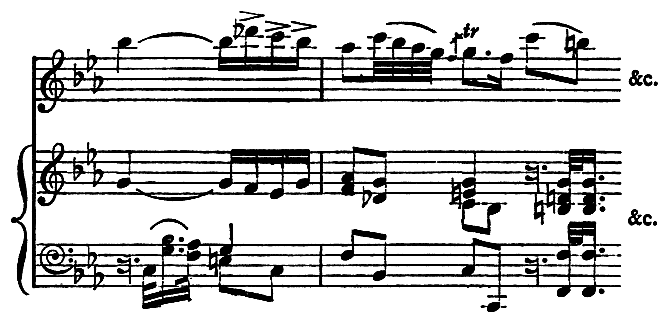
“The form of the music is no doubt like that of his master Quantz, unoriginal and stereotyped, but his specialty lies in the simple musical thoughts, which flow freely and easily from him, as the natural adequate expression of inward emotions. Frederick’s musical personality is most clearly delineated in his Adagios. These compositions furnish the proof of the story that he often moved his hearers to tears by his adagio playing. They reveal a surprising tenderness of feeling, a soul which seeks its satisfaction in the sweet melancholy and tender, almost feminine, yet never effeminate plaintiveness. The lovely Siciliani of Sonatas 3, 16, and 25 charm like Watteau pictures, with their graceful figures and delicate colour harmony, at the same time not lacking German depth of feeling. More serious, darker feelings rise up in the Grave of the Third-27- Concerto.... Certain it is, and remains, that his music affords the hearer deep insight into a unique soul-life, and for this reason alone its publication would be justified.”
In the year 1836 a series of Quartett Concerts were organised by Joseph Dando, a London violin professor. These concerts, which were continued until 1842, were held in the Hanover Square Rooms, and the artists associated with Dando were Henry Blagrove, Henry Gattie, and Charles Lucas. Dando is said to have been the first to introduce public performances consisting altogether of instrumental quartetts in London.
In 1845 a series of Morning Concerts for chamber music, under the title of “The Musical Union,” were commenced in London by John Ella (1802-88), a Yorkshireman, who, originally intended for the legal profession, became a violinist, and established himself in the metropolis. These concerts continued for some thirty-three years. In the year 1850 Ella also started another series under the title of “Musical Winter Evenings,” and they went on until 1859. At these concerts the best chamber music was performed by the leading artists, both English and foreign.
The Musical Union is said to have had its origin-28- in chamber music meetings which were held at Mr. Ella’s residence in London, and it would be difficult to over-estimate the important influence which its doings have had on the taste for high-class music of this kind in England. To Mr. Ella is also due the introduction of analytical Programmes, which were unknown before. These were sent to the subscribers some days before the concerts, thus enabling all earnest students to acquaint themselves with the various points of interest in the works to be performed.
Another feature which is worthy of notice was that the Platform for the performers was placed in the centre of the concert hall (St. James’s Hall, Regent Street). It was a little raised from the floor, and the listeners sat in a circle around it. This custom has been recently (1901-2) revived at the concerts given by the Joachim Quartett, with, however, the somewhat serious difference that the platform is much too high, and this interferes with the comfort of those who are seated near to it. At the Musical Union Concerts of Mr. Ella the platform was much lower, and this worked well.
Another effort for the spread of a knowledge of chamber music was started in London in the year-29- 1852 by Messrs. Sainton, Cooper, Hill, and Piatti. It was called the Quartett Association. Six concerts each season were given, at which the most eminent artists performed. These were held at Willis’s Rooms, but after the third season they were abandoned for want of sufficient public support.
Among a number of other attempts of a like kind may be mentioned Mr. Edward Dannreuther’s Musical Evenings, which upheld a high ideal, for it is well known that Mr. Dannreuther, while an earnest apostle of the new school of music, is no less zealous for the old, as the range of the programmes which he set forth at these concerts, and his masterly interpretations of Bach and Beethoven, abundantly prove.
The late Sir Charles Hallé (then Mr. Hallé) began in 1861 his celebrated Chamber Music Recitals, the first eight concerts being taken up with a presentation of the whole of the Piano Sonatas of Beethoven. There can be no doubt that these recitals, along with Hallé’s musical work in other directions, have had a most beneficial effect on our national taste.
No account of British chamber music would be complete without a notice of the Monday Popular-30- Concerts which were commenced in London in 1859. The first concerts were of a miscellaneous character, consisting of old ballads and well-known instrumental pieces. They had, however, but moderate success. The director, Mr. Arthur Chappell, in conference with Mr. J.W. Davison, the musical critic of The Times newspaper, then decided to try a series of good chamber music concerts. The first of these was announced as a Mendelssohn Night, and was, of course, made up entirely of chamber music by that composer; and afterwards a Mozart, Haydn, Weber, and a Beethoven night were severally tried. Still success did not follow, and the concerts were very nearly abandoned. Chiefly, however, owing to the determination of Mr. Chappell, a further series were tried, and as these produced a financial profit, the venture was continued, with the result that the concerts eventually became firmly established as the leading chamber music institution in England.

“The One-hundredth Popular Concert,” says Mr. Hueffer,[11] “was given on July 7th, 1862, when, according to The Times, more than one thousand persons were refused admission for the want of space—a statement in itself sufficient to show the broad popular basis-31- on which the concerts were by that time founded. In 1865 the Saturday Afternoon Concerts were added to those given on Monday evenings, and on May 15th of the same year one of the most important events in the history of this institution—the first appearance of Madame Schumann—took place. The programme on that occasion was devoted entirely to the works of her husband, which, in those days, were thought by the public and the press to be the abstruse effusions of the modern spirit, but which are now as generally, and almost as highly appreciated as those of Beethoven himself. Five years later, in 1870, Madame Norman-Neruda was added to the list of executants, and has remained one of the prime favourites of these and English audiences generally, ever since. In the season of 1873-74 more than common attention was paid to contemporary talent, the names of Saint-Saëns, Rubinstein, Rheinberger, Raff, and other then living composers playing a prominent part. The cause of this inroad upon established tradition is partly to be found in the appearance at the piano of Dr. Hans von Bülow, who, here as everywhere else, exercised a beneficial, but, so far as the popular concerts were concerned, a passing influence. There are few names of eminence absent-32- from the list of executants who have appeared on and off. The one-thousandth performance was given on April 4th, 1888.”
Among the other artists who constantly played at the “Monday Pops.” were Piatti, who for very many years occupied the position of leading ’cellist, and his brother-artist of world-wide repute, Dr. Joseph Joachim, the violinist. Although Joachim’s connection with the art of music is by no means limited to any one branch, yet it is in the realm of chamber music that we have chiefly felt his strong influence in Great Britain, and as an upholder of a high and pure standard of musical taste he obtains without doubt the grateful adhesion of all the serious musicians of our land. Were it for no other reason than his steadfast advocacy of the high claims of the works of Johannes Brahms, and for his presentation, under those conditions of a faultless rendering which they imperiously demand, of the later Quartetts of Beethoven, we, and the entire musical world, owe him a deep debt of gratitude.
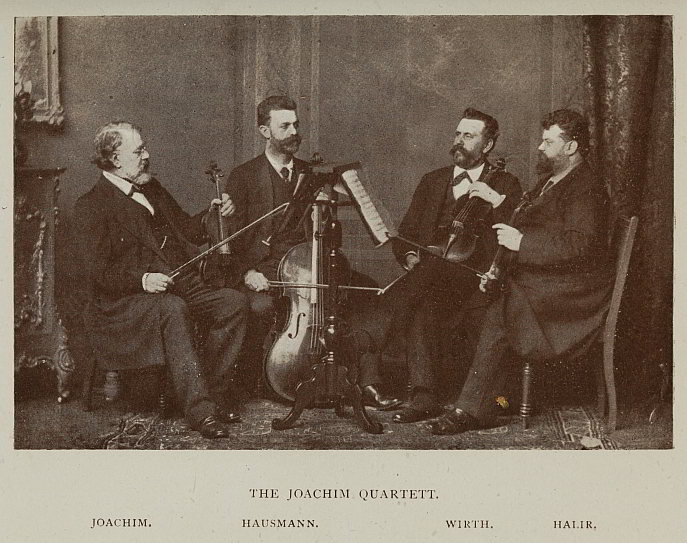
Of course it is obvious that to call these concerts Monday Popular Concerts was, at the commencement, almost a jocose perversion of the facts, seeing that they were so badly attended; yet, as some one afterwards said, “Mr. Chappell (when the concerts at first-33- proved unpopular) took a bolder course than to alter his title; he altered the public taste instead,” and thus the name became an entirely appropriate one. That these concerts should, during recent years, have declined in public interest is a matter for regret, but no doubt a variety of causes has contributed to this result. Among these must be reckoned the competition of orchestral performances, for which there has grown up a strong public taste; the neglect in the Monday Popular programmes of the newer and novel compositions; and the death or absence of some of the most distinguished chamber music performers. At the same time it is hardly to be believed that chamber music concerts will be allowed to die out, and there is indeed already strong evidence of a revival in this direction in London, which shows that this, the purest form of abstract music, is still held in high esteem amongst us.
Other British chamber music institutions which should be mentioned are the Cambridge University Musical Society (1843), the Cambridge University Musical Club (1871), the Oxford University Musical Union (1884), the People’s Concert Society (1878), the concerts at South Place, Finsbury, where reigns a specially eclectic taste, and good annotated-34- programmes are provided; and the flourishing Oxford and Cambridge Universities Musical Club, established, largely by the untiring efforts of Dr. Horace Abel, during the year 1900 in the old Sir Joshua Reynolds’s House, Leicester Square, London; also the Schulz-Curtius Concerts.
During the season 1902-3 a new series of important chamber music concerts were inaugurated by Messrs. J. Broadwood & Sons, the well-known pianoforte makers, at St. James’s Hall, London. The original prospectus announced the following artistes, most of whom have appeared:—The Bohemian Quartett, the London Trio (Miss Amina Goodwin, Messrs. Simonetti and Whitehouse), the Wessely Quartett, Mr. Clinton’s Wind Instrument Quartett (Messrs. G.A. Clinton, W.M. Malsch, A. Borsdorf, and T. Wotton), the Grimson Quartett, the Brodsky Quartett (Messrs. Adolph Brodsky, R. Briggs, S. Speelman, and C. Fuchs), and the Gompertz Quartett (Messrs. Rd. Gompertz, C. Jacoby, E. Kreuz, and J. Renard). The Kneisel (American) Quartett and the Moscow Trio have also recently been heard at these concerts. Messrs. Broadwood have also organised another series of chamber music concerts in the city of Manchester.
The direction of the Monday Popular Concerts has-35- also been undertaken by Professor Johann Kruse, who was well known as a member of Dr. Joachim’s Berlin Quartett. The Joachim Chamber Concerts will also be continued, the artists, as before, being Messrs. Joachim, Halir, Wirth, and Hausmann. Mr. Willy Hess’s Quartett, the Newland Smith Trio, Messrs. Metzler’s concerts, the Mozart Society’s concerts, and those of Mr. Donald Tovey (which are of high importance), are among the Chamber Music Institutions that have recently come into notice.
In many of our provincial towns and cities, too, societies for the cultivation of chamber music are, in a quiet way, doing excellent work. These are too numerous to set forth in detail; but, as exemplifying the good influence which it, like many such institutions in other places, has for a long time exerted, the Chamber Music Society of Newcastle-on-Tyne may be mentioned. This Society a while ago set an example, which might well be followed by others, in commissioning our English composer, Villiers Stanford, to write a string Quartett (op. 44 in G major), which was performed at one of the Society’s concerts shortly after it appeared.
It has been stated by a writer,[12] who, by the way, is not afraid boldly to declare the truth “that the amateur is the backbone of a nation’s music”—that a Chamber-36- Music Society has been founded through the influence of an English amateur at Tokio, in Japan. He tells us that the violinist who leads at these concerts has been engaged by the Japanese Government to teach at the Tokio Conservatoire, and that he has already turned out some excellent Japanese pupils, at any rate so far as technique is concerned, one girl especially having become a really good viola player.
-37-
HAYDN, P.E. BACH, DITTERSDORF, HANDEL.
J.S. Bach — Joseph Haydn — Philipp E. Bach — Dittersdorf — Early quartetts of Haydn, Mozart, and Beethoven — Silence as an effect in music — Haydn’s quartetts — Haydn’s Kaiser Quartett — Haydn’s other chamber music — Handel.
Haydn (1732-1809) has been called the “Father of the Symphony,” and by some the origin of the Quartett (meaning, of course, that for strings) has been ascribed to him.
How far this is accurate can only be determined by an examination of what was being done by others about the same time; but it may be safely said that, in the absolute sense, no enduring art form has been the creation of one man. There has always been a growth, although it is no doubt true that at a certain stage of the process some one with genius has, as it were, put the top stone on the edifice. Robert Schumann, writing on this topic, uses the following characteristic words:—“The world is large. Be modest! You have not yet discovered and contrived what others before you have-38- not already imagined and found out;” the meaning of which doubtless is that of absolute originality there is very little at any time, and what stands in its place (and this will seem more or less according to our knowledge or ignorance of what has already been done) is really the fruition of many past influences, plus the genius of the man who assimilates and gives them fresh shape.
John Sebastian Bach (1685-1750) was probably the most original genius the art of music has known, but it would be idle to deny that he was deeply indebted to his predecessors, Frescobaldi, Buxtehude, Klemme, and Pachelbel.
Take, for example, the history of what now goes under the name of Programme Music. What Liszt aimed at in his Symphonic Poems, and what Richard Strauss’s remarkable creations—“Don Juan,” “Till Eulenspiegel,” “Ein Heldenleben,” and the rest, attempt to express, was already in the minds of composers a very long while ago.
Mr. Corder, in his article on this subject in Grove’s Dictionary, states that W. Byrd (1560) wrote a battle-piece for Virginals, and John Mundy, another English composer of that period, published a so-called “Fantasia on the Weather,” professing to depict fair weather, lightning, thunder, etc. Krieger (1667) gives us a four-part-39- vocal fugue entirely made up of an imitation of the mewing of cats! There is also the fairly well-known Cat’s Fugue by Domenico Scarlatti, suggested of course by his cat accidentally walking over the keys of his harpsichord. Bach, Handel, Haydn, and Beethoven are also among the great ones whose works occasionally tended in a like direction.
It is the same with any other distinctive feature in music, and therefore, while undoubtedly Haydn did very much for its expansion, the truth is that the form of the String Quartett was a gradual development, and not the creation of any single mind.
As to the vitality of the music of different composers, which is another matter, Boccherini, a contemporary of Haydn, wrote more quartetts than that master, and they were highly esteemed during his life-time; but, save the musical student, who knows or plays them to-day?
Haydn is known to have studied, early in life, the works of Philipp Emanuel Bach (1714-88), and there can be little doubt that he was thereby strongly influenced. Beethoven is said to have been quite familiar with the greater (John Sebastian) Bach’s compositions, even as a child, and an argument has been based on this that Haydn’s artistic position would to-day have been different had-40- he, too, studied the greater and not the lesser Bach.
The following extracts from a String Quartett by this composer, P.E. Bach, which was found in the Library of the Thomas-Schule in Leipzig, will convey, perhaps better than any mere words, an idea of the style in which he wrote, and we will thereby see what it was that influenced Haydn.
The Finale Presto may specially be noted, presenting as it does features remarkably like many such movements in Haydn’s Quartetts.
From the 1st Movement of a String Quartett by Philipp Emanuel Bach.
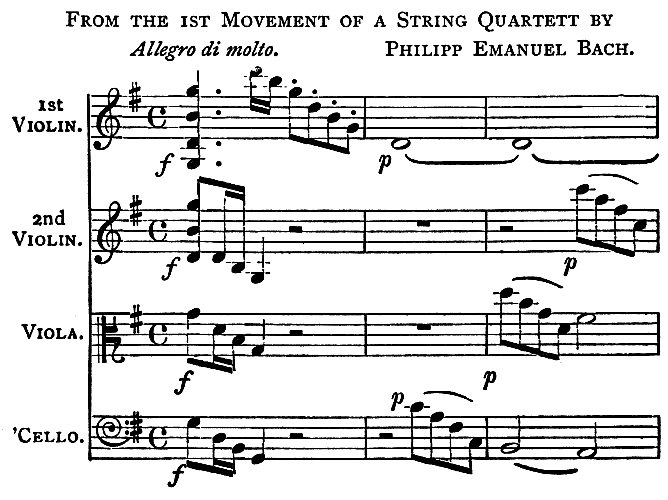
-41-

The first movement of this work, which has also been called a Sinfonia, is connected with the second by modulation.
2nd Movement.
(The commencement.)
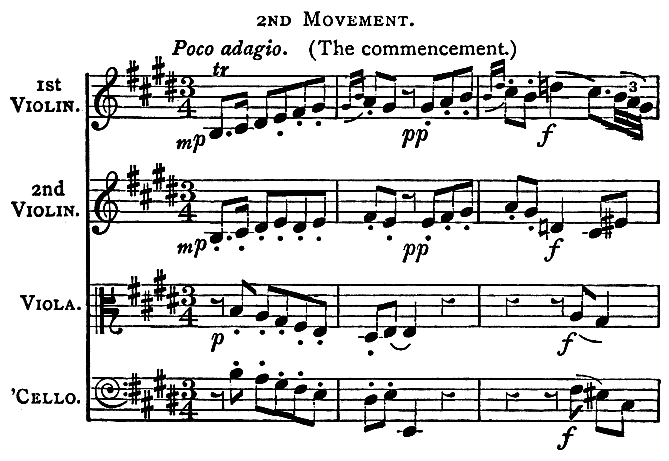
-42-
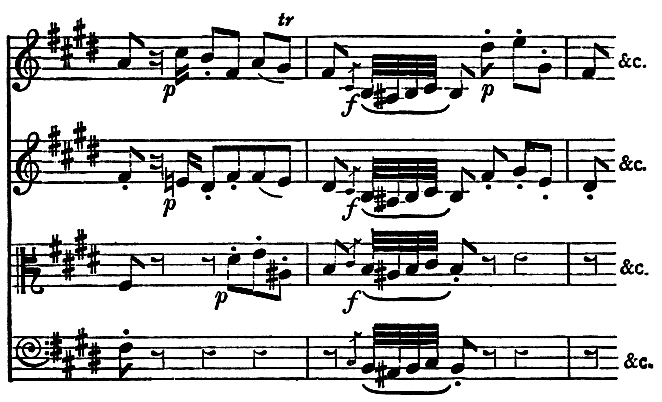
(The last 10 bars, leading to the Presto.)
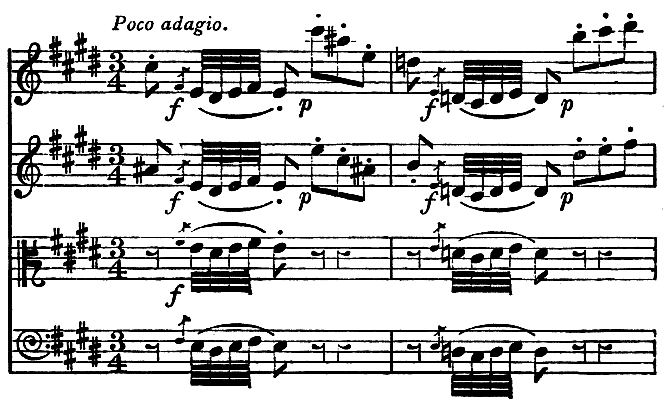
-43-

-44-
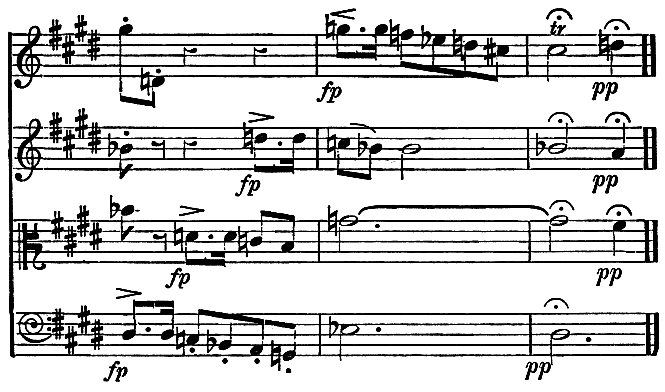
The orchestral tendencies of this work and its symphonic feeling are, of course, quite evident; but Dr. Hugo Riemann, in his recently published edition, entitles it a String Quartett.
3rd Movement.
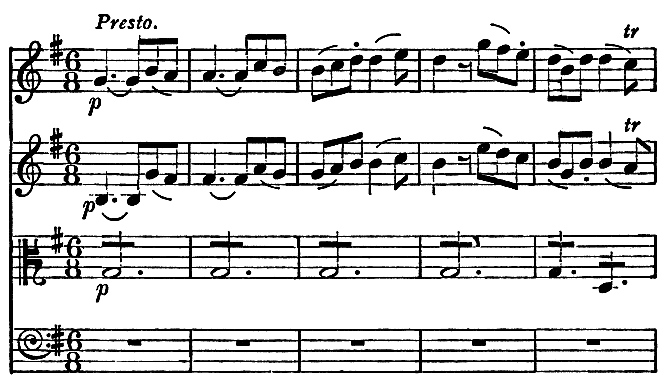
-45-
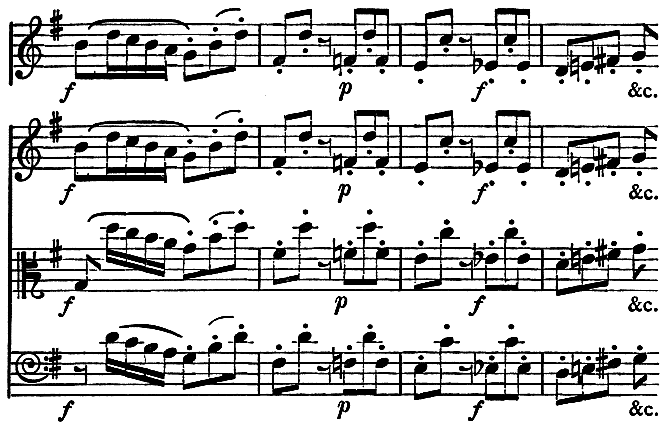
Dittersdorf (1739-99) is another chamber music composer of this period. His name is little known in England, but during his life-time he was regarded as a rival of Haydn, and although the verdict of time is against him, yet his compositions go far to justify the popular feeling in his favour. An opera of his, The Doctor and the Apothecary, still holds the stage in Germany, and his String Quartetts are yet occasionally heard. His twelve Orchestral Symphonies (most of them written to a programme), oratorios, and some twenty to thirty other operas are, however, now practically dead. The scores of six of his Quartetts, which are published in the Payne miniature-46- edition, are worthy of attention, especially that in E♭, from which the following quotations are made. Special attention may be directed to the minuet, which is followed by a trio or alternativo of a very charming and dainty character. The lively finale too reminds one of Haydn, and the effect of silence, which is mentioned elsewhere, is introduced in several places in this movement. While, however, the music is spontaneous and sincere in feeling, the absence of strong ideas and of contrapuntal skill soon shows itself, and the effect tends to become insipid.
From a String Quartett by Carl Ditters von Dittersdorf.
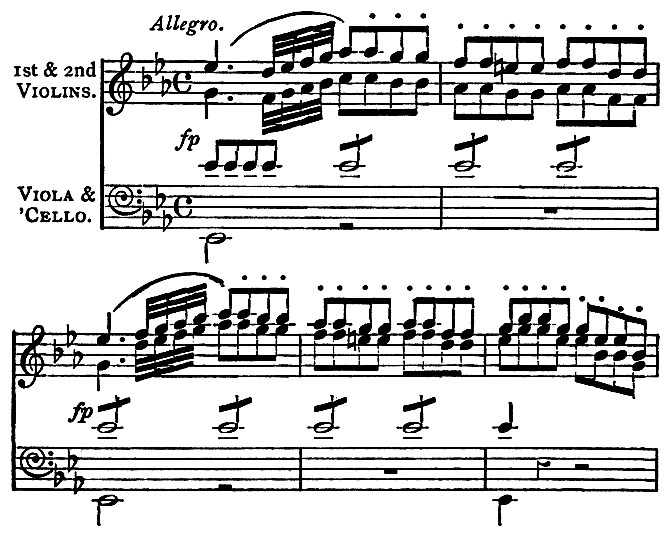
-47-

A noteworthy feature in the development portion of this movement is a sudden but effective modulation from E♭ to C major.
Minuetto.
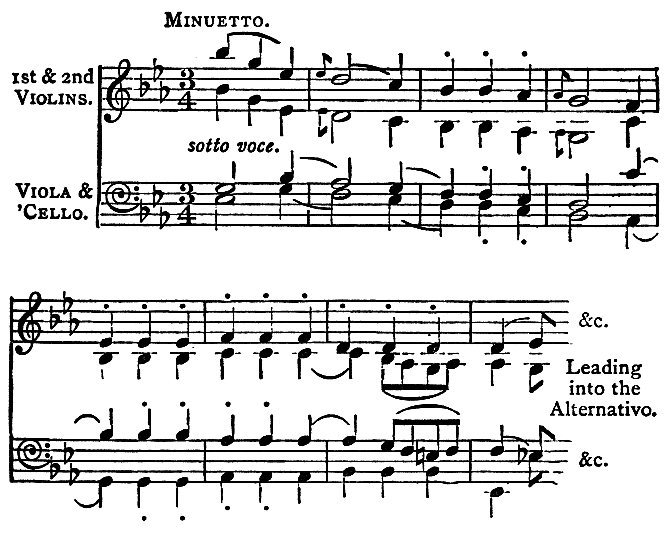
Leading into the Alternativo.
-48-
Alternativo.

Some editions of this quartett have three bars of the note G for the ’cello, after the double bar, instead of two, as here printed.

-49-
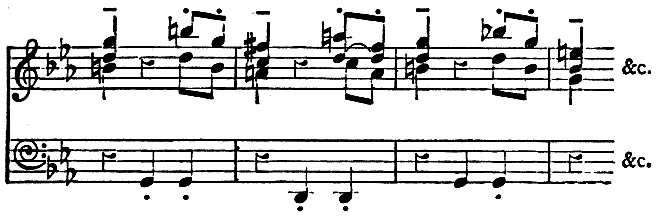
Finale.
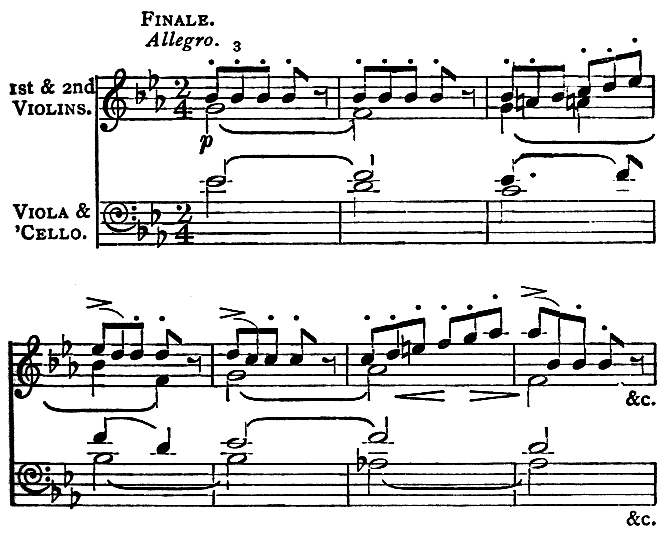
Haydn wrote his first String Quartett about the year 1755. Mozart’s first appeared fifteen years later, in 1770. That of Beethoven (No. 1 in F, op. 18) in 1800;-50- so that a period of about forty-five years includes all three. A comparison of the three works can therefore hardly fail to be of interest. Haydn’s consists of five movements—viz., presto, minuet and trio, adagio, another minuet and trio, and presto. All the movements are in the key of B♭, except the adagio, which is in E♭. They are short and undeveloped, and there is little extraneous modulation. The music is fresh and spontaneous, but simple and of little importance—indeed, as compared with many of his other seventy-six Quartetts, it is trivial.
Mozart’s work is in G major. It has four movements—viz., adagio, allegro, minuet and trio, and rondo. Originally it had only three movements, the rondo being added later. All are, in accordance with the custom which prevailed up to about this time, in one key. The general character of the composition is stronger than that of Haydn, there is more counterpoint and independence in the parts, but not much modulation. It is an interesting, but by no means great work.
Beethoven’s is the well-known No. 1, op. 18, and has four movements—viz., allegro, adagio, scherzo and trio, and allegro. The introduction of the scherzo form will be observed here. Humour and jest had no doubt been attempted before in music, but Beethoven-51- made much more use of it than his predecessors, and in some of his works, notably the Fifth and Ninth Symphonies, employed it in a remarkable manner. In the C minor, the grim humour, with the strange touch of mysticism which occurs near to where the scherzo blends into the finale, are among the very great effects which Beethoven has left for us. All the movements of the quartett are in the key of F, save the adagio, which is in D minor. Both as to contrapuntal skill, modulation, individual use of each instrument, especially of the viola, and above all in poetic feeling, this work shows a great advance on the two of Haydn and Mozart. Beethoven no doubt had the great advantage of what Haydn and Mozart had already written, but for all this the gap between this first Quartett and theirs is remarkable. Unquestionably the best of Haydn’s and Mozart’s Quartetts are works of the highest genius, but in Beethoven the restraint of conventional form is less felt, and there is a richer and fuller poetic expression. Nor has Beethoven overlooked (we find it in bars 59 to 62 of the adagio) the use of a certain negative means which as a factor in musical expression is of great importance.-52- Just as it is well not to write continually in full four-part harmony, but to relieve what is apt to become monotonous, by reducing the score to three, two, or even at times one instrument, so the introduction of absolute silence may occasionally produce an excellent effect. Handel recognised this, and we find examples in “He rebuked the Red Sea” (Israel in Egypt), “Wretched Lovers” (Acis and Galatea), and at the close of the Amen Chorus (Messiah). Brahms makes use of the device in the allegretto of his Second Symphony, as does another master, Wagner, at the close of the prelude, Act 2 of Parsifal. The scherzo of Beethoven’s Ninth Symphony also contains several examples, and Sir C. Villiers Stanford in the andante of his String Quartett, op. 45, produces a strikingly artistic effect, where after a full bar’s silence, the viola enters alone on a note unrelated to the previous tonality. Of course the use of a means of this kind obviously depends upon the character and feeling of the music, and its absence in no way implies imperfection, but it is curious to note that neither Schumann, Mendelssohn, nor Brahms introduces it into any of their String Quartetts.[13]
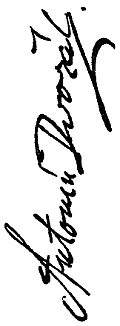
-53-
The bulk of Haydn’s Quartetts are so well known that any detailed reference to them would be superfluous. Op. 33, No. 3, in C major; op. 74, No. 1, in the same key; and op. 77, No. 2, in F major, may however be named as among the most interesting, and not perhaps so often played as, say, the so-called “Kaiser,” op. 76, No. 3, the op. 64, No. 5, and the op. 76, No. 1, which with some others are so justly held in high esteem wherever this style of music is cultivated.
With regard to the slow movement of the “Kaiser,” a set of variations on the Austrian National Anthem, which Haydn is said to have composed because he envied the English their “God Save the King,” Mr. W.H. Hadow, in his book A Croatian Composer (which work may well be read, containing as it does a report of some very interesting investigations), gives a number of instances wherein the germ of symphonic and other of Haydn’s musical themes are traceable to Croatian folk-songs, and among them is this Austrian National Anthem. What Handel did with the works of Steffani and others is pretty well known by musicians, but this less known case is an equally interesting one.
Here is the familiar melody as it now stands in the Quartett (op. 76, No. 3) referred to. The five versions-54- of this melody which by the praiseworthy investigations of Mr. Hadow are now brought to light are quoted below. Each one presents the tune as it is found to-day in a certain district of Croatia. It will, as Mr. Hadow points out, be seen that in all these versions there is “apparent the same touch of inspiration, and the same weakness of development.” Haydn took advantage of-56- the inspiration and dignified the tune by a continuation worthy to make it take rank among the best national anthems of the world.
From Haydn’s Kaiser Quartett, Op. 76, No. 3.

No. 1

No. 2.

No. 3.

These three are of course very much alike, but the next two differ considerably from the others, and No. 5 has two bars more than No. 4.
No. 4.

No. 5.

Haydn’s compositions in the chamber music style embrace a large number of pieces which are now forgotten. Many of these were probably written to order for his patrons, and have little permanent value. Among them are some 32 Trios for strings and other combinations, 2 for 2 flutes and ’cello, 3 for piano, flute, and ’cello, and some 35 for piano, violin, and ’cello. As regards the last-named, some of which are still occasionally played, an examination of the twelve published in the Peters Edition, which may be regarded as favourable specimens, shows that many of them are hardly trios at all in the modern sense of that word. The ’cello part, generally speaking, either doubles the actual notes, or strengthens the harmony, of the left-hand piano part, and in some movements (e.g. the slow movement of No. 1 in G major) has not a single independent passage. There would, indeed, be little loss of effect if the music were played by the piano and violin.
There is more interest and vitality in No. 6 in D major, but even in this the continual doubling of the parts, and want of independence between the instruments,-57- becomes at last somewhat wearisome. It ought, however, to be remembered that some of these Trios were published as Sonatas for the piano with an accompaniment for violin and ’cello, and that this kind of composition was common during the period of which we speak. It has also been stated that Haydn wrote these Trios for a wealthy and enthusiastic patron, who unfortunately was a poor ’cello player, and hence that part was written in the simplest form.
Haydn also wrote about 175 works for an instrument called the baryton, a kind of viol da gamba. They were written for Prince Esterhazy, who played that instrument, but they are now practically forgotten. Some unpublished MSS. of Haydn’s are to be found in the library of the British Museum.[14] There are also, among his published works, four Sonatas for violin and clavier, and six Duets for violin and viola, as well as a number of other chamber music compositions, which, however, have no great musical value.
The following is a list of the chief chamber music works of Handel (1685-1759):—
The Sonata in A major for violin and piano (harpsichord) is of course familiar, as are others of the fifteen named above. The Trios are also of high interest, some of the slow movements being distinguished by that fine pathos which is associated with the best work of the composer of The Messiah. This music deserves more attention than has hitherto been accorded to it.
-59-
MOZART.
Mozart’s C major Quartett — Mozart’s string quartetts — The genius of Mozart — Mozart’s other chamber music — Wagner on Mozart — Mozart’s letter to his father.
“I declare to you before God, as a man of honour, that your son is the greatest composer that I know either personally or by reputation; he has taste, and, beyond that, the most consummate knowledge of the art of composition.”
Such are the remarkable words of Haydn, spoken to Mozart’s father. The compositions played on the occasion when this was said were the String Quartetts numbers 458, 464, and 465 of the Köchel Thematic Catalogue of Mozart’s works, the last-named in C major, being that whose introductory passage is said to have given much offence to the purists of that time, on account of the following unusual harmony, which even to-day sounds (like some of Bach’s) quite modern:—
-60-
Mozart.
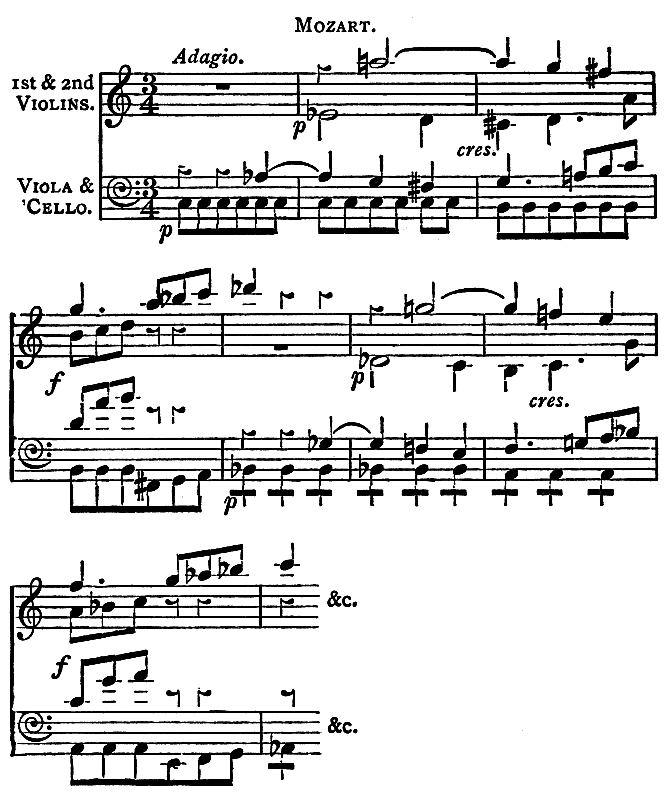
The celebrated Italian musician, Sarti, the master of Cherubini, said of this passage, “Can more be done to put the players out of tune?” and some, even of-61- Mozart’s admirers, after his death, proposed to alter and, as they considered it, rectify the passage. As regards Sarti, there can be no doubt that his word carried great weight at that time, and although his views may now be lightly regarded, Mozart evidently had a high opinion of him, for, in a letter written from Vienna in June 1784, we find him writing, “To-morrow there is to be a concert at Herr Players, at Döbling, in the country. Mdlle. Babette will play my new Concerto, I shall play in the Quintett, and together we shall give the Grand Sonata for two pianos. If the Maestro Sarti had not been obliged to leave for Russia this very day, he would also have come with me. Sarti is a fine fellow, an excellent fellow! I played a great deal with him, and finished with some variations on an air of his own, which gave him great pleasure.”
Mozart afterwards dedicated a set of String Quartetts, comprising that cited above and other five, to Haydn, and they remain until now amongst the most renowned works in this style.
Mozart (1756-91), who was, of course, contemporary with Haydn (1732-1809), was by nature a musical genius of the very highest order, but, all the same, he was only in a small degree a reformer, for he was guided more by the spontaneous creative powers with-62- which he was naturally endowed than by any mere intellectual or philosophical theorisings concerning art. The quotation from the Quartett given above must, no doubt, have alarmed the average musician of that time, but there is no reason to think that it was written in connection with any scheme for the reform or expansion of musical resources, for Mozart’s works display the utmost transparency of harmony and of style. No doubt he occasionally produces remarkable effects by means of unusual and sudden modulations (for example, the transition from G into E♭, near the close of the finale of the G minor Piano Quartett), but, as a general thing, his works do not furnish very many instances of this kind.

His acceptance of unsatisfactory operatic libretti also points in the same direction, and it has been jokingly said that he could have set beautiful music even to newspaper advertisements.
Another theory is that, unlike Haydn, and in a degree Beethoven, he had no wealthy patron who safeguarded him and his art, and that the want of easier circumstances affected the quality of-63- his work, as well as shortened his life. In any case, it may be taken as certain that his highly-strung organisation unfitted him for the hardships which fell to his lot, and that the sympathy and protection of some one possessed of worldly power and influence would, in his case, have been especially valuable. It is impossible, for example, to read without indignation of the manner in which he was treated by the Archbishop of Salzburg.
But apart from all this, there can be no doubt that his works are a priceless treasure, for whose good influence humanity, past and present, is deeply his debtor.
Of String Quartetts Mozart wrote fewer in number by far than Haydn, but none the less his work in this direction is such as to overshadow that of Haydn. It has been well said that “next in importance after his (Mozart’s) Symphonies come his Quartetts. In this form Haydn was again the pioneer, but it fell to Mozart to produce the first really great and perfect examples. This refined and delicate form of art had come into prominence rather suddenly. It was cultivated with some success by other composers besides Mozart and Haydn, such as Boccherini and Dittersdorf. But the quartetts which Mozart produced in 1782, and dedicated-64- to Haydn, are still among the select few of highest value in existence. In a form in which the actual possibilities are so limited, and in which the responsibilities towards each individual solo instrument are so great, where the handling requires to be so delicate and so neatly adjusted in every detail, Mozart’s artistic skill stood him in good stead. The great difficulty was the exact ascertainment of the style of treatment best suited to the group of four solo instruments. It was easy to write contrapuntal movements of the old kind for them, but in the new harmonic style, and in the form of a sonata order, it was extremely difficult to adjust the balance between one instrument and another so that subordination should not subside into blank dulness, nor independence of inner parts become obtrusive. Mozart, among his many gifts, had a great sense of fitness, and he adapted himself completely to the necessities of the situation, without adopting a polyphonic manner, and without sacrificing the independence of his instruments.”[15]
The wonderful power of Mozart as a composer is never more clearly revealed than in the production of that strangely mysterious effect which, unaided by any mere external text or programme, is here and-65- there to be found in the works of all the really great composers. It may be illustrated by even so familiar an example as the fifth bar of Beethoven’s No. 3 Leonora Overture, where the downward C major scale ends on F♯, and is followed by the unexpected and weird harmony of that note. Other instances may be found in the scherzo of the Fifth Symphony of Beethoven, and in Schubert’s Lebens-stürme, op. 144, where the chorale-like subject enters. Wagner, too, has many examples in the instrumental portions of his works; for instance, the commencement of Scene 4, Act ii., of Die Walküre.
The opening of Mozart’s Quartett No. 6 in C major, which has already been quoted on page 60, has sometimes been referred to as illustrating this mysterious kind of effect; but, while the passage is unquestionably peculiar, there are others which better exemplify what is meant by this atmosphere of “other worldness,” as it has been called. Take, for instance, the passage beginning at the forty-second bar of the first movement of Quartett No. 2 in D minor of the set dedicated to Haydn, and mark the subtle effect in bars 4 and 5, especially the sudden change from forte to piano at bar 4, and the double piano which follows:—
-66-
Mozart.
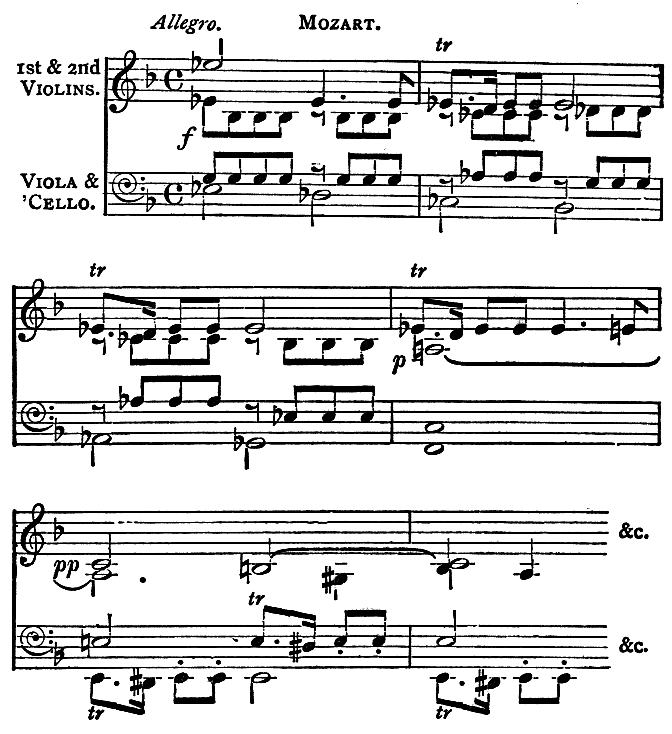
Of course it must by no means be overlooked that it is only by a perfect rendering of the music that ideal effects of this kind can be revealed as they first arose in the mind of the composer.
As illustrating another and quite different kind of-67- effect, we have in the andante of No. 8 Quartett in D major, dedicated to the King of Prussia, an example of pure and simple melody, which, without subtlety or mysticism, flows on in calm, unclouded beauty.
Mozart.
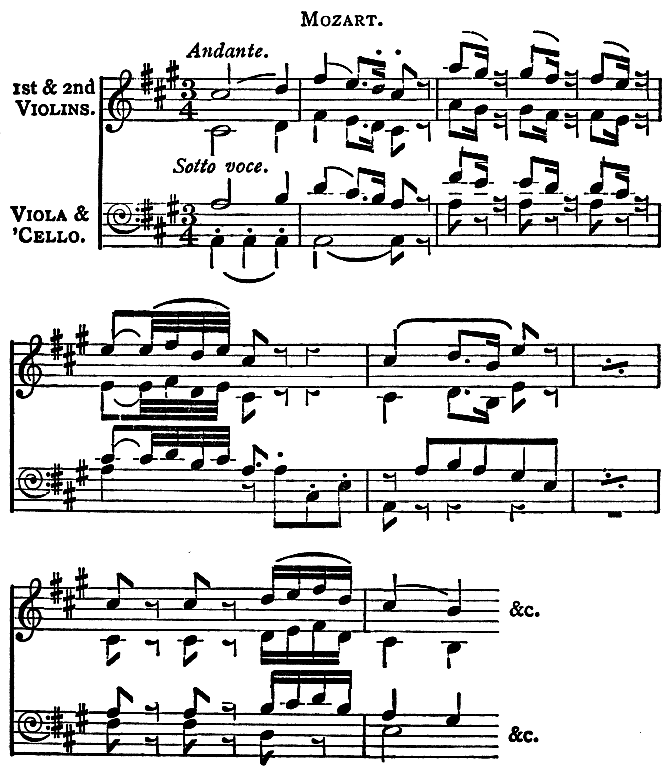
-68-
The earlier String Quartetts of Mozart are not of equal merit with those which he composed some nine years later. Of these the six dedicated to Haydn are quite remarkable, as are also the three dedicated to the King of Prussia. In these three the ’cello (the King’s favourite instrument) is more than usually prominent.
The Quartetts for flute and strings and those for oboe and strings are unimportant, but that for clarionet and strings is a more worthy work. Of the String Quintetts those in C, G minor, and E♭ are the best, especially the G minor, which is truly great. Mozart doubles the viola in these Quintetts. It was the custom of his contemporary Boccherini, to whom reference has been made, to double the ’cello.
There is also a Quintett for horn and strings, and one in C minor for the curious combination flute, oboe, viola, ’cello, and glass harmonica.[16] The Quintett in E♭, a special favourite of its author, for piano, oboe, clarionet, horn, and bassoon, is a fine work, as are the two piano and string Quartetts in G minor and in E♭.
Of Trios, the Divertimento in E♭ for violin, viola, and ’cello is remarkable; also that for clarinet, viola, and-69- piano, in the same key, an unusual but effective combination.
The seven Trios for piano, violin, and ’cello do not, as a whole, rank among Mozart’s most exalted efforts, but some of them, and especially certain movements, are excellent; that, for example, in E major, and the slow movement of No. 496 Köchel, in G major. For the piano and violin Mozart wrote forty-two Sonatas, an Allegro in B♭, and two sets of variations, which are said to have been generally written for his lady pupils. “They are neither deep nor learned, but interesting from their abundant melody and modulation.”[17]
This concludes the list of the more important of the chamber music works of this great master.
In the words of Richard Wagner: “The life of Mozart was one of continuous struggle for a peacefully-assured existence against the most unequal odds. Caressed as a child by the half of Europe, as youth he finds all satisfaction of his sharpened longings made doubly difficult, and from manhood onwards he miserably sickens towards an early grave.... His loveliest works were sketched between the elation of one hour and the anguish of the next.”[18]
-70-
But while this was so, it is pathetically interesting to read what he writes to his father when he first heard of his illness, for it shows clearly that amid the hardships and trials which beset him, Mozart never, at heart, repined, but sustained himself with a deep and far-reaching philosophy of human life. “As death,” he says, “strictly speaking, is the true end and aim of our lives, I have for the last two years made myself so well acquainted with this true, best friend of mankind that his image no longer terrifies, but calms and consoles me. And I thank God for giving me the opportunity of learning to look upon death as the key which unlocks the gate of true bliss. I never lie down to rest without thinking that, young as I am, before the dawn of another day I may be no more; and yet nobody who knows me would call me morose or discontented. For this blessing I thank my Creator every day, and wish from my heart that I could share it with all my fellow-men.”
-71-
BEETHOVEN.
Beethoven as democrat — Rhythmic similarities — Beethoven’s first and last compositions — Musical humour — The distinction in Beethoven’s chamber music.
The genius of this remarkable man has left us a heritage of undying beauty in every department of the art, and especially in that of chamber music.
“Beethoven[19] (1770-1827) was the first great democrat among musicians. He would have none of the shackles which his predecessors wore, and he compelled the aristocracy of birth to bow to the aristocracy of genius. But such was his reverence for the style of music which had grown up in the chambers of the great, that he devoted the last three years of his life almost exclusively to its composition; the peroration of his proclamation to mankind consists of his last Quartetts—the holiest of holy things to the chamber musicians of to-day.” With regard to these works it has been-72- said with, at any rate a certain degree of truth, that the musical ideas contained in them are too large for the means of expression, just as we find some movements of Beethoven’s Piano Sonatas to be orchestral in feeling, and beyond the powers of the piano adequately to express. Some critics have ventured to regard the later Quartetts as loose and rhapsodical in form. This is, however, merely the penalty which conventionality seeks to impose on creative genius, and may be passed by as harmless.
Among the many notable features to be found in Beethoven’s compositions, it has, more than once, been pointed out that there is a curious rhythmic likeness in certain works written by him about same time, and this is confirmed (as to the time of composition) by the sketches to be found in his note-books. The opening of the well-known Fifth Symphony, op. 67, composed about 1804, for example:—

may be compared with the Piano Sonata, op. 57, in F minor, written about 1805, and the Piano Concerto, op. 58, written about 1806. Another noteworthy instance-73- is found in the String Quartett, op. 74, written in 1809.[20] The third movement of which opens thus:—

And further on the following unison passage occurs, in which the resemblance to the Symphony just named, both rhythmic and as to the actual notes, is very striking:—

Yet here, as in the other instances, there is no mere repetition, for each case possesses a distinct and unmistakable individuality of its own.
The difficulty which presents itself in discussing Beethoven’s chamber music is that one is embarrassed by the wealth of material which presents itself on all hands, for although he wrote less in quantity than many of the classical masters, nearly every work is remarkable, and there is little or nothing that can come under the term “padding.” This is no doubt to be accounted for by the slow, yet sure, way in which he-74- worked. His sketch-books show this clearly. Some melodies, which seem to us so entirely spontaneous, as, for example, the slow movement of the C minor Symphony, and the opening of the song “Adelaida,” are found in these sketch-books in many forms, and were many times altered before he was satisfied, and the final form decided on.
Save some piano pieces which he did not think important enough to deserve an opus number, his first published compositions were in chamber music form. They are the three well-known Trios, op. 1, for violin, ’cello, and piano, and the fine Trio, op. 3, in E♭, for violin, viola, and ’cello. His last compositions also were in this form—namely, the String Quartetts already mentioned, whose meaning is only now beginning to be comprehended by musicians generally. His actually final work was the movement which now concludes the Quartett in B♭, op. 130. This work originally finished with an elaborate fugue, but Beethoven was prevailed upon (it is said by Artaria, the publisher) to substitute for it the present allegro, a movement which in its sprightly and almost joyous character, and the clearness with which it is worked out, forms a remarkable contrast to the fugue. Yet he wrote it under the influence of very unpleasant domestic circumstances, and also-75- what was always very trying to him, while confined to the house (his brother’s, at Gneixendorf) by rainy weather! Thus we see that he began and ended his career with chamber music.
Schumann, than whom it would be difficult to quote a higher authority, says of these last String Quartetts: “They appear to me to reach the extremest limits of human art and fancy yet attained.”
Of the earlier String Quartetts it is hardly necessary to speak at any length, as they are as familiar as household words to all who take their music seriously. To the four published as op. 18, this remark specially applies. But while this is so, no familiarity can alter the fact that they are among the most charming and technically perfect things which music has produced. That in F major, op. 59, too, is among the well-known ones, for who does not love its dainty allegretto (quoted below), one of the most remarkable of Beethoven’s scherzando movements?
Beethoven, Op. 59, No. 1.

-76-

It is in music of this kind that he shows us the wide gap which separates the merely comic element from that philosophic humour which “sees the comedy of life through a mist of tears.” Specially notable is the conclusion of this movement, where, after a full cadence in B♭, four bars (pianissimo) are added, which give the momentary impression of a quite fresh tonality; these are followed by other four bars (double forte) of the common chord of the key-note, with which the movement ends.
Beethoven, Op. 59, No. 1.

-77-
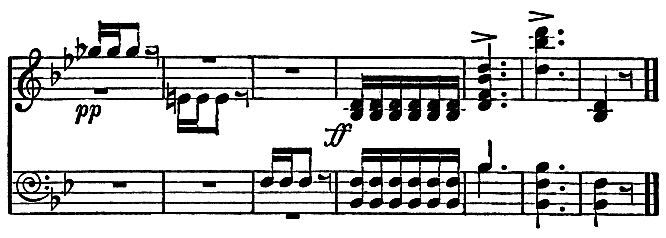
In quite another mood, but written with the same artistic eccentricity of effect, is the passage near the end of the adagio of Quartett op. 74, in E♭, where the note F♭[21] is played by the viola in the fourth bar of the following quotation:—
Beethoven, Op. 74.
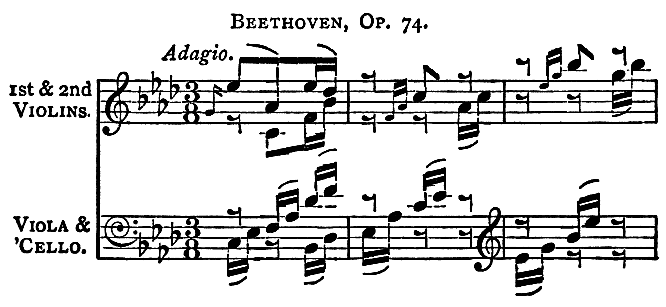
-78-
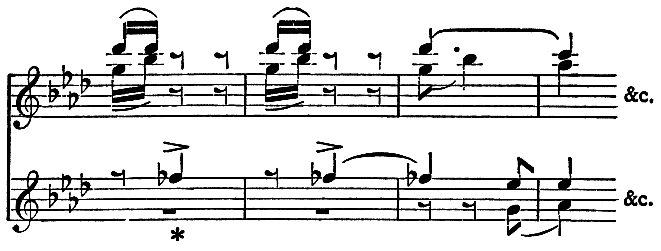
Among Beethoven’s earlier works the five Trios (one being a Serenade) for violin, viola, and ’cello, op. 3, op. 8, and op. 9, rank high, that in C minor, No. 3 of op. 9, being a specially fine work. The limited means (only three instruments) must be reckoned with in these works, yet without any excessive addition to the difficulty of performance, Beethoven produces continually the effect of a full quartett.
There is also another Trio, op. 25, for the unusual combination of violin, flute, and viola, in serenade form. The whole work is most interesting, especially as to the instruments for which it is written, and the fourth movement, which is an andante in G major with variations, performs with a surprising fulness of effect.
Another Trio is that for two oboes and English horn (or alto oboe), op. 87, a rather strongly flavoured mixture, which is apt to pall on the musical palate in actual performance.
It is in his trios for the piano combined with other-79- instruments, but chiefly with the violin and ’cello, that Beethoven’s work strongly contrasts with both Haydn’s and Mozart’s. No doubt his three early works of this kind, published as op. 1, reflect the style and influence of these two masters; yet even in these (the finale of No. 3 in C minor, for example) there are unmistakable signs of the coming Beethoven. But in the later ones, and more particularly that in B♭, op. 97, his supremacy is powerfully manifested.
The Trio, op. 11, for clarinet, ’cello, and piano (a combination used in our time by Brahms in his op. 114), is a pleasant, if not profound work, with a most expressive and charmingly written adagio movement.
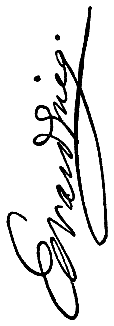
Of the Piano Quartetts, that in E♭, an arrangement of the piano and wind Quintett, op. 16, should be mentioned. The other Piano Quartetts are, comparatively, of little value. There are also the String Quintetts, of which that in C major, op. 29, is familiar as a splendid example of this master. The Sextett, op. 81B, for strings and two horns, with the delightful adagio, and that for two clarinets, two horns, and two bassoons, op. 71, may be named; also the well-known-80- Septett in E♭, op. 20, for strings and wind, both in its original form and arranged by the composer for clarinet or violin, ’cello, and piano; and the Octett, op. 103, for wind instruments, based on the Quintett, op. 4, for strings.
Beethoven’s Sonatas for piano and violin are among the more familiar of his works. Of these there are ten in number, and for the same instruments, a rondo in G, and a set of Variations in F. For the piano and ’cello he wrote five Sonatas, all of which are of great interest, and three sets of Variations, one being that on the well-known Handelian air, “See the conquering hero comes.” A Sonata for piano and French horn, op. 17, and three duets for clarinet and bassoon, may also be referred to, although they are of no great importance.
The great distinction in Beethoven’s works, especially those of his later years, is their high emotional expression. This it is which mainly differentiates him from his predecessors, and which makes him a romantic as well as, what by common consent he also is, a classical composer. This was, no doubt, the thought in Richard Wagner’s mind when, in his report to King Ludwig II. upon the establishment of a German music school in Munich, he wrote: “Through these last, and to us still unknown works of our wondrous master [Beethoven’s posthumous quartetts],-81- of all others, the powers of musical expression has taken a direction from which the music of earlier periods was often bound to hold deliberately aloof; I will here call that direction the tenderly and deliberately passionate, through whose expression music has first raised herself to an equal height with the poetry and painting of the greatest periods of the past. Whilst Dante, Shakespeare, Calderon, and Goethe, like the great masters of painting in Italy and the Netherlands, with this expression took fee of every portrayable object in the world and man; and whilst it was this that first enabled them to paint the world and man: in music there had ruled an axiom which openly degraded her as a branch of Art, an axiom borrowed from the purely physical pleasure, the purely sensuous entertainment to be found in her. To what a point this narrow view of music’s mission still wanders to this day, particularly under the terrifying impression of the un-understood last works of Beethoven, we may perceive from the flat assertions of modern æsthetes when setting up their theories of ‘the Beautiful in Music.’ Us it behoves, on the contrary, to first take true and full possession of the whole rich heritage bequeathed us by our great masters, and, through full knowledge of the powers developed by music hitherto, to procure ourselves due light on what development is still before her.”
-82-
SCHUBERT, MENDELSSOHN, SCHUMANN, AND SPOHR.
Schubert as song-writer — Schubert’s chamber music — Mendelssohn — Mendelssohn’s position in England — Mendelssohn’s character — Mendelssohn’s chamber music — Schumann — Schumann as absolute musician — The E♭ Piano Quintett — Piano trios — Spohr’s opinion of Beethoven’s work — Characteristics of his compositions.
Schubert’s fame rests chiefly on his songs, but in the domain of instrumental music he also did some remarkable work, although it can hardly be said that he fundamentally influenced the art in this direction. He lived (1797-1828) in Vienna at the same time as Beethoven, and many of his compositions show distinctly how much he was influenced by the genius of that great musician. Schubert’s works are distinguished by a spontaneous flow of beautiful melody. He possessed, by right of nature, the utmost artistic opulence, but unfortunately, owing chiefly to his birth and early circumstances, this was not consolidated by that profounder culture which is necessary for the fullest expression of human capacity. Not that-83- Schubert failed to reach a most exalted position, for works like the B♭ Piano Trio, the C major Quintett, that noble fragment the B minor Symphony, and especially his best songs, proclaim him unsurpassed by any musician of modern times; but out of the very profusion of his ideas, combined with a certain want of restraint and self-criticism, arose an artistic danger, the result of which is most evident in his larger works. This, too, is probably the reason why he was so great as a composer of songs, for he had all the means ready at hand for the expression which the text required, and the form being necessarily free, he could and did work in an unfettered fashion, with the most wonderful results. That this is so, such Lieder as “The Erl King,” “Gretchen at the Spinning-wheel,” “The Wanderer,” and many others, abundantly prove. Liszt, who greatly advocated his works, called Schubert “the most poetical of all the musicians,” and Schumann characteristically writes thus of the Piano Trio in B♭:—“One glance at this trio, and all the pitiful clouds of life disperse and the world shines again as fresh and bright as ever. This work is indeed a precious legacy. Many and beautiful as are the things which time brings forth, it will be long ere it produces another Schubert.”
-84-
Schubert’s principal chamber music works are the Octett in F for strings, horn, clarinet, and bassoon; a Quintett (Forellen) for piano and strings; another Quintett in C major for strings, which is an extremely fine work; twenty String Quartetts, two Piano Trios, two String Trios, a Rondo Brilliant in B minor, a Fantasia in C, and some Sonatinas, and a Sonata for piano and violin. Of the String Quartetts, that in D minor, the slow movement of which is a set of variations on Schubert’s own song, “Death and the Maiden,” and that in G major, op. 161, are among the best of his works in this form. That in E♭, op. 125, is one of the best known; certainly it is full of charming melody, besides being very grateful for the players. The C major Quintett and the Piano Trio in B♭ already mentioned may be specially referred to as full of that charm and spontaneity which are characteristic of this composer.
Schubert’s career was one of comparative poverty and hardship. His compositions brought him little money. Still he seems to have laboured on without regard to popularity, content to do that which seemed best and truest, and no doubt finding his highest satisfaction and reward in the work itself, for as Emerson says, “Every true talent exhilarates.”
-85-
Thus was completed the short span of his earthly life, for he passed away at the early age of 31. Mozart died at 35, Purcell at 37, and Mendelssohn at 38! The inscription on Schubert’s tomb in the cemetery at Vienna, where he was, by his own desire, interred near the grave of Beethoven, reads thus:—“Music has here entombed a rich treasure, but still fairer hopes.”
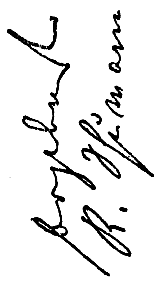
The career of Mendelssohn (1809-47) presents a strong contrast to that of Schubert. Born in affluent circumstances, he possessed from his birth all those advantages (and hindrances) which appertain to wealth. But his parents were discreet people, who were not, so to say, carried off their feet by the unquestionable precocity and genius of the boy. They took care that his education, both general and musical, was of the best, and when he was 16 years old his father took him to Paris, where Cherubini, Principal of the Conservatoire, reigned supreme as the great musical authority. The result of the interview was most satisfactory, and any scruples as to the boy’s musicianship, and as to what his future should be, were thereby finally disposed of, and Mendelssohn entered on a career which proved to be-86- one of the most brilliant that has ever fallen to the lot of a musician.
In England, after Handel, and perhaps Haydn, the name of Mendelssohn stands next—that is, taking provincial opinion, which is chiefly concerned with choral works, into account, and not merely London and the larger civic centres. Indeed, it is hardly an exaggeration to say that he stands before Haydn. That master is known, among those of whom we speak, chiefly by his oratorio The Creation. But in this work the choral writing is less satisfactory to the average choral singer than either Handel—as represented, say, by The Messiah, Samson, or Judas Maccabæus—or Mendelssohn, by Elijah and The Hymn of Praise; and for this reason Mendelssohn no doubt, in the opinion of such people, stands higher than the composer of The Creation.
We are not arguing as to the justice of such an opinion, which of course leaves out of consideration the instrumentation and the solos of Haydn’s immortal work; but such a condition of things has, none the less, been of much service in England, for Elijah presents many dramatic points which are not to be met with in either Handel or Haydn, and by the study of this work the taste of a very numerous class has been greatly advantaged, and that pernicious worship of Handel,-87- which up to some twenty or thirty years ago dominated British choral music, has to a considerable extent been broken up. Thus the way has been cleared for the introduction of works by the serious musicians of our own time, which are apt to be misunderstood and neglected, because they are often written in a freely dramatic form that is strange, if not obnoxious, to the average chorister.
This of course applies to choral music, but all the same a sound and progressive taste in one style is sure to affect the general judgment, and what is true of the oratorio will soon become equally so of the symphony, of chamber music, and of the other forms of composition.
Although from his youth up Mendelssohn exhibited a marked spontaneity of manner and freedom from the ordinary conventional restraints of life, yet there was all the time a serious side to his character which made itself manifest quite early in his career. Ferdinand Hiller relates that when Mendelssohn’s teacher, Aloys Schmitt, brought him as a boy to visit Hiller, as they approached the house Hiller, unobserved by them, saw from the window with what gaiety of demeanour Mendelssohn behaved, running behind and leaping on Schmitt’s back in a boisterous and uncontrolled manner,-88- full of life and vigour. When they entered the house, however, while the youth was unconstrained, yet he became quite grave and dignified in his manner, and expressed, in what Hiller thought almost over-ripe a fashion, his views about art and artists. Later in life the same characteristic of restraint showed itself under circumstances of such perennial interest that the story may again be told.
While residing in Frankfort-on-Main, Mendelssohn made the acquaintance of a certain family named Jean-renaud, the head of the household being a widow whose husband had been the pastor of the French Reformed Church. By his frequent visits to the house, it soon became evident that Mendelssohn was attracted in no ordinary way. But such was his demeanour that, although it was really the daughter Cécile to whom his heart went out, his friends were under the impression that the mother, who was still an attractive woman, was the load-star. To Hiller, with whom he was on terms of intimacy, Mendelssohn revealed his true feelings, and spoke with all the enthusiasm of young love of his regard for Fräulein Cécile. Hiller naturally looked daily for the usual climax, when to his astonishment he learned that Mendelssohn had suddenly left Frankfort and gone to Holland, where he stayed for a month. This he did, as he afterwards told Hiller,-89- deliberately to test how much and how truly he was in love. On his return, having no doubt proved the genuineness of his feelings, he became formally engaged to the young lady, and early in the following year (1837) they were married.
It is not easy even now to deal equitably with Mendelssohn’s chamber music, for his abundant and charming melody, combined with a clear and transparent style, are apt to beguile the judgment, and to obscure the fundamental truths whereby all art must be tried. The slow movement and the scherzo of the E minor String Quartett, for example, are admirable, and even though they may not be said to have added anything to the form in which they are written, yet the pure and elevated beauty of the music is entirely satisfying. On the other hand, some movements, such as the String Quartett op. 44 in D major, are, as has been often remarked, quite orchestral in style and effect, and the same may be said of the Quartett op. 80. Mendelssohn also set a pattern in the two Piano Trios, which has been too much followed by later composers, whereby the piano part dominates and tends to obscure the other instruments. Especially in some movements of the D minor op. 49 is this the case, whereby the balance of parts is disturbed, and the artistic value-90- lowered, of a work otherwise crowded with beautiful ideas.
Professor Ritter,[22] in discussing Mendelssohn’s position, says “he was more lyric than dramatic, more refined than profound, more conventional than original,” a judgment which is, in a general sense, in accord with that of another competent authority, who, speaking of Mendelssohn, writes:—“It has not been the lot of many men to win so much affection, or to give so much pleasure. His various gifts were in constant employment for the benefit of all people who were capable of enjoying music and good company; and he squeezed as much work into his short life as most men get into a life of twice the length. The spirit in the end wore out the body; indeed it seems wonderful that it stood the strain so long. But his nature would not allow him to live otherwise, and the enjoyment of all the things which came in his way was a necessary condition to enable him to produce the happy genial style of music which is characteristic of him.... He was too full of occupation to brood over the troubles of the world, or to think much of tragedies and the stern workings of fate; but all moods must have their expression in art, and those which were natural for him to express he dealt with in the most delicate and artistic way, and the-91- results have afforded healthy and refined pleasure to an immense number of people.”[23]
The following are Mendelssohn’s principal chamber music compositions:—
“The English have adopted Mendelssohn, but in Germany an equal rank is accorded to Schumann. It may arise from affection for Mendelssohn that the English are inclined to deny Schumann’s claims, fearing that the recognition of them may interfere with the justly deserved reputation of their favourite; but, be this as it may, a comparison should not be instituted-92- between them. Schumann, apart from his not having the natural gifts of Mendelssohn, was a solitary student, unable by the use of his talents or his manners to make himself popular. Mendelssohn, endowed with every distinction nature and a refined education could bestow, happily balanced the requirements of the public with the dignity of the true artist, without yielding to vulgar tastes. If he did not rely on the vox populi he admitted the truth existing in that voice. Schumann, if he did not exactly treat popular opinion with contempt, would not consult it. He never had the means of forming for himself a clear idea of what was due to the public, not being a public player, as Mozart, Beethoven, Weber, Mendelssohn, and Chopin all were. It is before the public an artist learns to play, and it is before the public a composer feels, with even painful acuteness, any imperfections or tediousness in his works. That which sounds right and interesting in a small study, with a sympathising friend to turn over the leaves, may sound dreary, uninteresting, and even tiresome, to an indifferent audience. We have here a sufficient reason why Schumann would not have attained a widespread popularity like that of his admired friend Mendelssohn. But surely in these days, when there are so many weak productions, we are not justified in disregarding the-93- works of an intelligent and conscientious master; a man who had the purest and noblest aspirations, and who was ever the first to acknowledge, with true sympathy and every sign of delight, the merits of others.”[24]
Robert Schumann (1810-56) was a man of high intellectual capacity and culture, and this it is which chiefly distinguishes both the man and his compositions; for it will hardly be claimed for him that he was by birthright such an absolute musician as, say, Mozart or Mendelssohn.
The inborn natural qualities of these masters were, of course, supplemented by that careful training which is essential to success, even for the most richly endowed of human beings; but with Schumann one may almost say that the culture stands first. Not that he failed to exhibit strong musical tendencies even from his childhood, for do we not read of his caricaturing his schoolmates by playing, in a grotesque manner, on the piano, while still at school. Yet anything he did in this way, and as regards composition, is very different from what we find in the early years of the two who have been mentioned. It is evident also that, as he grew to manhood, his aim in life was to become a-94- solo pianist, for which purpose he worked diligently under the father of that great artist Clara Wieck, who eventually became his wife. But, unfortunately, he injured his hand in an attempt to make it stronger by some mechanical means, and thus he had to relinquish the idea of playing in public. Then he more earnestly applied himself to composition, with no doubt most remarkable results. Yet in this sphere too we find the influence of a resolute determination, as distinguished from a natural yearning, as, for instance, in the year 1842, when he resolved to write chamber music, it is said that he shut himself up with the scores of Beethoven’s string quartetts, and having, as it were, assimilated their very essence, he proceeded to compose the three quartetts known as op. 41. There are evidences[25] of a like mental habit in connection with his larger works, which may be investigated by those who care to do so.
It is, however, in the piano compositions of his early period that one finds the truest expression of his genius. He was indeed the poet of the piano, and he has left us, in this style, a wealth of rich romantic beauty.
The Piano Quintett in E♭, op. 44, is generally regarded as one of the best works which Schumann has given-95- to the world in chamber music form. It is, from the outset, characterised by a straight-forwardness of utterance which is not always found in his compositions, and it is also more than usually grateful to play. The first movement, which is distinguished by an impressive and stately rhythm, preserves an astonishing freshness, even after one notices that it consists of an almost unceasing repetition of the first few notes of both its principal themes. The dirge-like “In modo d’una Marcia” movement, which follows, carries with it the convincing argument of true melody and well-contrasted episodes; the scherzo, with its homespun scale passages, which are, however, so treated as to sound quite unusual; these, and the finale, which brings the work to a resounding and successful conclusion, are all quite clear and need no commentary. That such a work should meet with high approval and retain a permanent hold on the musical world is what might naturally be looked for.
The Piano Quartett op. 47, in the same key, E♭, is written somewhat in the same manner, but with hardly the sustained energy and character of the quintett. It is in the andante of this work that we find the succession of sevenths in the chief melody which, while charming in effect, illustrate the tendency frequently-96- shown by Schumann to write passages in the Rosalia form. This is to repeat a phrase or melody at another pitch several times in succession, a method which, at any rate in Germany, is regarded as betokening a certain weakness of inventive power. It is also in this andante that the ’cello tunes the fourth string down to B♭, so as to sustain a pedal bass on that note during the last bars of the movement.
Of the three piano trios, that in D minor is the finest work, and contains much that is admirable, especially as it avoids, as indeed is Schumann’s constant custom, the mere bravura pianoforte style of writing. These trios do not, however, compare favourably with the quintett or quartett named above, and this applies more especially to that in G minor.
As regards Schumann’s position as one of the classical composers, Mr. Hadow in his Studies in Modern Music, says:—“It may be that much of his work will not survive the attack of time. There are few men who do not find that the greater part of their life’s record is written in water. But something at least will remain. He is not only the best representative, but the virtual founder of a distinct style in music; his sense of beauty is often exquisite; his feeling—pure, manly, and chivalrous. So long as melody possesses the power to soothe, to comfort, to sympathise, so long shall we turn in-97- gratitude to one who could transmute the sorrows of his own heart into an elixir for the cure of others.”
Schumann’s chamber music compositions include:—
Had Spohr’s (1784-1859) musical powers, remarkable as they no doubt were, been equal to his individuality of character he would have outstripped all his contemporaries, not perhaps excepting Beethoven himself. He was essentially a self-centred man, a kind of solar mind whose constant tendency-98- was to make satellites of whoever and whatever came within the sphere of his personal influence. This it is which tends to explain his criticisms of the men of his own time, such, for example, as that the opening of Beethoven’s C minor Symphony was unfitted for such a work; that the slow movement was tedious; the finale full of unmeaning noise; that the Ninth Symphony was “monstrous and tasteless”; and that Beethoven was, as a composer, “wanting both in æsthetic culture and sense of beauty.” This, too, it should be remembered, cannot have been any mere hasty or superficial judgment, seeing that Spohr lived in the city of Vienna for some time along with Beethoven, knew him personally, and must have had a fairly full opportunity of forming an opinion of his music. In contradistinction to this, however, we must place the facts that he admired the earlier works of the Bonn master, and was indeed the first to perform publicly at Berlin and Leipzig the String Quartetts op. 18. Also, strange to say, that in the year 1853 he brought out, in spite of much opposition, at the Cassel Opera-house, where he was the director, Wagner’s opera Tannhäuser! This curious combination of conflicting qualities is further exemplified by the fact that he, who was naturally a classic in style, and regarded Mozart as his-99- model, wrote a number of his important works to a programme. Among these we find an orchestral symphony entitled “The Worldly and the Heavenly Influences in the Life of Man,” with a solo orchestra for the heavenly, and an ordinary full orchestra for the worldly influences. Another was called “The Seasons.” No doubt these works contain many fine ideas, and some movements are full of charm, but for all this, it cannot be said that they were really successful, or that Spohr thereby increased the scope of the symphonic form.
Mannerism of a pronounced kind, such as the frequent employment of chromatic progressions both melodic and harmonic, of enharmonic modulations, and a certain kind of constantly repeated phrase and cadence, these it is which prevent Spohr from occupying a place of the first rank among composers. His works for the violin, as a performer on which instrument he occupied a most distinguished position, are, however, of the highest order, and as a composer of chamber music, with which we are here chiefly concerned, his double quartetts, especially the earlier ones, display his powers in the most favourable light. In his ordinary quartetts, however, the leading violin is, generally speaking, used with undue importance. Still,-100- when all is said, the fact remains that these works uphold a high and dignified standard, and while not in any sense an epoch maker in music, Spohr undoubtedly exerted a most beneficial influence on the art. His chief chamber music compositions are:—33 String Quartetts, 8 Quintetts, 4 Double Quartetts, 5 Piano Trios, 2 Sextetts, 1 Septett, 1 Octett, and 1 Nonett; also Duets for 2 violins, violin and harp, violin and piano, etc. There is also a Concerto for String Quartett, op. 131, with orchestral accompaniment.
-101-
BRAHMS AND DVOŘÁK.
Opinions of Brahms — Weingartner — H.T. Finck — Bülow on Rubinstein — H. Davey — Schumann — W.J. Henderson — Philip Spitta — Sir Hubert Parry — W.H. Hadow — Piano Trio, op. 8: two versions — Horn Trio, op. 40 — String Sextett in B♭ — String Sextett in G major — Piano Quartett in G minor — Quintett in F minor — String Quartetts — Thematic resemblances — String Quintetts — Clarinet Quintett — Dvořák — Revival of Bohemian music — Birthplace and early career — Criticisms on his works — His symphonic poems for orchestra — An American national style of music — The Negro Quartett — String Quartetts — Piano Quartetts — Piano Trios — String Sextett — Other chamber music.
The individuality of Brahms (1833-97) was quite as pronounced as that of Spohr, although in a different way, but his creative musical powers were much greater. It is sometimes said that Schumann is the one great composer since Beethoven; but when we shall have arrived at that point of time from which Brahms’s position can be adequately reviewed, the extreme probability is that he will then be regarded as the great one, rather than Schumann, or any of the others who have lived and laboured since the death of the Bonn master.
Wagner, of course, is not to be reckoned with in this-102- connection. His work was of an altogether different order, and no useful purpose is served in discussing him along with the composers of absolute music. This favourable opinion of Brahms is not, however, shared by some critics, and as it is well to hear both sides, some of the opposing views may usefully be quoted. The well-known German composer-conductor Felix Weingartner, in a recently published article on the post-Beethoven symphonists, says:—“Brahms was, above all, a master of form. His works are of an unimpeachable technical perfection, but I have only discerned a warm, palpitating feeling of life in a very few of them, which then has great value, owing to the junction of beautiful thoughts and a perfect construction.... Taken altogether Brahms’s is, I might say, scientific music, composed of sonorous forms and phrases; it is not the language of humanity, mysterious, but still infinitely expressive and comprehensible.... The music of our great masters is artistic, and, as such, natural; that of Brahms is artificial.... The works of Brahms which attract me most, such as, for instance, the Symphony in D major, are not esteemed as the summit of his creative power by his enthusiastic partisans. They give the preference to several others, such as the Triumphlied, the E minor-103- Symphony, and the Clarinet-Quintett, which, to me, are loud-sounding hollownesses.”
Henry T. Finck,[26] the American critic, disputes the position usually ascribed to Brahms. After implying that Schumann was already affected by a growing mental malady when he so strongly advocated Brahms’s works, Mr. Finck goes on to say that, “it was not until it occurred to his admirers to pit him against Wagner that Brahms began to loom up as a big man.... In England another violent enemy of Wagner[27] and intimate friend of Brahms’s, Joachim, championed Brahms’s cause and helped him to a temporary vogue.... It was a very clever bit of strategy thus to pit Brahms against Wagner, for it gave him a prominence which otherwise he would never have had.... In chamber music Brahms holds his own against any modern rival; but his symphonies, while cleverly constructed, have not one tithe of the ideas to be found in Rubinstein’s Dramatic and Ocean Symphonies; and the same lack of ideas we note in his songs, as compared with Franz’s. Yet Brahms’s symphonies and songs are to-day-104- on all concert programmes, while Franz and Rubinstein are neglected. But it will not remain so.... Ideas alone confer immortality on works of art; and genius might be defined as the faculty for originating ideas. Brahms was a great dress-maker—a musical Worth. No one ever knew better than he how to cut and shape musical garments, and to trim them with elegant variations. But his faculty for originating ideas was weak, and therefore he is not immortal.”
This is plain-speaking, but it should be received with caution, when we call to mind that this writer allows himself the licence at times to make such loose statements as that Beethoven’s Eroica Symphony is twice as long as any symphony preceding it, and especially in view of his over-confident assertion about Rubinstein’s unending symphonies. Some of us do not forget Hans von Bülow’s caustic wit in this matter. “Rubinstein’s works,” he said, “remind me of a journey in Russia. Long stretches of barren and tiresome country, relieved here and there with the oasis of a picturesque and interesting city.”
Mr. Henry Davey, in his Student’s History of Music, gives his opinion thus:—“There is, however, one German composer who stands out above the rest, and has been sometimes spoken of as if he were really a-105- genius worthy to rank with the greatest. This is Johannes Brahms, born in 1833 at Altona, and introduced to the world by Schumann. He has published more than one hundred works, very clever and, generally, very dry. They are laboured in the bad sense of the word. Brahms with splendid gifts seems to have gone early on the wrong tack, imagining that the more abstruse he made his works the better they would be. Consequently he tangled up his themes with a complication of uneven rhythms, ravelling very ordinary ideas with skeins of harsh counterpoint; in fact, making his works as unpopular as possible, apparently with the idea that if they were unpopular they must necessarily be good.”
Another critic,[28] whose words are curiously like those just quoted, says:—“When Brahms writes musically he is usually not profound; and when he writes profoundly, he is, sometimes, not musical.... Take the opening theme (of op. 115): would not anybody without the time direction take it to be a slow scherzo? He has clouded it with his usual uneven rhythms and tangled accompaniments, but that does not atone for the poverty of the theme.”
Against these may be placed the well-known opinion of Schumann which appeared in the Neue Zeitschrift-106- für Musik in 1853. It is needless to repeat all that Schumann said. How he found in Brahms’s works a likeness to “some onward foaming flood, bearing on the surface of its waves as they dashed downward, the peaceful rainbow, and surrounded on the bank by butterflies and nightingales’ voices. When this composer sinks his magic wand to where the powers of the masses in the orchestra and chorus lend him their strength, we shall find still more wonderful glances into the secret of the spirit-world in store for us.” Such words from one of the standing of Robert Schumann, poetically expressed though they be, may not be passed idly by.
To this may be added the view of another competent and thoughtful writer.[29] “Brahms’s compositions show a completeness of architectonic detail, superimposed upon a symmetrical and inevitable organic development, such as are to be found in those of no other symphonist except Beethoven.... Some day, I think, if not soon, the world will see how profoundly representative of his nation and his time Brahms was, and he will be hailed, as Milton was, an organ voice of his country.... It may take time for the entire musical world to come under the spell of this austere utterance; but Brahms-107- had the happiness of knowing ere he died that, wherever music was cultivated, his individuality at least had made itself known.”
In his Essay on Brahms (Paetel, Berlin), the well-known author of the monumental life of John Sebastian Bach, Philip Spitta, says:—“The leading characteristics of Brahms’s music are all plainly visible in his first ten works. A manliness that is almost brusque, a dislike for purely emotional music, stern conciseness in the melodic matter, a delight in organic structure, particularly by the use of strict polyphony, all combining with the freer style of Beethoven to produce entirely new results. The serious underlying feeling, a sense of depth, and a shrouded exquisite beauty of sentiment under a dignified reserve.... Such a complete comprehension of all the forms and means of musical expression as we find in Brahms, and the way to apply them in the forms of composition he affected, is really stupendous, and in its way quite unprecedented.”
Speaking of the modern tendencies in music, Sir Hubert Parry[30] says:—“And even in the highest branches of art, represented by the noble symphonies of Brahms, which illustrate the loftiest standard of style of the day, the-108- significant change from the old ideals is noticeable. For the aim is but rarely after what is equivalent to external beauty in music. What beauty is aimed at is beauty of thought, the beauty of nobleness, and high musical intelligence.”
The personal note is added by Mr. Hadow[31] when he recites the story of Brahms taking up his residence in Vienna, the city of high musical activity, in 1862. “As yet his compositions were little known, but there was no musician in Vienna who had not heard his name or felt some expectation at his arrival. Before long, introduction had ripened into acquaintance, and acquaintance into a many-sided friendship. Men were glad to welcome a new genius of conspicuous power and encyclopædic knowledge, who never spoke of himself, who never wrote a line in his own defence, who never attacked an opponent, or depreciated a rival. Add to this the quiet voice, the undemonstrative manner, the kindly disposition that expended itself in a thousand services, the upright honesty that would never stoop even to conquer, and it is not hard to explain a personal popularity which has lasted unimpaired to the present day. The artist is too often to be described in Mr. Stevenson’s phrase, as ‘a man who sows hurry and reaps-109- indigestion.’... It is not a little refreshing to contemplate a genius who, with all the astonishing amount that he accomplished, yet found time to enjoy his dinner, to bear his part in the company of his friends, and to become the sworn ally of all the children in the neighbourhood.”
An examination of the list of Brahms’s works shows that he found a congenial field for his labours in the department of chamber music. His works for Piano Solo number 23, amongst them being the remarkable Sonatas op. 1 and 2, which were probably among the compositions that drew from Schumann his highly appreciative notices of Brahms. There are seven Duet Sonatas, viz.: three for piano and violin (truly great works), two for piano and ’cello, and two for piano and clarinet. The last-named, op. 120, are almost his final compositions, and contain some admirable music, especially that in E♭, No. 2. The andante of No. 1 is also a beautiful and characteristic movement, by which is meant that its beauty is no mere prettiness, but rather a noble expression of the composer’s best thought.

There are also seventeen other chamber music works, many of them being of the-110- highest importance. The Trio op. 8, for piano, violin, and ’cello, may be named first, seeing that after a lapse of nearly forty years Brahms, with a rare sense of self-criticism, re-wrote the work and published the new edition, thus, as it were, opening to us quite freely the windows of his workshop. Each movement of the trio has undergone some change, the chief of these being the first allegro con brio, which is shortened by some two hundred bars, the melodious second subject of the original version being replaced by other matter, and a fugal episode, based on this subject, which on second thoughts Brahms evidently rejected as incongruous, is eliminated altogether. The next movement, a scherzo, remains, save as to slight details, unaltered until the last thirty bars. In these the treatment is different from the first edition, a series of descending chromatic chords in the piano part being replaced by passages evolved from previously-used themes, and the string parts are radically altered. The adagio has undergone a considerable amount of alteration. In place of the second subject an entirely new theme appears; the allegro episode (Doppio Movimento) is discarded, and the length of the whole movement curtailed by more than one-third. The finale, originally marked “allegro molto-111- agitato,” is marked “allegro” only, and instead of 518 bars, it has now only 322. New thematic matter replaces that which is omitted, and generally speaking the whole movement is a good deal transformed.
We have here a somewhat rare, although of course by no means unique, opportunity of comparing the treatment of similar musical ideas by a great master at two different periods of his career, and while no doubt the changes of some of the original themes for others is of interest, the chief lesson which this revised version enforces, is that of conciseness of musical utterance. The first edition contains more passages of melodic beauty (or, may we say, more tunes approximating to prettiness?), and much more of scholarly working out; but for all this there can be little doubt that Brahms perceived the organic weakness which arises out of this diffuseness, however charming the subject-matter may have been in itself, and hence arose the artistic impulse to rewrite the work.
It would be interesting if some of our chamber music artists were to perform the two versions at the same concert.
The other Trios are: op. 40 in E♭, for piano, violin, and horn; op. 114 for piano, clarinet, and ’cello, which is not generally regarded as a satisfactory work; and the two for the ordinary combination of piano, violin, and-112- ’cello, op. 87 and op. 101, both of which are fine works.
The Horn Trio, op. 40, may be regarded as specially individualised in style, and if one of a composer’s works more than another, may be spoken of as revealing the man himself, this trio certainly seems to do so with Brahms. There is a dignified simplicity and al fresco-like charm about the commencement of the work, which, with here and there a touch of sombreness, continues until we reach the scherzo, a busy movement alive with bright and joyous hunting-horn effects.
It is, however, in the “Adagio mesto” that we find the strong individuality of the composer, and a deeply-brooding and fateful expression of feeling, which is, in a certain mood, more peculiarly a characteristic of Brahms than any other quality which he possesses. The whole work, and especially this adagio, is well worthy of sympathetic study.
The String Sextett in B♭, op. 18, has often been spoken of as one of the finest specimens of Brahms’s earlier compositions. One writer has called it “the most magnificent piece of chamber music that has appeared since the death of Beethoven.” Its production at Vienna in 1862 under the famous quartett leader, Hellmesberger,-113- was followed by an outburst of enthusiasm, which was all the more remarkable seeing that prior to this the critics had received Brahms’s works with marked coldness.
The other String Sextett, op. 36, in G major, was also given under the same leader in the Vienna winter season of 1867, and, in the words of one report of the concert, “It is no discredit to either composer or audience that the new work was received with more astonishment than delight. The extremely elaborate polyphony, which is one of its distinguishing attributes, is probably too intricate to be comprehended by any one at a single presentation, and we may infer that the public actually did not hear the melodies for the simple reason of their abundance.” The charming second subject of the first movement (quoted below) well illustrates the latter part of this statement—
Brahms, Op. 36.

while an examination of the score reveals a wealth of material which can only be assessed by patient and loving study.
-114-
It was in his Piano Quartett, op. 25, in G minor, that Brahms made his first appearance in Vienna, after he took up his residence there in 1862, and although the work is now regarded as an intelligible and convincing piece of chamber music, it was at first received with strong disapprobation by the Viennese musical public. “Dull and ill-developed,” were the terms applied to the first three movements; and the last, because of its being written in Hungarian dance style, was condemned as without precedent and artistically bad. That Haydn, Mozart, and Beethoven had already introduced such movements into their chamber music was either unknown to these critics, or ignored by them.
The andante of this quartett contains some of its author’s noblest thoughts, expressed with the utmost clearness. Special attention may be directed to the middle section in C major of this movement, with its strongly-marked military rhythm and highly characteristic effects.
The other two compositions in this form are that in A major, op. 26, and in C minor, op. 60. In the commencement of the former we have a fine example of poetic expression, yet at the close the same material is worked out, in a contrapuntal manner, which is quite-115- remarkable. The slow movement of this Quartett has been referred to by Mr. Fuller Maitland as an example of “exquisite tone colour,”[32] and this work, and that in G minor already referred to, are regarded by this writer as “among the loveliest of Brahms’s works.”
The Piano Quartett in C minor, op. 60, does not show the same high qualities as the other two, and is indeed somewhat lacking in spontaneity. The second entry of the strings in the opening movement has a chromatic passage which is more like Spohr than Brahms, nor is the chorale which appears in the last movement at all in his usual style.
Of the works for piano and strings, the great Quintett in F minor, op. 34, is a remarkable example. It has been said that Brahms has the gift of making simplicity memorable, and this is illustrated by the commencement of this quintett. To hear it once is to be impressed with its power, and although viewed theoretically it seems almost commonplace, it produces in performance an effect which is truly vital. The piano, first violin, and ’cello begin thus, the first three bars being in unison and octave:—
-116-
Brahms, Op. 34.
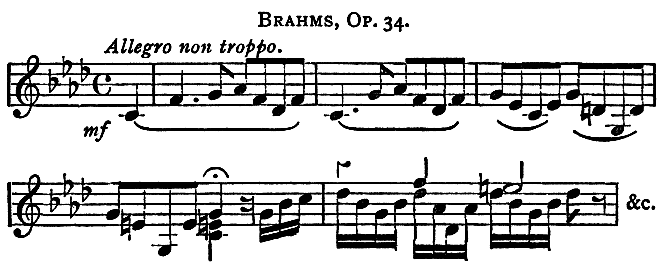
A little farther on in this movement we meet with a melodious fragment very characteristic of this composer. Three notes, embraced within the range of a minor third, are used together in contrary motion, and furnish a theme which, although curiously simple, plays a considerable part in the development of the movement:—
Brahms, Op. 34.

It has been urged against the scherzo which follows that it inclines too much to be orchestral in effect, and of the finale that it is, as one writer has it, “overcharged with subject-matter.” But however this may-117- be as regards these two movements, it will hardly be disputed that in the andante, whose opening passage is quoted below, we have music of rare and solemn beauty, deep yet clear, profound yet spontaneous. We quote the pianoforte part, which is accompanied with a subdued imitative figure by the first violin and viola, while the ’cello plays a few pizzicato bass notes:—
Brahms, Op. 34.
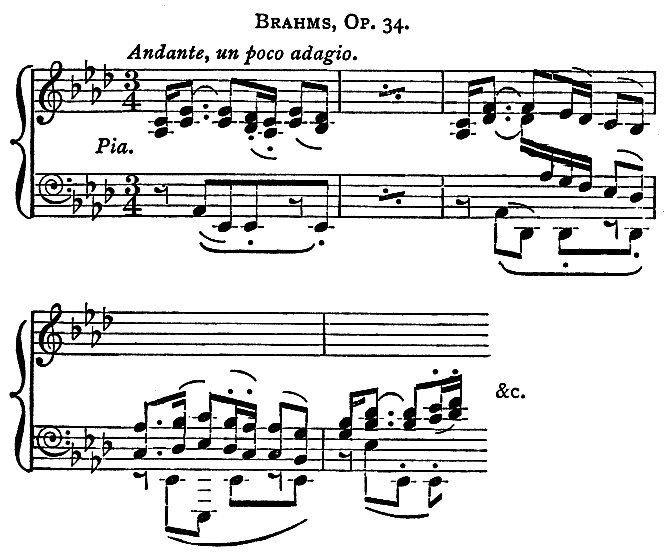
In the important form of the String Quartett Brahms has left only three works, viz.: two (in C minor and-118- A minor), op. 51, and one (in B♭), op. 67. The number is few as compared with the other great masters, and especially of course with Haydn, but the quality of each work is remarkable. In England, at any rate, these quartetts have met with a cautious and critical reception. The reason for this is, no doubt, that for their true appreciation they require study and many hearings, conditions which unfortunately are not common amongst us. Amateurs, however, who play them, and know them intimately, will hardly share in these adverse opinions. Some of the movements have been spoken of as lacking in inspiration, an opinion which, if one accepts Brahms at all, seems strange, for in none of his works does his peculiar genius shine more clearly through the medium in which he works than in these. One may reject Brahms altogether, falling foul of his idioms and methods, as some do, but it is hard to understand how compositions so characteristic as these can be rejected by any who rank themselves as students or disciples of this master. The slow movements of all these string quartetts may be referred to as showing with what true melodic charm Brahms can invest his music, and this is all the more notable if one considers the unusual manner in which the beautiful tunes are often presented. For example, the romance of No. 1 in C minor:—
-119-
Brahms, Op. 51, No. 1.
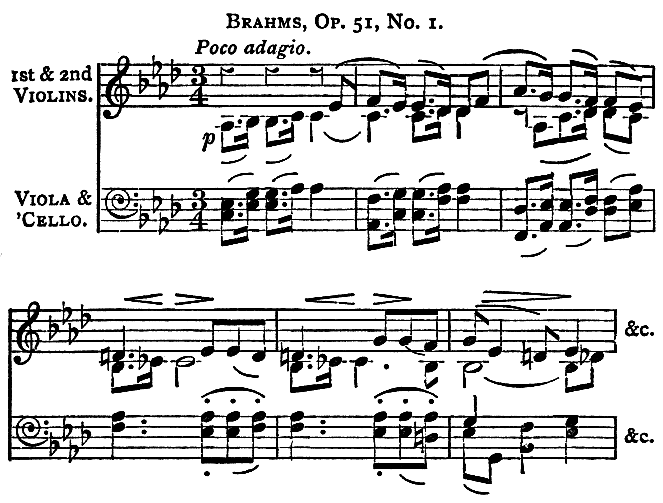
Farther on, at the twenty-seventh bar:—
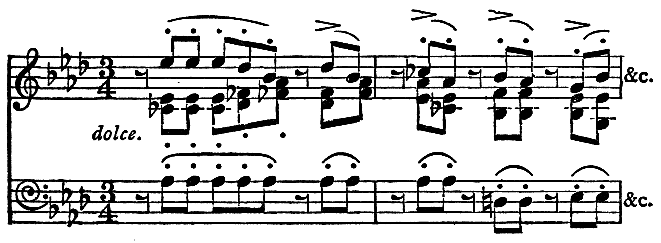
And, later, the following:—
-120-
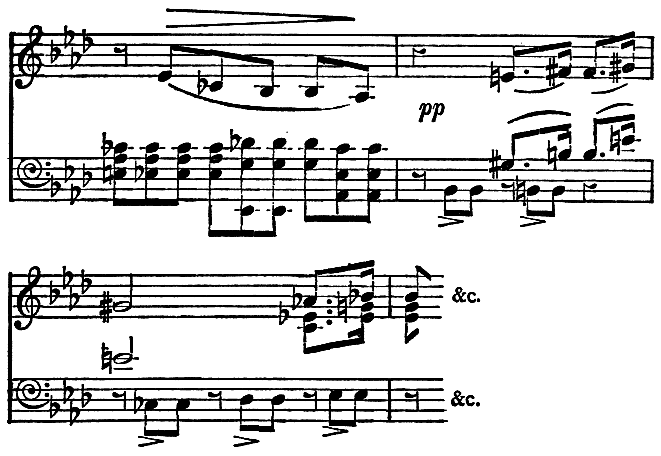
Such music is not, however, “for the market-place.” It requires the most delicate handling, and only perfect technique, united to the highest taste, are equal to the expression of such lofty and beautiful thoughts.
The resemblance of certain of Brahms’s themes to those of other composers has often been noted, sometimes in a captious and ill-natured spirit, whereas the true interest of such a matter lies in the opportunity which is thereby afforded of showing how two master-minds can deal with like material. An instance of this is the finale of his Symphony op. 68, as compared with the-121- leading melody of the vocal part of Beethoven’s Choral Symphony; another, the commencement of his A major Sonata for piano and violin, and the Preislied of Wagner’s Meistersinger; and again, the following from the String Quartett in C minor, op. 51:—
Brahms, Op. 51, No. 1.

Wagner, “Rheingold.”

It remains to speak of the two String Quintetts op. 88 and op. 111, and the Quintett op. 115, for clarinet and strings.
The op. 88 was written during a summer holiday at Ischl in the year 1882. It is a masterly composition, the first movement being of an animated and joyous character. This is followed by a slow movement (grave ed appassionato), varied by two quicker episodes. The finale (allegro energico) is written in free fugal form, and has an unusually prominent part for the first viola.
The second String Quintett, op. 111, in G major, is a-122- delightful work, in its composer’s ripest style. There is an unusual tenderness of expression in the melodies of the first three movements, the lightsome allegretto being well contrasted with the sombre adagio, in which, as in the other Quintett, an important part is assigned to the first viola. The vivace, with which the work ends, although complex in texture, is a vigorous and effective movement.
The Quintett for clarinet and strings, op. 115, which appeared about the same time as the clarinet Trio which has already been mentioned, was first heard in England in 1892, the clarinettist being the now well-known German artist Herr Mühlfeld (Brahms’s “unsere prima donna”), who, it is understood, came from Vienna at the desire of the composer.
This work has gradually grown more and more into favour, which is what might be expected, for while such music makes large demands on both performers and listeners, it amply repays study, and is indeed a rich addition to the treasure-house of art.
To the serious student and lover of good music the works of Brahms are a lasting delight, expressing as they do the purest and best of our musical aspirations. What the great masters of the past did for their day and generation Brahms has done for ours, and it is safe-123- to say that the sympathetic attitude of any community towards him may be taken as a conclusive proof that its musical state and condition is sound and true.

Two names, Smetana (1824-84) and Dvořák, are intimately associated with the revival of music which began in Bohemia about the year 1860. The political condition of the country had, since about 1620, been one of national degradation. Conquered by the Emperor Ferdinand of Austria, the people were down-trodden and oppressed, their language prohibited, and as a result the arts practically dead. In the year 1860, however, an imperial decree appeared which granted a measure of liberty to the people. This was speedily followed by a better state of public affairs, in which, of course, music participated. Smetana, who had held the appointment of conductor to the Philharmonic Society at Gothenburg, resigned that post, and returned to Prague to assume what was practically the direction of the newly-liberated national musical forces. Here he found Dvořák, a young man with rapidly developing musical powers, whose career had hitherto been one of comparative poverty. He was of humble, although by no means ignoble birth, for if his father had not wealth and worldly position, he at least had health and a strong-124- character, and in addition to this he was also somewhat of a musician, although of a rude and uncultured sort.
It was in the Bohemian village Nelahozeves, which is situated on the river Moldau not far from Kralup, that Dvořák was born in the year 1841, and here he was reared, working at his father’s occupation, which was that of an innkeeper and butcher. At the age of eighteen, however, the musical impulses which had already made themselves evident in the youth became too strong for parental restraint, and he left home and went to Prague, where he obtained admission to the city organ school, and, that he might earn enough to keep body and soul together, he played violin and viola in the orchestras of both church and theatre. Under the tuition which he here obtained his powers rapidly developed, and during this time he seems to have composed a great deal. Happily he now learned of the Austrian state aid which was to be obtained by needy artists, and making application, a stipend was granted him, mainly, it seems, through the influence of Brahms, who happened to be one of the committee having charge of the fund. Thus relieved from the carking cares of poverty, Dvořák gave himself up to his life-work even more earnestly than before, with what an excellent result we now know.
That his early surroundings exerted an adverse-125- influence on his artistic career there can, however, hardly be a doubt, and only the opulence of his natural powers could have triumphed over these and given him that large measure of success to which he has eventually attained.
We are all by this time familiar with the stages of criticism through which his works have passed—undue length and want of conciseness, fresh episodes instead of organic development, the continual use of national idioms, and the like. To these must be opposed the splendid qualities of melody, form, and colour which are found in his best works, such as The Stabat Mater, The Spectre’s Bride, the D minor Symphony, and the A major Piano Quintett, and no just assessment can refuse for Dvořák a most exalted place amongst contemporary musicians.
True, the Sclav idiom pervades a number of his works, but this is, as it were, a mere accident of his nationality, and in no way detracts from the splendour of his achievements. We do not reject Burns because he wrote a good deal in a Scottish dialect, or Tennyson’s “Northern Farmer” because it requires a glossary.
Dvořák, although a lover of the romantic, has nearly always worked on classical lines, and to him must be credited the addition of certain new forms to the musical-126- literature of our time. For example, “The Furiant,” a kind of wild and riotous scherzo, and “The Dumka,” with its alternate episodes of sadness and revelry.
In saying this, it is not overlooked that Dvořák has recently published several so-called symphonic poems for the orchestra, which are of course programme music. We allude to “Der Wassermann,” “Die Mittagshexe,” and “Das Goldene Spinnrad.” These are works of no ordinary kind, and there is in them no want of melody and orchestral colour. Yet they cannot be regarded as entirely successful. This form does not seem to be the composer’s true medium, although the works are deeply interesting as showing the effect of modern influences on a receptive and sensitive musical temperament.
During his residence in New York as director of the National Conservatoire, from 1892 to 1895, Dvořák conceived the idea of an American School of National Music based on negro songs and dances. From the standpoint of the negro question and of national pride it was hardly a happy notion, yet he must be credited with a large measure of success in his efforts to carry it out, for in the String Quartett in F, op. 96, and in the Orchestral Symphony in E minor (“From the-127- New World”), are to be found a remarkable idealisation of tunes hitherto more associated with the clog-dance than with the classics.[33] The whole of this Negro Quartett, as it has been called, will repay study, but the chief point of interest is, of course, the employment of those tunes which are either directly drawn or closely imitated from negro sources.
1st Movement, String Quartett, Op. 96.
Dvořák.
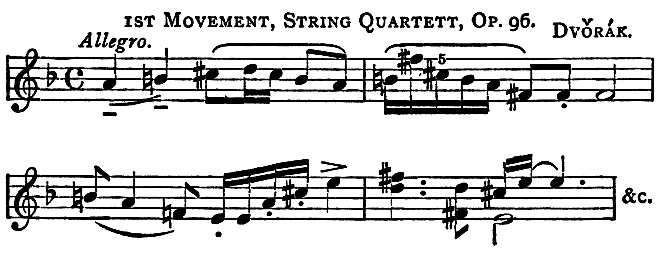
Finale, String Quartett, Op. 96.
Dvořák.

-128-
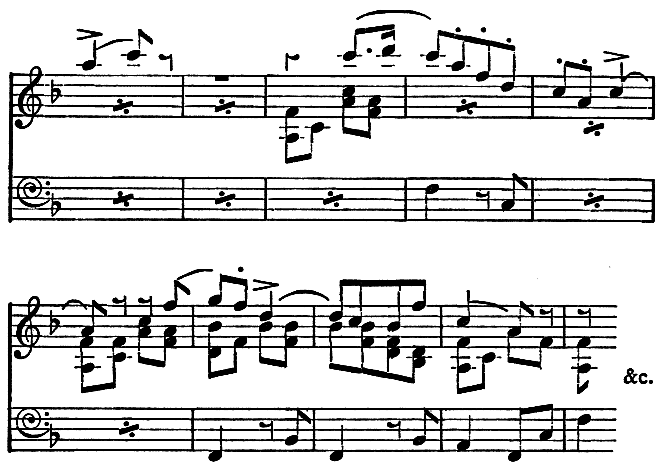
1st Movement, from “The New World Symphony.”
Dvořák.
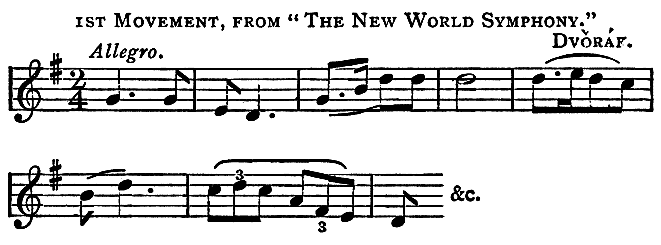
Of the String Quartetts that in E♭, op. 51, is the best known, and, along with the Negro Quartett from which quotations have just been made, is the most frequently performed. The second movement of the-129- E♭ Quartett is an exquisite example of the Dumka or Elegy, and is one of the most charming things which Dvořák has given to the world. The melodic substance of the work is chiefly Sclavonic in character, but the genius of the composer has transformed and ennobled that which otherwise would have remained as the rough material of a mere musical dialect. The other String Quartetts, which include op. 105 and 106, are less interesting, especially the A minor op. 16, and the D minor op. 34, in which the tunes and the general feeling are much below the usual standard of Dvořák’s works.
The Piano Quartett in D, op. 23 (Schlesinger, Berlin), may be recommended to amateurs in search of music which, while presenting no very serious executive difficulties, is full of charm. Dvořák has written nothing more delightful than the first movement, which commences with a quaint theme given to the ’cello, and of which much use is subsequently made. An interesting air with variations follows, and the work ends with a characteristic allegretto scherzando.
The other Piano Quartett in E♭, op. 87, is much more elaborate, and abounds with passages skilfully worked out, but the themes are of less interest and indeed at times almost commonplace.
-130-
Dvořák has written four Trios for piano, violin, and ’cello, all of which deserve to take high rank. The first, in B♭, op. 21, is spontaneous in style and feeling, reminding one indeed a good deal of Mendelssohn. The adagio is more characteristic of its composer, as are the allegretto scherzando and the finale. The whole work is well worthy of attention.
The second, in G minor, op. 26, is also an interesting work. The arpeggio passages in the first movement may perhaps be regarded as ungrateful for the stringed instruments, but the remainder of the trio is most effective, and were it for nothing else than the largo, a nobly expressed piece of emotional music, the trio should command the highest esteem. It is curious to notice that the opening phrase of the final allegro strikingly resembles in rhythm the finale of Schumann’s Piano Quartett in E♭, op. 47.
The Dumka Trio, op. 90, consists of six exquisite elegies expressed in the form from which the trio takes its name, each episode consisting of a slow pathetic movement, contrasted with a rapid and impetuous one. The work is the outcome of strong national feeling, and is sincere and convincing in its effect.
The String Sextett in A, op. 48, which has already been mentioned, is one of the compositions whereby-131- Dvořák’s name was introduced into England. “This sextett,” says Mr. Joseph Bennett, who was one of the first to recognise and urge the claims of this new voice, “is a good example of the new composer. Its plan and method, according to the late J.W. Davison, are altogether original; but this statement, while perfectly true, does not represent its full claim to the rarest of musical qualities. We find originality in the character of its themes, especially in those of the second movement (elegy), the third (furiant), and the fourth, which is an air (varied) of the broadest national type, and so puzzling in key that Mr. Davison is fain to describe it as ‘in more respects than one calculated to perplex the ear as to its absolute tonality though virtually in A major.’ Not less original than the themes are, in many cases, their harmonic treatment, while nowhere is the higher mission of music neglected, in virtue of which it appeals to an inner sense at the same time that it confers physical and intellectual gratification. The elaboration of the principal movements forms another striking feature in the work.... Some of the details confer upon it an exquisite piquancy and grace; and a first hearing of the entire composition involves a series of surprises, so unexpected and new are the abounding touches of the master’s hand.-132- Clearly we must know more of Dvořák, and that soon.” These words were written sympathetically and with prophetic insight in the year 1880, and since then we have heard The Stabat Mater, The Requiem, The Spectre’s Bride, the Orchestral Symphonies, and many other works, all of which have strongly confirmed the high hopes here foreshadowed.
In addition to what has been mentioned, the list of Dvořák’s chamber music embraces three String Quintetts, a Serenade for wind and strings, op. 44, a Trio for two violins and viola, op. 74, a Sonata for piano and violin, op. 57, and a Quintett for piano and strings, op. 81, in A major. The last-named consists of four movements, viz., an allegro, a dumka, a furiant, and a finale in rondo form. The work is full of vitality, and rich in those qualities which appeal alike to intellect and heart.
That Dvořák is occasionally prodigal of his musical means and lacking in restraint is no doubt to a certain extent true, but, in the words of Mr. W.H. Hadow, “for all this he is a true genius, true in thought, fertile in imagination, warm and sympathetic in temper of mind. He has borne his part in a national cause, and has thereby won for himself a triumph that will endure. He has enriched his people, and in doing so has augmented the treasury of the whole world.”
-133-
CHAMBER MUSIC OF THE RUSSIAN COMPOSERS.
Russian chamber music — Glinka — Quartett by Ippolitoff-Ivanoff — Quartett by Gretchaninoff — Mozart on melody — Russian schools of musical thought — Belaieff — String Quartett on name Belaieff — Arensky — Trio in D minor: Arensky — Sokoloff — Tanyeëff — Kopyloff — Tschaïkovsky.
A comparatively unexplored field presents itself in the chamber music by Russian composers. Ippolitoff-Ivanoff, Kopyloff, Sokoloff, Gretchaninoff, these are a few of the almost unknown names of this school. No doubt certain chamber works by Tschaïkovsky, Arensky, and one or two others are a little known in England, but those of the composers named hardly at all. Glinka, César Cui, Rimsky-Korsakoff, Liadoff, Glazounoff, and Tanyeëff are also composers whose chamber music is deserving of serious attention, for recent musical history contains nothing more interesting than the progress of Russian music.
-134-
Glinka (1803-57) is usually regarded as the founder of the movement, but his chief works are operatic. He was a man of remarkable character, and did a great work for the welfare of music in Russia. His opera, Life for the Czar, marks an epoch in the national artistic life. Apart from his operas, however, he did not write a great deal, his chamber music being limited to a Septett, two String Quartetts, and a Trio for piano, clarinet, and oboe. Some of his orchestral pieces are remarkable. He took a deep interest in this kind of composition, and being a man of progressive mind he shook off the ordinary conventional methods; and his works show this in details such as quitting the routine which had previously made the first violins always play above the seconds, and these above the violas. He was also in the habit of calling the wind instruments “orchestral colour,” and the strings “orchestral motion.”
Russian orchestral music (notably Tschaïkovsky’s Pathetic Symphony, and other of his works) has, chiefly by the efforts of Mr. Henry J. Wood and the Queen’s Hall Orchestra, become familiar amongst us, and by the use of strong colour and highly emotional effects, such music has no doubt obtained much attention, but it is very doubtful if we yet know the best about this Russian school, for an-135- examination of the chamber music of the composers named above, reveals a surprising number of works, written with true feeling and the highest technical skill. Some of these shall be referred to in detail, but it may be observed that many of these composers are manifestly influenced by, and have gathered up into classical form (as did Haydn, and, to name a modern instance, Grieg), the folk music of the common people. There seems to be an immense wealth of this kind of musical material to be found in Russia, often couched in quaint, irregular rhythms, but full of a weird charm, even though strange to Western ears. That such material should appeal strongly to the musicians of a race so powerfully affected by their emotions as are the Sclavs is what might be expected, and as the supply is said to be practically inexhaustible and often of considerable artistic beauty, the further developments in this direction will be watched with keen interest.
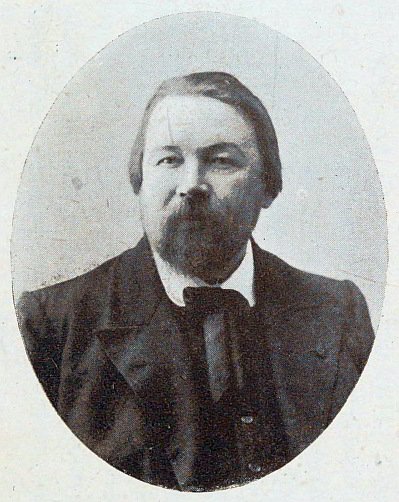
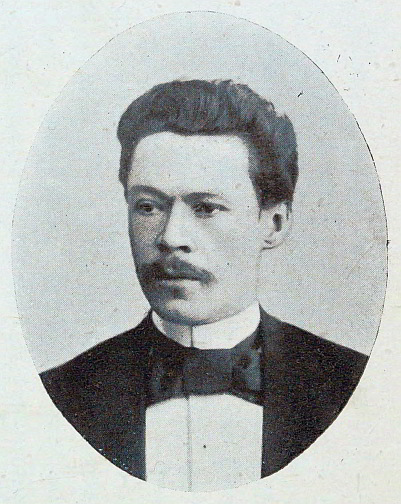
Our first example is a String Quartett in A minor, op. 13, by Ippolitoff-Ivanoff (Jurgenson, Moscow). It has been said that the Sclav temperament is one of “fiery exaltation on a basis of languid melancholy.” Ivanoff’s quartett, in a measure, illustrates this, for it opens with a sorrowful passage of much intensity, which, in its feeling (not the notes), reminds one of the Tristan-136- Prelude of Wagner. The entry of the two violins on one note, and the poignant effect which immediately results as they separate a semitone, is a marked and original feature of the whole work, and may indeed be regarded as its “motto.” It reappears at the end of the first allegro, and again, in fuller form with fine effect, just before the coda of the finale. The commencement of Tschaïkovsky’s String Quartett in F, op. 22, has a certain kinship to this, but the treatment and the effect are quite different. The same may be said as to the beginning of his Quartett op. 30 in E♭ minor.
Ippolitoff-Ivanoff, Op. 13.
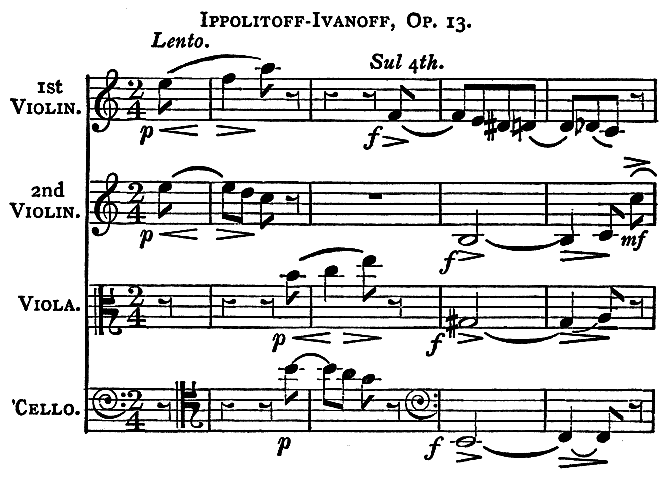
-137-
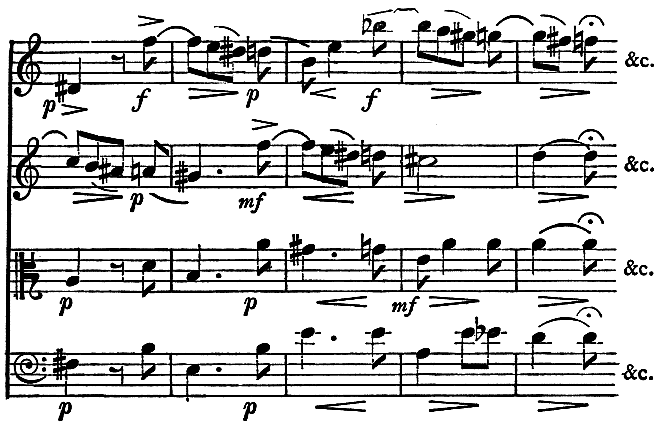
After some thirty bars of this introduction the first movement proper, an allegro, begins with the following theme, in which it must be admitted there is a certain excess of the semiquaver movement, used in a fragmentary manner as an accompaniment to the leading ideas:—
Ippolitoff-Ivanoff, Op. 13.
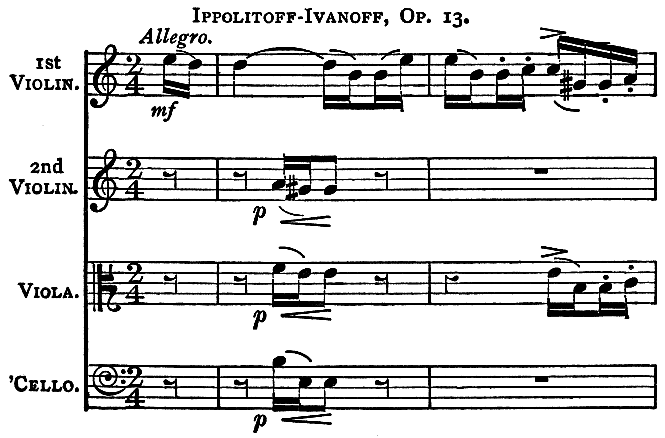
-138-

This is followed by the second theme, a somewhat quaint people’s song kind of tune, played by the first-139- violin and viola in octaves, the second violin keeping up the semiquaver rhythm just referred to, and the ’cello playing quavers pizzicato.
Ippolitoff-Ivanoff, Op. 13.

After a considerable amount of interesting development the movement is brought to a close with the motto theme, lento pianissimo, thus:—
Ippolitoff-Ivanoff, Op. 13.
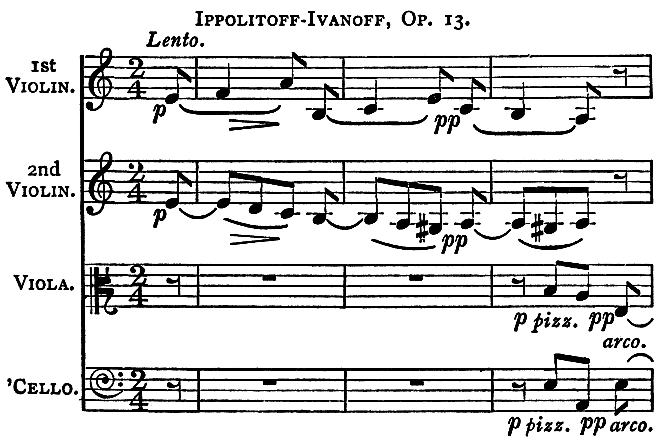
-140-
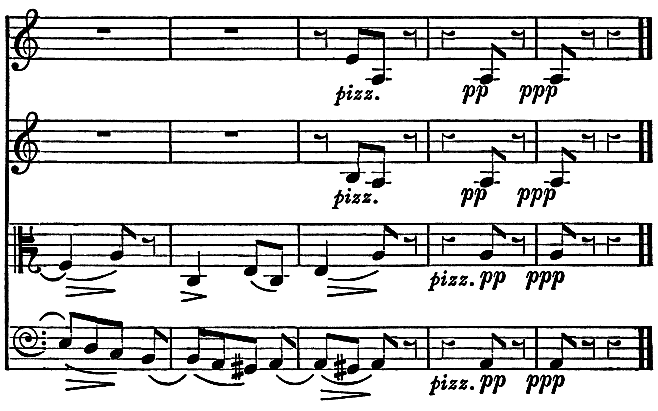
The lento quoted above consists of twenty-one bars, of which only the last eight are here given. The second movement is entitled “Humoresca-Scherzando.” It has two principal themes, the first busy and jocose as becomes such a movement, the second of volkslied flavour and in good contrast to the first:—
Ippolitoff-Ivanoff, Op. 13.
No. 1.
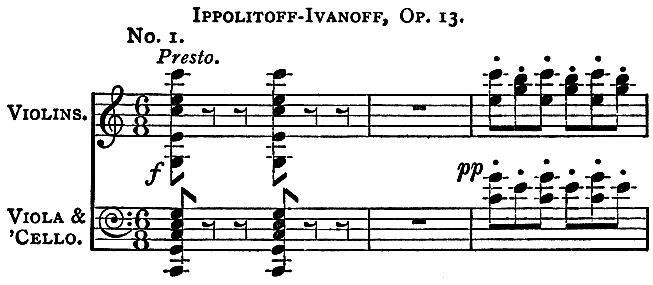
-141-
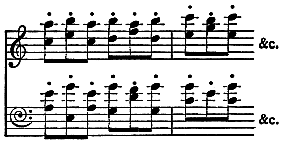
No. 2.
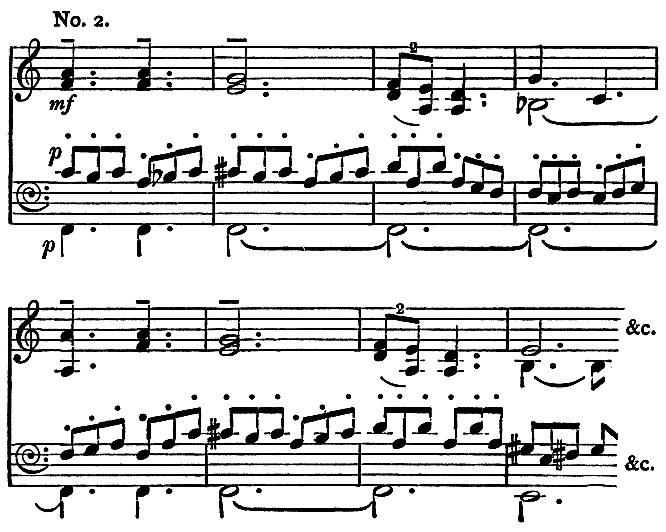
Between this scherzo and the finale stands an intermezzo (allegretto grazioso). The melody is played by-142- the first violin, which, along with the second violin and viola, is muted while the ’cello plays a pizzicato counterpoint. This is a graceful and pleasing movement, and if less characteristic than the others, it affords a well-calculated change of effect. The last movement (allegro risoluto) begins with a bold passage in A minor (No. 1), joined a little later on to a contrasted phrase (No. 2), of which much is subsequently made.
Ippolitoff-Ivanoff, Op. 13.
No. 1.
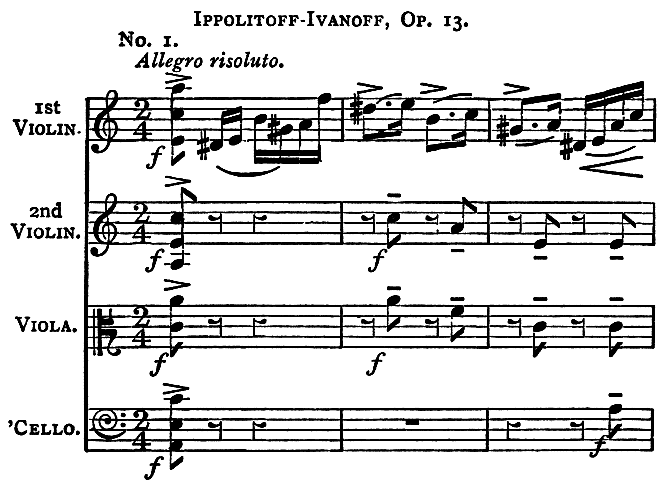
-143-

No. 2.
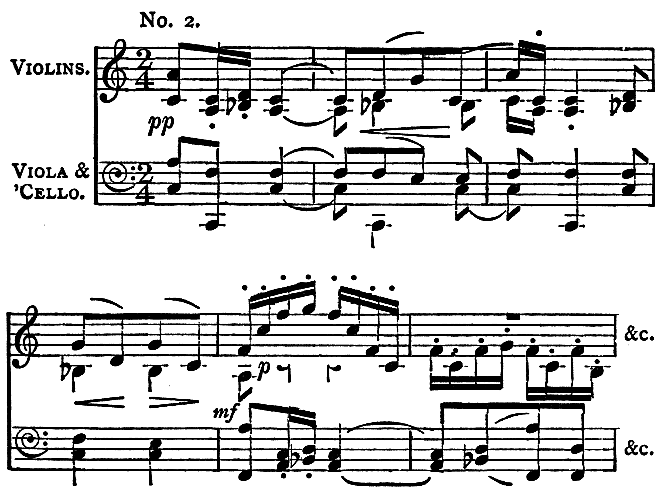
-144-
Later on another theme appears, which is worked along with those already mentioned, and the Quartett concludes with a condensed version of the introductory lento, or motto theme, merging into a rapid coda of some thirty bars, based on the opening theme of the allegro. It will hardly be gainsaid that we here have an interesting work, which, if not absolutely great, is worthy of attention both for its own sake and as an object lesson, showing as it does, what is being done by a nation whose music has already exerted a powerful influence on the art.
Our second example is a String Quartett in G major, op. 2, by Alexander Gretchaninoff.
According to some authorities the String Quartett as an art-form has not advanced since Beethoven, he, it is asserted, having said the last word in this style. While it may be admitted that there is a good deal of warrant for this assertion, and that an analysis of Beethoven’s Quartetts, from the op. 18 to say the C♯ minor op. 131, reveals a wealth of musicianship which is no doubt disconcerting to the modern aspirant, yet it is hardly a sufficient reason why this particular source of musical inspiration should be regarded as closed, and that the man of to-day should cease writing. There is still at any rate one way in which a composer may-145- justify himself. He may, if he can, write genuine tunes.
Doubtless a sound knowledge of the multiform devices of harmony, counterpoint, and the rest, is an important part of his equipment. But such knowledge may be acquired; whereas, if devoid of true tune, his best efforts are doomed to failure, for this tune-faculty is born with the man, and cannot be learned from books.
Mozart indeed settled the question, once and for all, when he said “melody is the essence of music.” If we open at random the pages of works so dissimilar, say, as Handel’s Messiah, Wagner’s Parsifal or Bach’s Forty-Eight,[34] what are we sure (among a host of other things) to find? Is it not melody? It may not be the conventional eight-bar tune, but in the true sense of the word it is sure to be melody. No doubt the words “tune” and “melody” have been used in a too restricted sense, and against this we must guard ourselves, for melody in reality represents the chief idea in music, and no art is worth much whose ideas are weak. Take, for example, Beethoven’s C minor Symphony. No one would call that musical battering-ram with which the work commences—
-146-
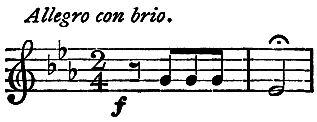
a tune, in the usual meaning of that word; but, all the same, it is a musical idea full of real vitality, which clings to the memory with all the power of the finest tune that was ever written. It is in this light that the later works of Beethoven, and, to name another of the giants, those of Brahms, should be viewed.
No doubt a composer may produce certain effects by progressions of harmony which can hardly be regarded as a tune. For example, the following motive from the first act of Wagner’s Götterdämmerung:—
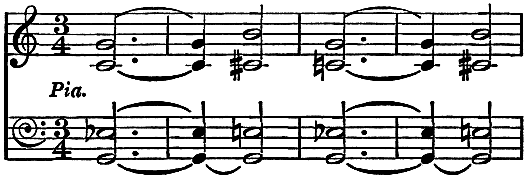
To call this a tune would be straining language, but none the less if a composer be possessed of what we call genius, such phrases will (as this does) produce on the mind of the listener an effect in all respects as vivid as that which the most fully developed melody produces under other musical conditions. The idea of a true composer is strong, and therefore it succeeds.
-147-
But it will doubtless be in the reader’s mind to ask what all this has to do with a String Quartett by an unknown composer. This merely, that without claiming for him the most exalted rank, Gretchaninoff possesses the gift of tune, and on this account, as well as by reason of his sound musicianship, what he has done deserves attention.
This Quartett, op. 2, is in classical form, and consists of the usual four movements. It commences with a short andante, whose opening phrase, played by the four instruments in unison, is:—

As in the Ivanoff Quartett previously noticed, we have here, in the first three notes of this quotation, a motto theme. This, when the first movement proper (allegro) is reached, is given out by the ’cello alone in the following complete form:—

and it is frequently met with in various shapes during the progress of the movement. Its first three notes, modified in this way—
-148-

are skilfully used in the scherzo to form a connecting link with the passage which leads from the moderato to the repetition of the presto. Also it is found at the commencement of the vivace movement with which the work ends.
The second theme of the opening movement may also be quoted, exemplifying as it does what has been said about the melodic interest with which Gretchaninoff invests his work:—
Gretchaninoff, Op. 2.

-149-
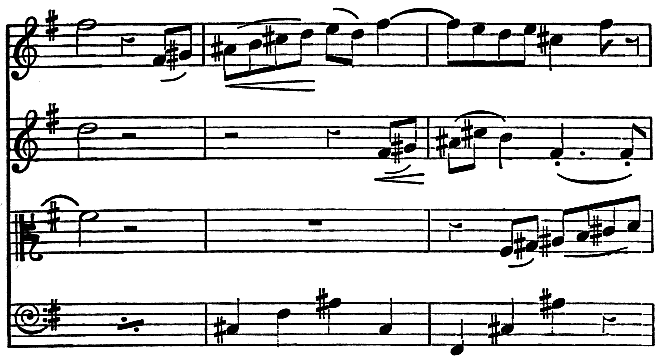
The almost Italian feeling and freedom of expression here will not escape notice; also that while there is no lack of scholarship, it is only used as a means to an end.
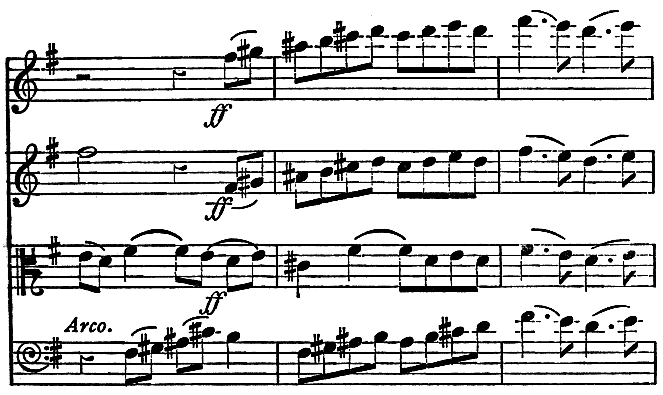
-150-

The second movement commences thus:—
Gretchaninoff, Op. 2.
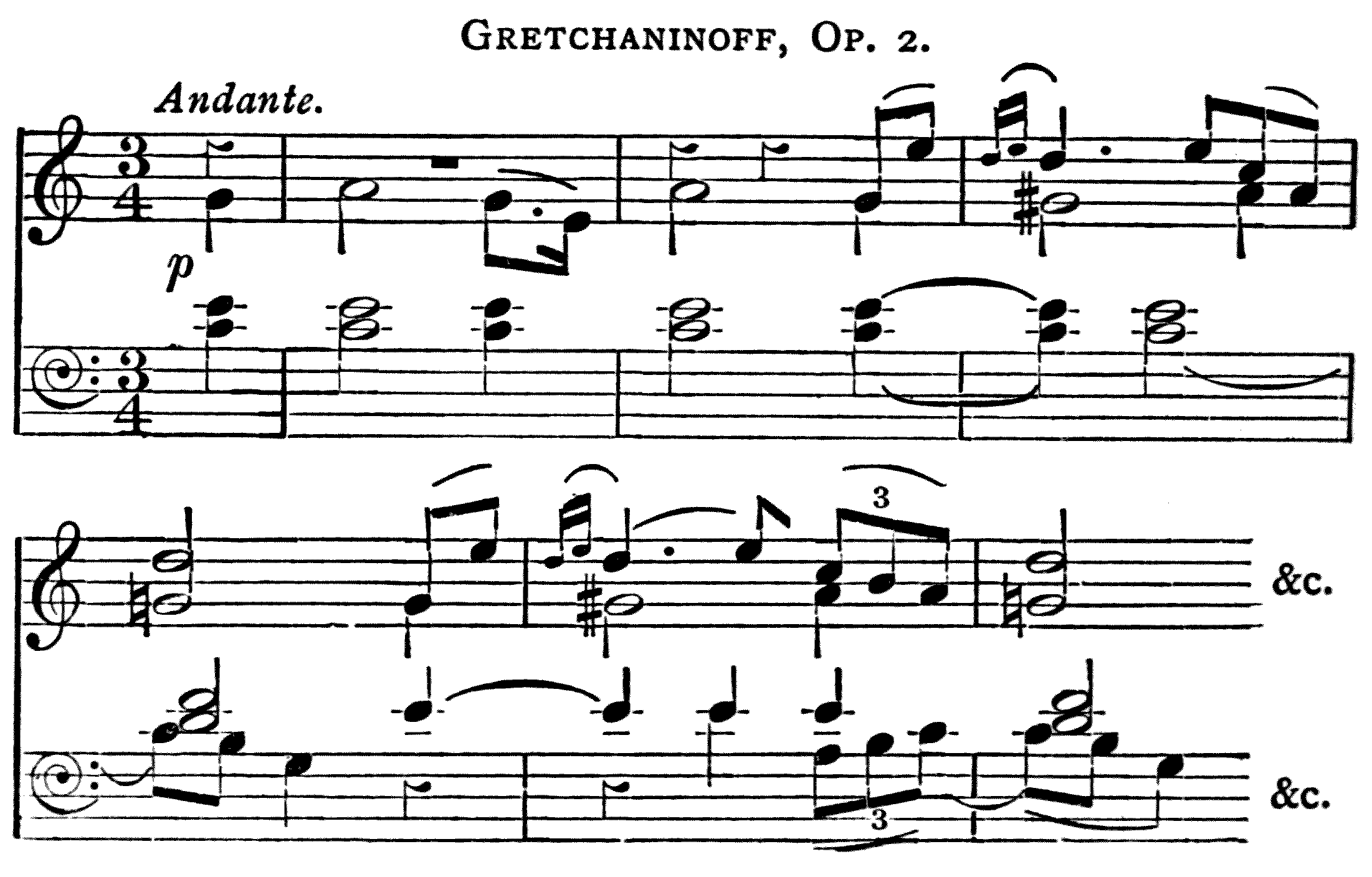
-151-
This leads to a charming second theme which speaks for itself:—
Gretchaninoff, Op. 2.
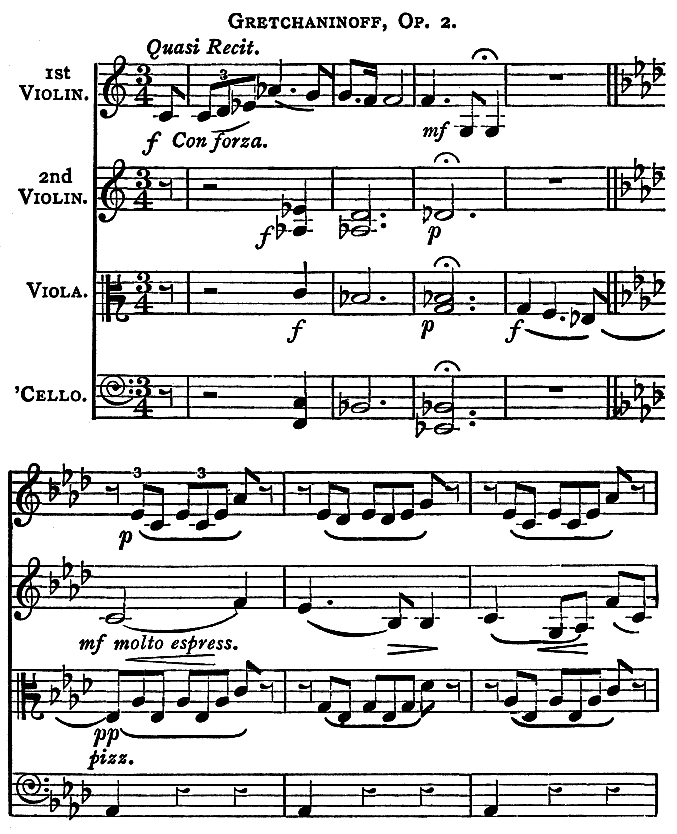
-152-
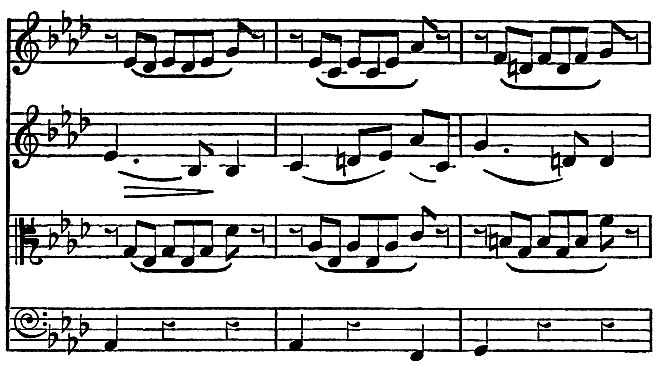
The remarks on page 149 apply with equal force to the melody played by the 2nd violin in the above extract.
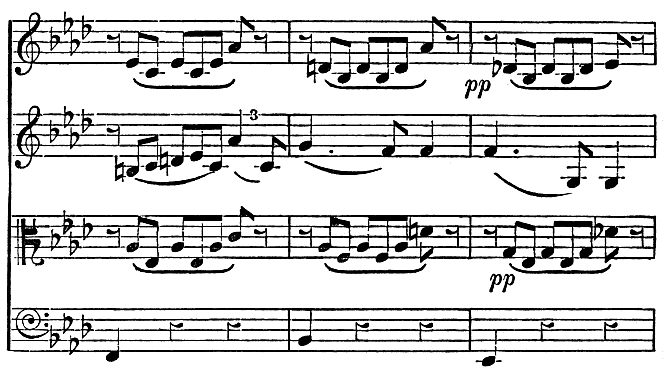
-153-

The third movement is a scherzo, full of life and vivacity. Its first theme, given out by the viola, is heard after a few bars of introduction, thus:—
Gretchaninoff, Op. 2.
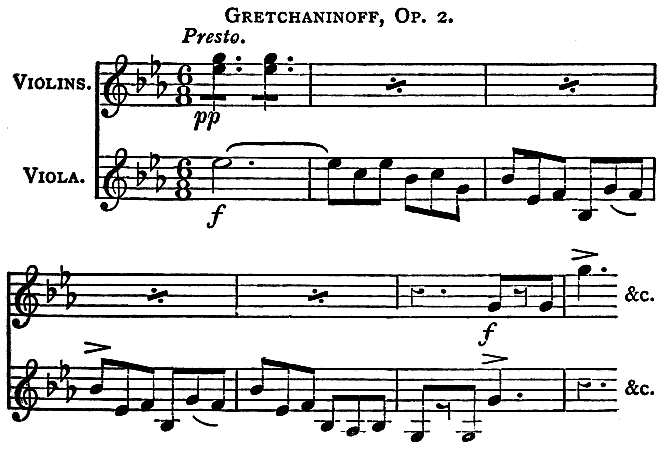
-154-
This is developed, with much spirit and variety of treatment, until with slackened speed it merges into a “moderato e tranquillo,” to which reference has been made as containing, near its close, the “motto theme.” After this the first subject of the scherzo is resumed, and the movement runs on to a climax, in which, with excellent effect, the original theme is given out by the violins in octaves.
The finale commences with a slow introduction, whose first notes are made up of a unison passage in the minor mode, which is closely akin to the motto theme. At the commencement of the vivace which follows this introduction we again have the motto in the major mode:—
Gretchaninoff, Op. 2.
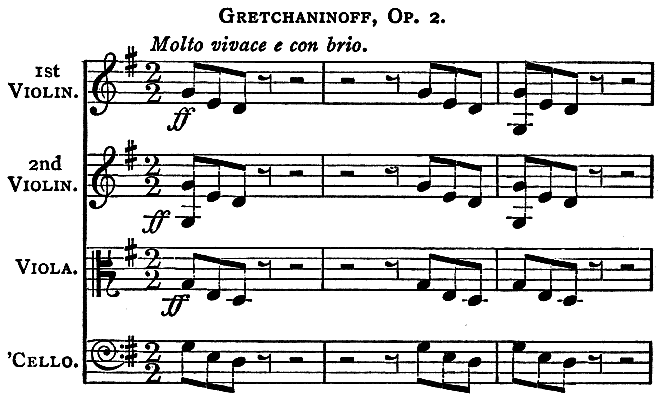
-155-
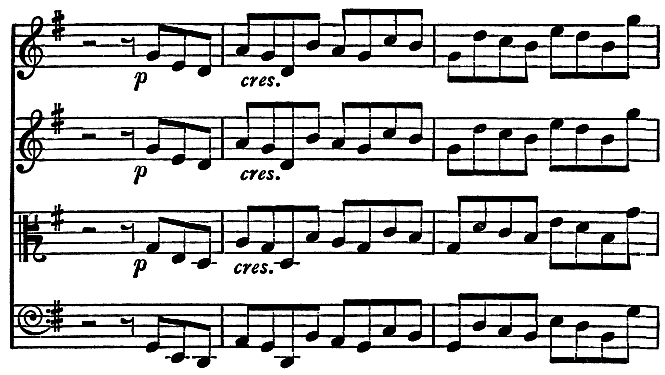
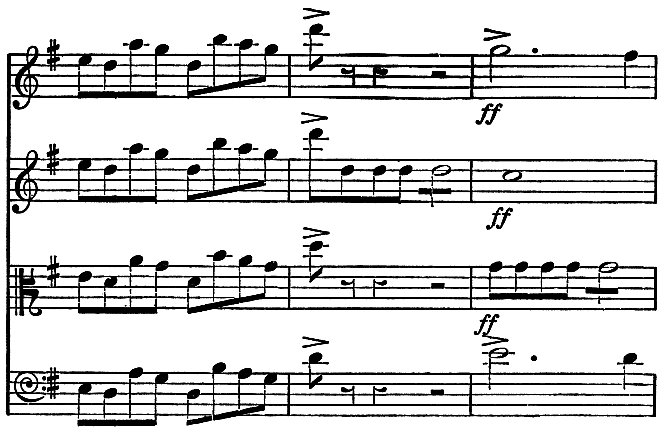
-156-
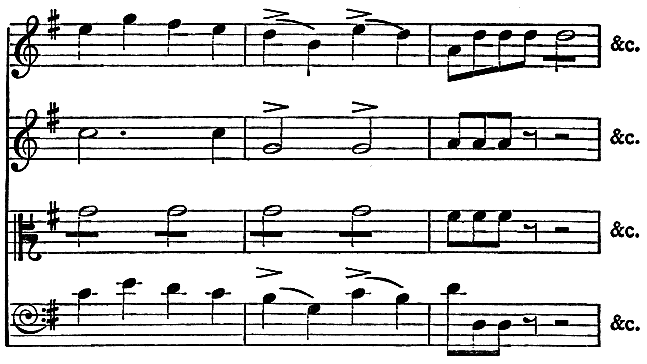
Of this theme (the motto) in various forms much use is made during the course of the finale. Here, for instance, is an interesting passage, the latter part of which (meno mosso) is a metamorphosis of this theme:—
Gretchaninoff, Op. 2.

-157-
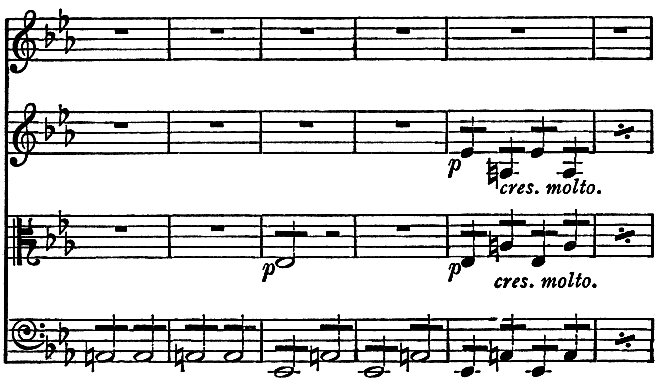
The almost orchestral effect of extended unison passages such as this and the previous example is perhaps hardly admissible in the chamber music form. Yet in the works of the classical masters (Cherubini, for instance) such passages may at times be found.

-158-
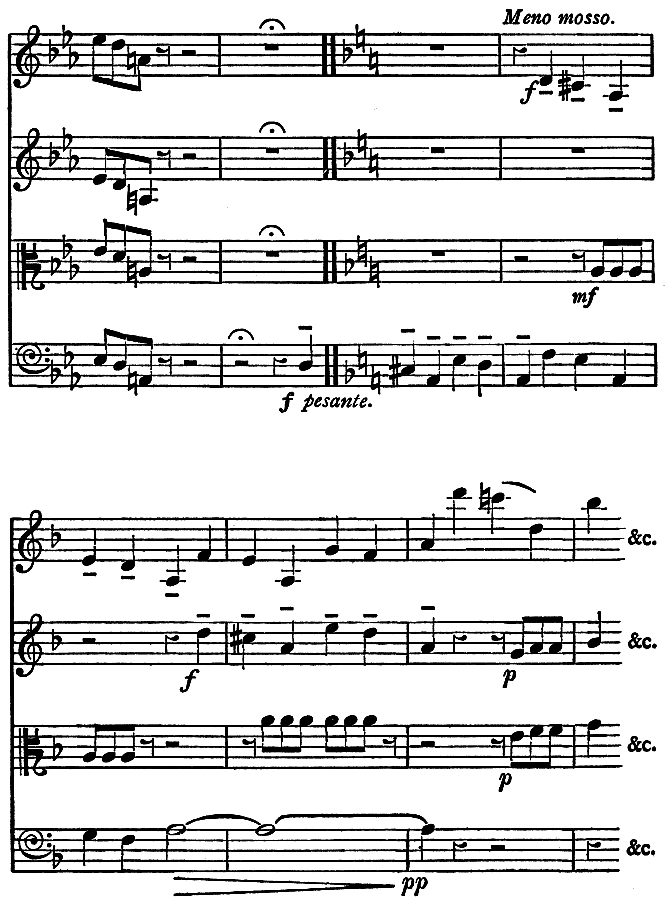
-159-
Later in the movement the viola, with a quiet persistence which runs on for a number of bars, repeats this same theme thus:—
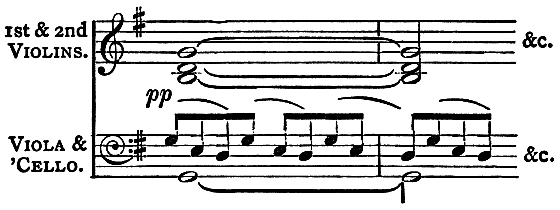
Another theme of melodious character may also be quoted. It appears first in the key of E♭, and later in G, and, along with what has been mentioned, constitutes the principal subject-matter of the movement which ends this interesting Quartett. The following is the theme as it first appears:—
Gretchaninoff, Op. 2.

-160-


-161-
As regards the composer of this Quartett, it may be added that Le Ménestrel of July 13th of the year 1902 announced “that a new opera, entitled Nikita Dobriniez, by a young and unknown composer named Gretchaninoff, will be produced in St. Petersburg during the coming winter season.”
The two chief cities of the Russian Empire, St. Petersburg and Moscow, have each had its representative school of musical thought, the one at first working almost entirely for the advancement of a purely national style, the other, with a more eclectic taste, favouring outside ideas and influences.
Tschaïkovsky was the leader at Moscow, having for his adherents Arensky, Rachmaninoff, and Siloti; while Rimsky-Korsakoff, Balakireff, Borodin, and others represented the more conservative St. Petersburg. But along with this external division of interests there always prevailed the utmost unanimity and a genuine feeling of brotherhood, and one result of this may be found in their working together, in a quite intimate way, in the composition of works like the String Quartett based on the notes B A F, which is the joint production of Rimsky-Korsakoff, Liadoff, Borodin, and Glazounoff.
The story runs[35] that in the year 1881, at St. Petersburg,-162- a certain M. Belaieff, a wealthy and enthusiastic amateur, happened to be present at the rehearsal of the first Orchestral Symphony by Alexander Glazounoff, and was so much impressed by its fine qualities that he decided to remove what had hitherto been a difficulty and establish a music-publishing house, which should have for its object the issuing of Glazounoff’s works and those of other composers of this Russian school. He, indeed, proved himself a very Mæcenas, organising concerts in and out of Russia, and never tiring in his endeavours to gain a hearing for the composers whose cause he had thus so practically espoused.
No wonder, therefore, that they should desire to do him honour, and in this Quartett we find one such act of homage. As most musicians are quite well aware, the note B♭ is in Germany called B, and B♮ is called H; hence the possibility of writing, as has several times been done, a fugue whose subject is the name of the great composer Bach.

B A C H
In like manner these Russian composers took the three syllables of the name of their friend Belaieff, and,-163- Be standing for B♭, la for the sixth note A of the natural scale, and eff for the note F, they used the theme—

B la F
as the leading motive of a composition, consisting of (1) an Allegro by Rimsky-Korsakoff, (2) Scherzo by A. Liadoff, (3) Serenata alla Spagnola by A. Borodin, and (4) Finale by A. Glazounoff. The composition begins in this manner:—
N. Rimsky-Korsakoff.
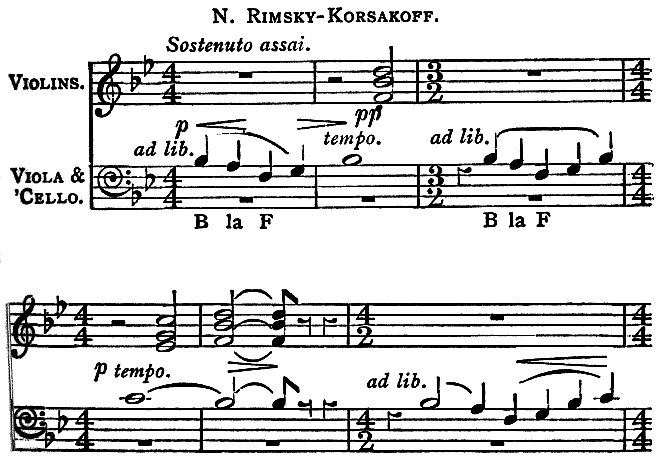
-164-
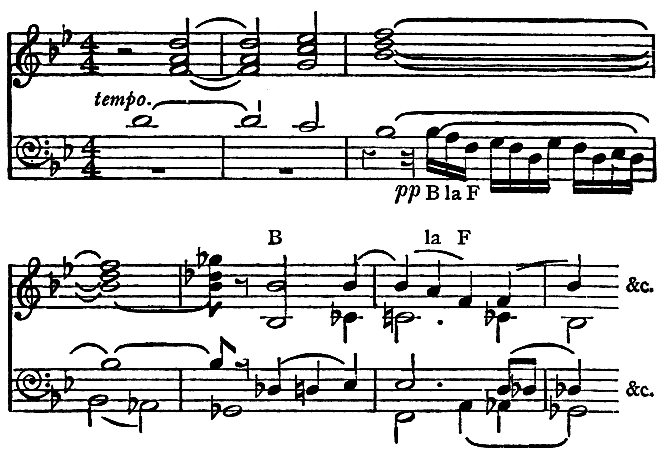
B la F
Leading to the Allegro:—
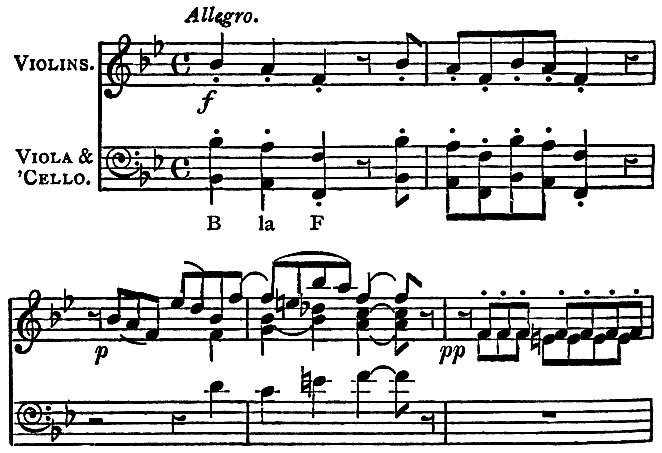
-165-

B la F
The second movement, a Scherzo, commences thus:—
A. Liadoff.
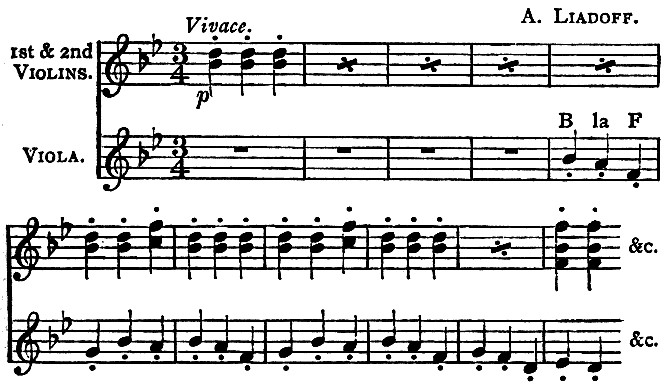
The usual Trio, which follows, commences thus:—

-166-
After this the Scherzo is repeated, with considerable development.
This is the third movement, written, as the name indicates, in the Spanish style:—
Serenata alla Spagnola.
A. Borodin.
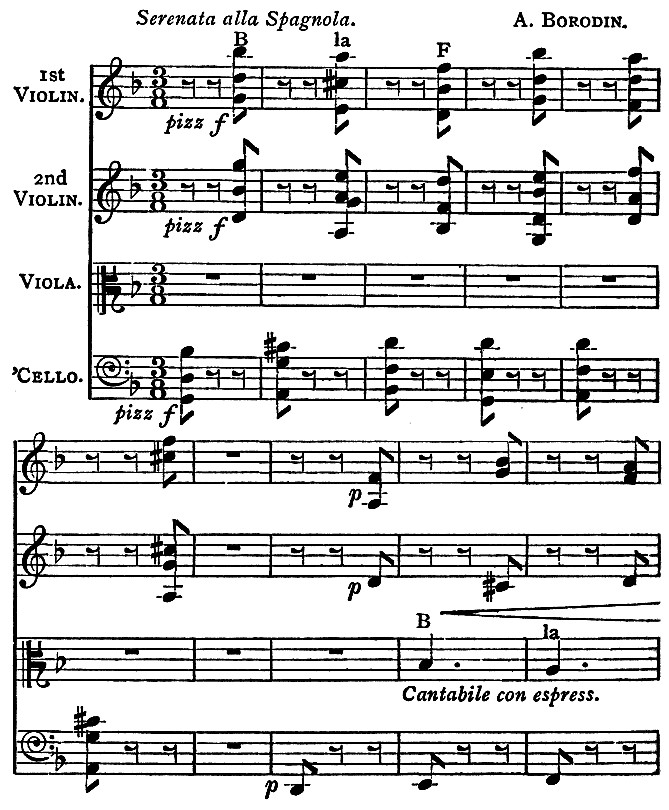
-167-
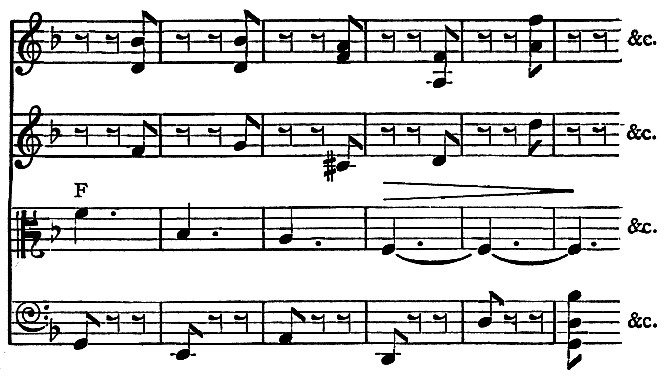
The last movement (allegro), which is perhaps the least satisfactory of the set, commences somewhat after the manner of the introduction by Rimsky-Korsakoff, but subsequent treatment is different.
A. Glazounoff.
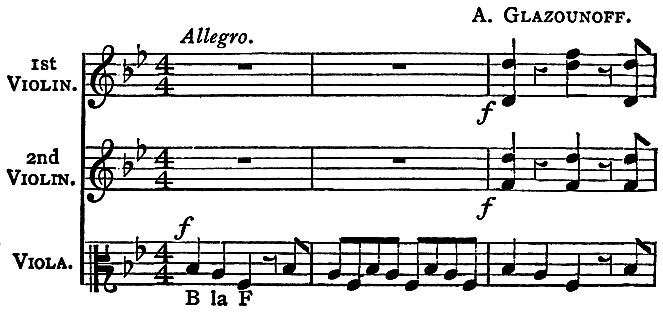
-168-
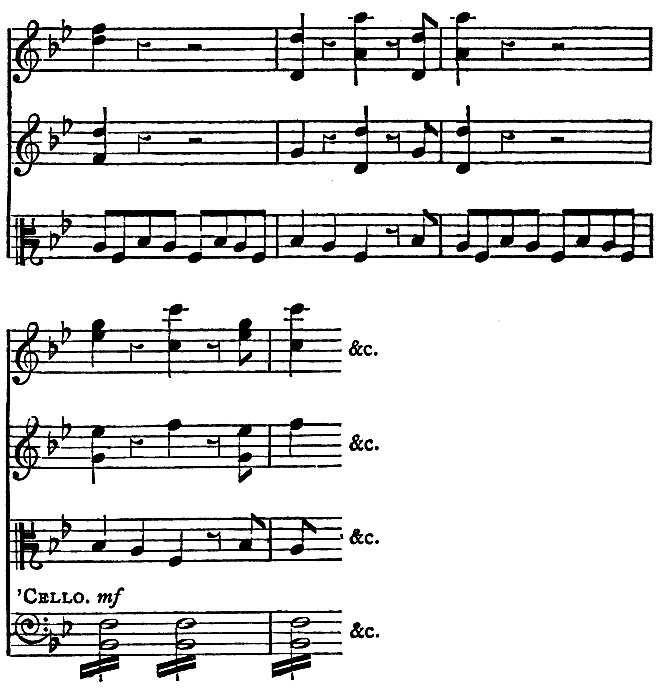
A composition of this kind is obviously more of a curiosity than a work of the highest art; but an examination of the score reveals a surprising amount of skill, and, considering the restrictions under which they wrote, the several composers have contrived to invest-169- the Quartett with much more melodic interest than at first seems possible.
Other Russian composers who were associated with Belaieff have written works on the same theme, among these being a Serenade for String Quintett by Nicolas Sokoloff; and by A. Kopyloff an Andantino, and a Prelude and Fugue, both for String Quartett.
![Ihr ergebener Richard Wagner [signature] Ihr ergebener Richard Wagner [signature]](images/wagner_signature.png)
Another work, which is, however, written much more in the idiom characteristic of the Russian school than that which has just been named, is the String Quartett in A minor, op. 35a, dedicated to the memory of Tschaïkovsky, by Arensky.
Anton Stepanovitch Arensky was born at Novgorod in the year 1862, and studied for some time with Rimsky-Korsakoff; but, whilst acquiring a sound knowledge of technique, he does not appear to have been very largely influenced by that composer’s ideas. He is rather to be reckoned as belonging to the eclectic school of Tschaïkovsky, with whom he was subsequently associated for many years in Moscow. He has composed two operas, of which the first, A Dream on the Volga, is of considerable dimensions; also a Ballet and two Symphonies,-170- besides a large number of piano pieces of varying merit. In these he displays considerable ingenuity, but unfortunately the effect is not always spontaneous; in fact, it seems as though he sometimes sets out to startle, without due thought as to whether it is worth while. Amongst his best works should be mentioned three Suites for two Pianos Concertante, afterwards orchestrated by the composer, of which the second, entitled “Silhouettes,” has attained a well-deserved popularity. His activity as a teacher is also very great, and he has produced some valuable theoretical works. Amongst the many musicians who have passed through his hands must be mentioned Sergius Rachmaninoff, one of the most promising members of the younger generation of composers.
The Quartett, op. 35a, was originally composed for violin, viola, and two ’cellos, and afterwards re-written for the usual combination. Far from its losing by the change, its heaviness is considerably relieved and its value enhanced. It is dedicated to the memory of Tschaïkovsky, the material being taken from the Greek orthodox liturgy, from Tschaïkovsky’s own works, and from national sources.[36]
-171-
The work opens thus:—
Arensky, Op. 35a.

A little farther on this is repeated in slightly varied form, with a fresh theme played above it by the first violin:—
Arensky, Op. 35a.
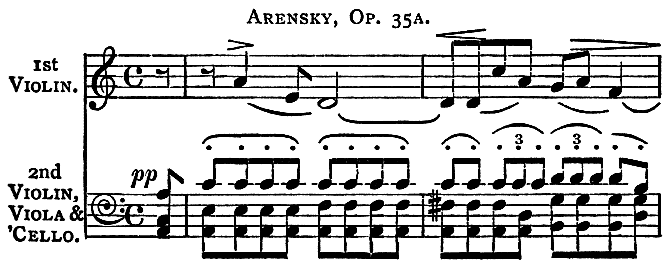
-172-

This, with further variation and another theme of an equally melodious and elegiac character, constitutes the basis of the first movement, which after considerable development ends pianissimo with a repetition of the opening theme. An air, quoted below, obviously of the volkslied order, treated in variation form, constitutes the second movement, and presents numerous points of interest. The coda, for instance, commences with four bars of chords of harmonics played by the four instruments. This leads on to a repetition of the elegiac theme with which the Quartett begins, and then-173- the movement ends with certain quaint allusions to the theme quoted above.
Arensky, Op. 35a.
Theme.
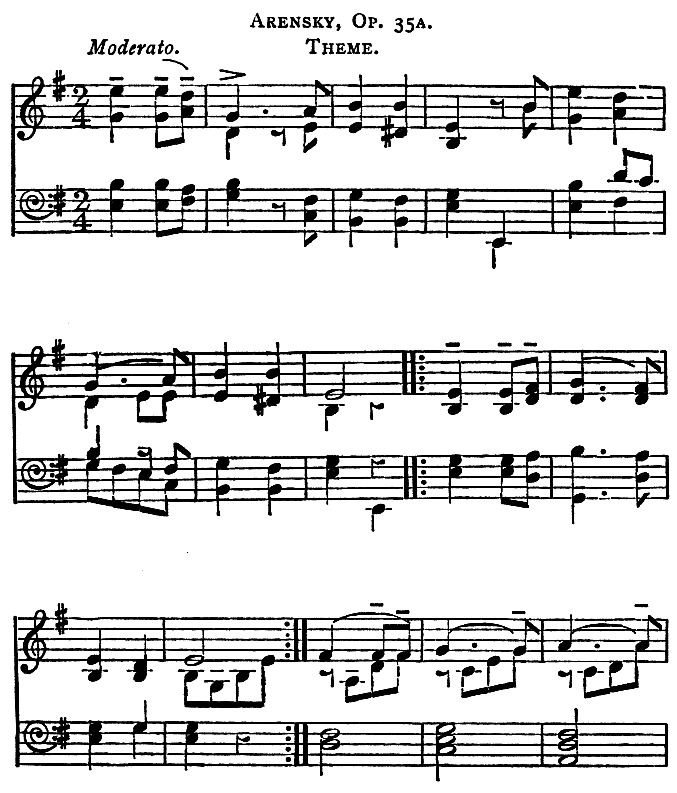
-174-
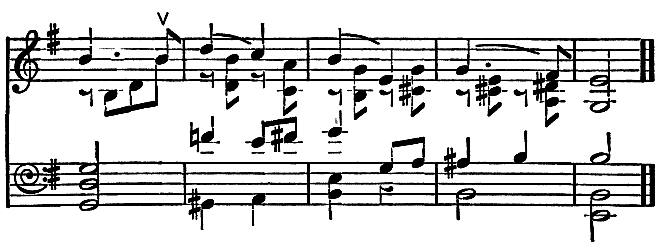
The finale, which is in free fugal form, with an introductory andante and a short adagio episode, brings this interesting work to a conclusion.
Another composition by Arensky is the Trio in D minor, op. 32, for piano, violin, and ’cello, inscribed to the memory of the ’cellist, Charles Davidoff, who was the principal of the Conservatoire at St. Petersburg. It was played at the Monday Popular Concerts in 1896 by Sapellnikoff, Joachim, and Paul Ludwig. It is well written, but, save as to the elegiac slow movement, not touched with the usual Sclav feeling, nor is the melodic material, although pleasant enough, at all remarkable. In a still greater measure the same judgment applies to this composer’s Quintett, op. 51, for piano and strings, an elaborate and high-sounding but really somewhat empty composition.
Other chamber music works of this school which may be mentioned are:—
-175-
(1) A String Quartett in F, op. 7, by Nicolas Sokoloff, a St. Petersburg musician, born in the year 1858. The first movement of this work is well characterised, and contains some remarkable imitative writing. The whole Quartett, if not great, is certainly worthy of attention.
(2) A String Quartett in D minor, op. 7, by S. Tanyeëff, which consists of two movements only, the second being a notable set of eight variations, with a coda which is based on the principal theme of the first movement. Tanyeëff, who was a pupil of Tschaïkovsky, is now professor of harmony and composition in the Conservatoire of Moscow.
(3) A String Quartett,[37] op. 15, by Alexander Kopyloff, one of the staff of the Imperial Chapel in St. Petersburg. This work is much simpler in construction than the others. It may be recommended to amateurs as a pleasant and quite practicable, if not very distinguished, composition.
Another work which cannot be omitted in a notice of Russian chamber music is the Trio for piano and strings, op. 50, by Tschaïkovsky; a lengthy and deeply brooding work of highly impressive character, which is already well known in England.
-176-
Tschaïkovsky (1840-93) was the most distinguished of the modern Russian school of composers, and a musician of remarkable originality and power. He was educated for the legal profession, and entered the Government Civil Service, but the musical impulses asserted themselves with such force that in 1866, having first seriously studied for some time, he henceforth devoted himself to the musical profession.
He was deeply imbued with the national influences of his country, and did what he could to foster and develop them. “His music shows the strange and violent contrasts of mood characteristic of his race; now full of a wild and barbarous energy and fiery intensity; now of almost maiden tenderness and ingenuousness; now of a black and hopeless melancholy.”[38]
Tschaïkovsky’s chamber music consists of a String Sextett, op. 70, three String Quartetts, the Piano Trio named above, and a number of compositions for piano and violin, piano and ’cello, and piano alone.
-177-
RICHARD STRAUSS AND ANTON BRUCKNER.
Position with regard to classical form — Strauss’s chamber music — Bruckner’s character and individuality — Bruckner’s symphonies — String quintett in F major — Hanslick on Bruckner’s works — Krehbiel on Bruckner’s Seventh Symphony — Weingartner’s opinion.
Richard Strauss, born at Munich in 1864, is without doubt one of the most distinguished of living musicians, and although his recent works are written in a very advanced style, it cannot be said that he has arrived at this condition without due deliberation, for his earlier compositions are all in classical form, and his present position is therefore due to growth rather than to a wanton setting aside of the established forms in which the great masters wrought. It is only when we come to the symphonic poem “Don Juan,” op. 20, that we find him embracing the programme music ideal, and all the seven large works which have since appeared are fashioned after this kind.
-178-
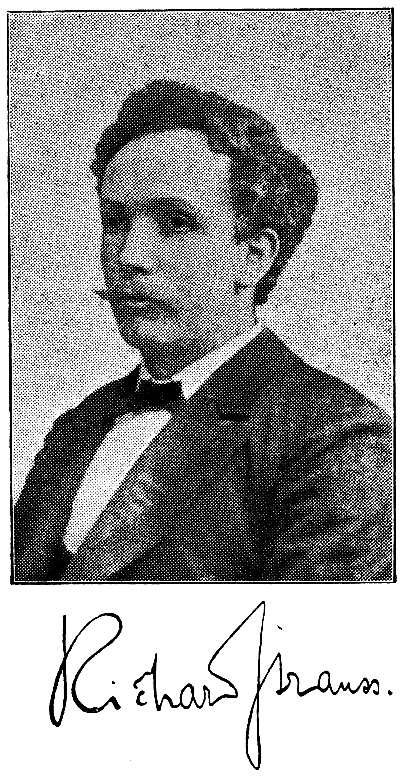
That Strauss displays an enormous talent for orchestral effect, and a breadth and vigour of style which carries all before it, no one acquainted with his works will dispute, but whatever abiding hold he may have gained on the musical thought of the world will be found not to be primarily due to qualities of this kind, influential as they no doubt are, but to his being endowed with the power to write true and convincing tunes. For example, one may regard programme music and the hurly-burly of works like Till Eulenspiegel as entirely obnoxious and subversive-179- of true art, but all the same it is idle to ignore the character and charm of such tunes as these:—
Till Eulenspiegel.
R. Strauss.
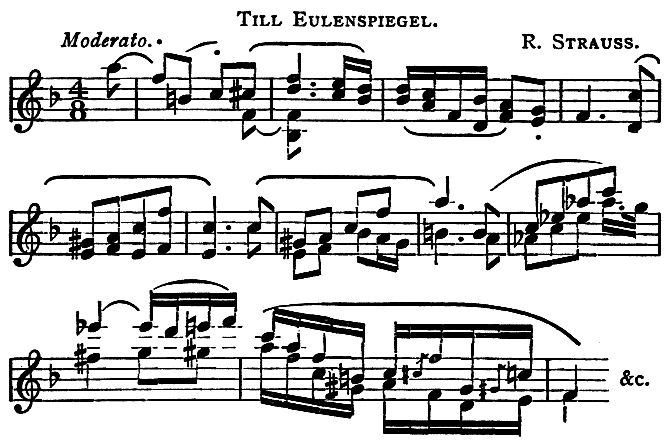
With the following curious metamorphosis of its first notes, which plays an important part in the work:—

Till Eulenspiegel.
R. Strauss.

-180-

Don Juan.
R. Strauss.
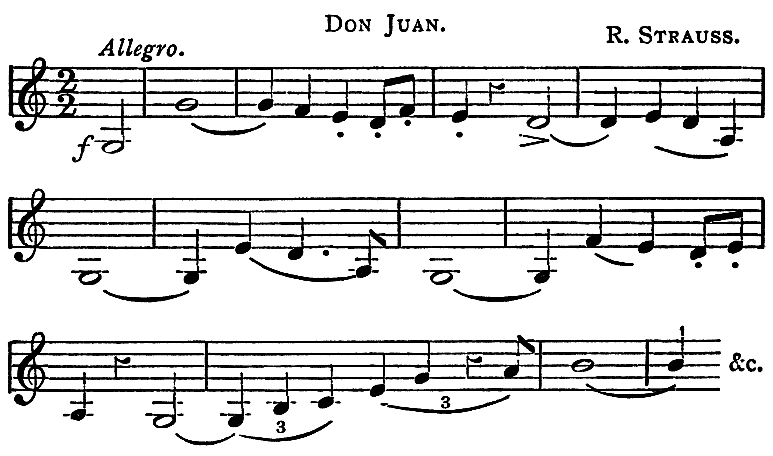
The earlier Symphony of this composer, in F minor, op. 12, exhibits also, although in a lesser degree, the same melodic charm; but on the other hand (and such inequality is a perplexing feature of Strauss’s works) his chamber music, such as the String Quartett, op. 2, the Piano Quartett, op. 13, and the Violin and Piano Sonata, op. 18, when tried by this standard, are more or less disappointing. True, the andante and the finale of the String Quartett show a certain amount of melodic-181- interest, as also does the andante (improvisation) of the Sonata; but in the other movements, and in the Piano Quartett, while the writing is always masterful, and indeed at times overpowering in its strength and directness, the want of real tune renders these works unconvincing.
All the same it must be admitted that Richard Strauss is one of the most interesting personalities among contemporary composers, a position which is also occupied by our own countryman Edward Elgar, and the only thing which may with certainty be said is that they both baffle the prophets, for, judged by what they have already done, we know not what a day may bring forth.[39] Men who in the prime of life have given us “The Dream of Gerontius,” and “Till Eulenspiegel,” have within them possibilities of a far-reaching kind, and it is to them, with Coleridge-Taylor and some others of, as yet, lesser fame, that we have to look for the next important contributions to the literature of the art.
In addition to the chamber music named above, Richard Strauss has written a Serenade, op. 7, for wind instruments; a Sonata, op. 6, for piano and ’cello, which is an interesting work; and a Sonata, op. 5, for piano solo.
-182-
A composer who has given to the world as many orchestral symphonies as Beethoven; a number of choral works, all laid out on the largest scale; who enjoyed the esteem and admiration of Richard Wagner; who lived for about thirty years in Vienna as neighbour, and in a sense the rival, of Brahms; whose compositions, and even whose name, are almost unknown to English musicians; such was Anton Bruckner (1824-96), a man of strong character and individuality, who by diligence and determination has made for himself a name and position in the world of music. Nor has this been accomplished by mere push and personal assertiveness, for Bruckner was a man of simple, straightforward character, who was content to let his life speak for itself, and so far as his works were concerned, to wait for a hearing. It is said that some of his early symphonies were not performed until many years after they were written.
An examination of his scores reveals an extraordinary command of the resources of counterpoint, as well as a vigorous and direct manner of presenting his ideas. He writes, too, in a manner grateful to the orchestral performers, affording, without any mere striving after effect, the several instruments opportunities for the display of their powers.
-183-
There is also a certain romantic formality, if such a contradiction in terms may be allowed, about his symphonies, which in part creates a feeling as though Cherubini had come to life again and become imbued with the modernity of the men of our time. Had Bruckner been as great a melodist as he is a contrapuntalist, the balance of musical power would not have been exactly what it is to-day, and Schumann and Brahms would have had a serious competitor.
But it is here that a weakness is revealed which no mere technical skill or elaborate orchestration can hide. Many of Bruckner’s works are no doubt here and there quite melodious, but this is the case when the influence of other masters, chiefly Beethoven and Wagner, is most evident. In spite, however, of considerations of this kind, his music deserves more than a passing word, although so far as concerns the subject treated of in this book, Bruckner has left but one chamber music composition, a Quintett for strings in F major.
This work, however, made a considerable stir in musical circles when it appeared, and it is said to have been played with the greatest success by the Hellmesberger Quartett in Vienna, that most critical of musical centres. We are not aware if Bruckner-184- has written any other chamber music; at any rate nothing further appears in the list of his music which has reached England. This Quintett has not, it is believed, been performed here, nor indeed, so far as we know (1902), has any work of Bruckner’s been given, save his Seventh Symphony, which was performed in London, under Dr. Richter, in the year 1887.
The two extracts from this Quintett which are quoted below will illustrate better, no doubt, than any written description both the weakness and the strength of this composer. The first movement has much ingenuity, but little charm. Counterpoint and modulation are copiously poured out, and are indeed made to do service for those higher qualities without which there is no true art.
1st Movement, String Quintett in F.
Anton Bruckner.
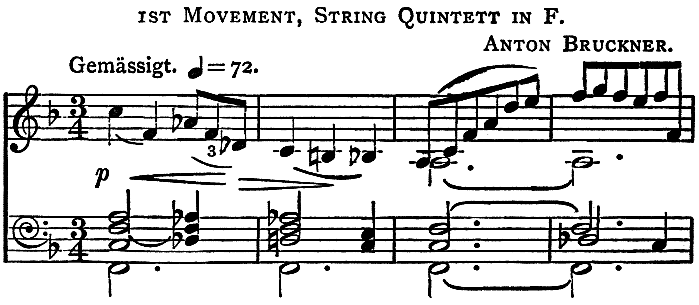
-185-
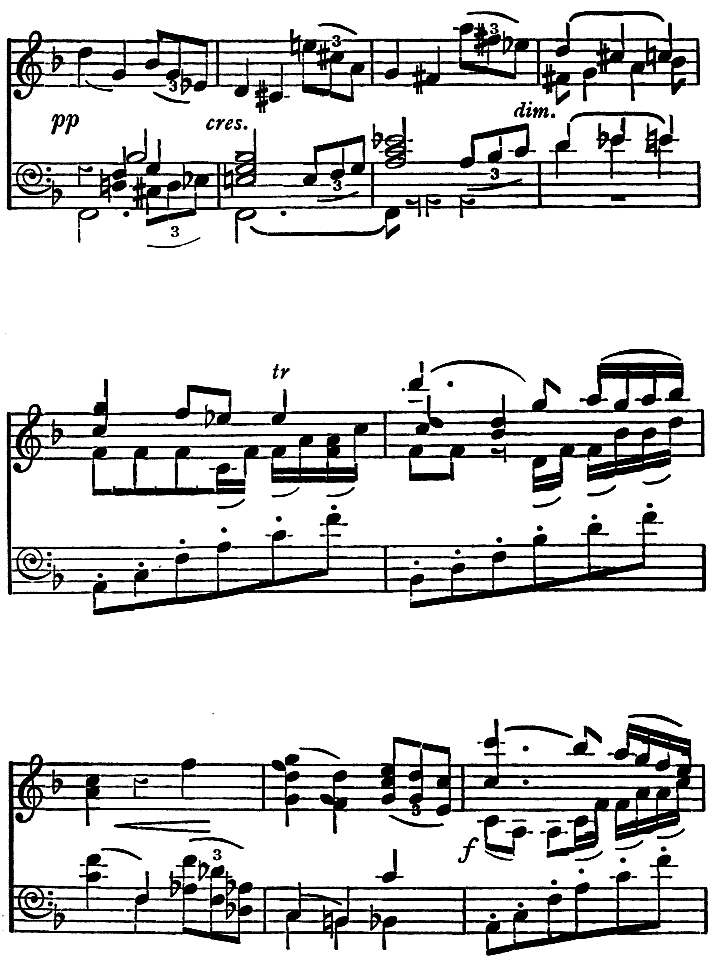
-186-
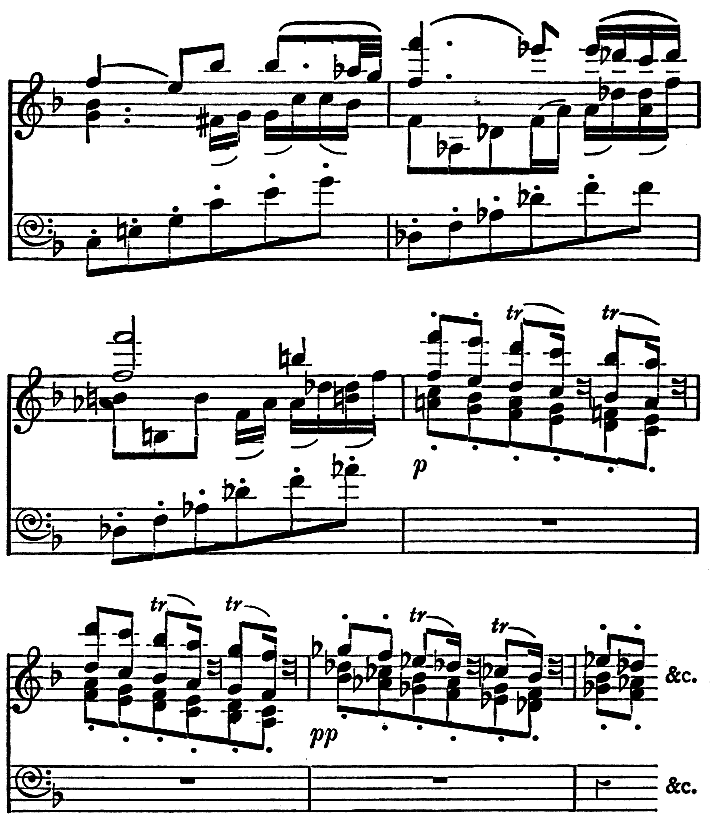
The adagio, on the other hand, reveals a feeling for emotional beauty of no ordinary kind, and doubtless it is writing of this character, which is found also in the slow-187- movements of the Orchestral Symphonies, that explains the effect which Bruckner’s works have created on the Continent.
3rd Movement, String Quintett in F.
Anton Bruckner.
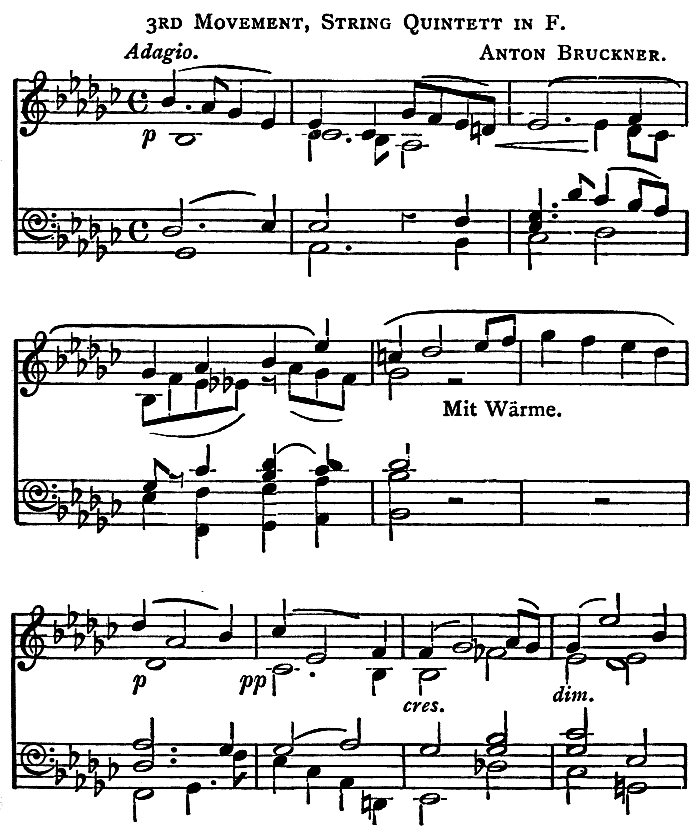
-188-

The scherzo of the Fourth (Romantic) Symphony may also be cited as a movement full of character, and while good, is pleasing even in the popular sense of that word. Music such as this, indeed, justifies the bringing forward of Bruckner’s name, and renders it difficult to acquiesce in some of the severe judgments which have been passed on his works. For example, when a new Symphony of Bruckner’s was performed by the Vienna Philharmonic Society some few years ago, Dr. Edward Hanslick, the well-known critic, said, in his notice printed in the Neue Freie Presse, that he had left the concert-room before the performance began, because he did not wish to witness the desecration of the hall! And in his notice of a New York concert, in which Mr. Theodore Thomas conducted Bruckner’s Seventh Symphony, Mr. H.E. Krehbiel, the musical critic of The Tribune, says:—“As an instance of what the intellect can do in music it is perhaps as startling-189- and interesting as anything that the century has produced. But as a musical composition it is nine-tenths cold intellectuality and one-tenth beauty. It is polyphony gone mad. If one wants originality, here it is in abundance. There is nothing under the heaven, or on the earth, or in the waters under the earth like unto this symphony. Those who think the thematic work in Tristan and The Ring complex and laboured, should hear this symphony, if for no other reason than to see how, in comparison with it, Wagner’s is a complete exemplification of good music as defined by Galuppi in a conversation with Dr. Burney one hundred and sixteen years ago: ‘Beauty, clearness, and good modulation.’ Every element of symphonic writing which Herr Bruckner uses he uses in a manner which stamps a unique character on the work. But it is only unique, not beautiful.”
And after discussing several technical points in the work, Mr. Krehbiel adds that, all the same, it is not wise or just to condemn an art-work like this in so superficial and flippant manner as nearly all the New York newspapers have done; “but bearing in mind a score of marvellous things in the symphony, notably several moments that approach grandeur in the slow movement, and remembering that that is not always the highest-190- type of beauty which is obvious at a glance, we are yet constrained to say that for the present the work is a failure. It may be beautiful in twenty-five years; it is not beautiful now.”
In the article by Herr Felix Weingartner, on the post-Beethoven symphonists, which was previously mentioned, we find the following opinion of Bruckner and his works:—“In these last ten years has been often mentioned a powerful rival of Brahms, born in that artist’s second fatherland, in that city of Vienna which seems to be the city of the symphony.[40] Though much older than Brahms, Anton Bruckner, recently deceased, only became universally known even later than him.... His was a musical talent veritably rich. For that reason one would be almost tempted to compare him to his great compatriot Schubert, if only he had created works perfect enough to be considered really masterly. But it was not so.... I was once asked my opinion of the rivalry of Bruckner and Brahms. I replied, ‘I should like nature to give us a musician uniting in himself the qualities of the two composers, the immense imagination of Bruckner with the knowledge of Brahms. From such a combination would arise an artistic figure of the highest possible value.’”
-191-
CHAMBER MUSIC OF RECENT TIMES.
Trio by E. Schütt — Trio by Kirchner — Raff’s C minor Trio — Balfe’s Trio in A major — Trio: C. Hubert Parry — Trio: Bargiel — Sterndale Bennett’s Trio, op. 26 — Trio, D minor: F.E. Bache — Trio, E flat: Nawratil — Trio: Goetz — Trio: Schmidt — Other Trios — String Trios — Quartett: Mackenzie — E flat Quartett: Rheinberger — Quartett: W. Rabl — Quartett: Prout — Quartett: Verdi — Quartett: Onslow — Quartett: W.H. Veit — Unusual combinations.
Here we must notice a few chamber compositions, chosen chiefly from the works of musicians of our own or of recent times. No special method of selection is followed, nor must the list be regarded as at all an exhaustive one. Only what is thought may prove acceptable and useful to earnest amateurs is mentioned.
A Trio, Walzer Märchen, op. 54, for piano, violin, and ’cello, by Edward Schütt, consists of three delightful musical stories, told in waltz rhythm, without a trace of monotony, which might easily arise under such conditions. Schütt, their composer, lives in Vienna, where he has conducted the Akademischer Wagnerverein. He has written a-192- number of works, and among them is a Piano Trio in C minor, which has met with much approval.
In the Novelletten Trios, op. 59, for piano, violin, and ’cello, by Theodor Kirchner, we have a set of refined and well-written pieces which display a considerable amount of character. Kirchner, who was an intimate friend of both Mendelssohn and Schumann, has written a large number of works, chiefly in the smaller forms, for the pianoforte. His model has evidently been Schumann, and he even gives to some of his works titles which were used by that master. For instance, his op. 17 he calls “Neue Davidsbündlertänze,” and op. 53 “Florestan and Eusebius.”
The composer, Joachim Raff (1822-82), of the Trio in C minor, op. 102, for piano, violin, and ’cello, was a distinguished example of what has been called “fatal facility.” His powers of musical invention seemed inexhaustible, and this, along with the demands of publishers, and probably, pecuniary needs, led him to overwrite himself, for of his two hundred and fifty and more works many are of but little value. With his larger works, generally speaking, it is different, and at any rate his symphonies and overtures entitle him to a leading place among contemporary composers.
-193-
This Trio also ranks as one of his best works. It is full of genuine melody and true poetic feeling, the andante (Mässig langsam) being especially charming. Those who are in sympathy with the advanced school of composition will find food for their fancy also in the String Quartett in D minor, op. 77, by this composer. It is well known that Raff was an ardent follower of the Liszt-Wagner school, and in this work he fully reveals this tendency. The third movement is an extremely fine example of the emotional style, full of rich and glowing passages which bring to mind the intensity and glamour of Tristan and The Ring. The Quartett, though difficult, is well worth knowing, if only for the sake of this movement. As has already been said, Raff no doubt wrote too much, and, in colloquial phrase, too often “gave himself away,” but for all that he had the root of the matter in him, and at his best he rises to great heights.
To those who only know Michael W. Balfe (1808-70) as the composer of The Bohemian Girl and other operas, his Trio in A major for piano, violin, and ’cello will come as somewhat of a surprise, for as a general rule we do not find in opera composers the power to bring to a successful issue works of this class. Here, however, may be found not only tunefulness, but such technical-194- skill and musicianship as this style of composition demands. Each movement possesses merit of no common order, and especially the scherzo may be mentioned as being distinguished by freshness and vigour, and also by certain humorous touches which serve to remind us that Balfe was musically, as well as nationally, an Irishman.
Chiefly because of its being ahead of its time, and partly because of its difficulty, Sir Hubert H. Parry’s Trio in E minor for piano, violin, and ’cello has not had the recognition which it deserves, for it is a noteworthy work by one of our distinguished English composers. It also probably represents its composer’s Sturm und Drang period. But it is the works of such periods which very often most fully reveal the aspirations and powers of an artist, even when also displaying the immaturities of inexperience.
The second movement, and especially the adagio which follows, contains some of Sir Hubert Parry’s best music. The allegro giocoso with which the trio ends will, like the whole work, repay study, although it doubtless makes large demands on both performers and listeners.
Waldemar Bargiel (1828-97) was one of the followers of Schumann, under whose influence, and-195- also that of Mendelssohn, he came at an early age. Later in life he worked with Dr. Joachim at the Royal Music School in Berlin. His works, without being absolutely great, are distinguished by sound musicianship and all those qualities which arise from true refinement and culture. The Trio in E flat, op. 20, for piano, violin, and ’cello is written in an elevated and interesting style. The andante especially is a nobly expressed and poetical movement.
Another Piano Trio by this composer is that in F major, op. 6. This work, which is dedicated to Schumann, commences with a theme whose first four notes are quoted from the scherzo of that master’s Piano Quintett in E♭. It does not, however, either as regards its themes or its poetic feeling, compare favourably with the op. 20.
The Chamber Trio, op. 26, for piano, violin, and ’cello, by Sir William Sterndale Bennett (1816-75), is the fairly-well-known work of a composer of whom it has been said that although “the number of his compositions is not large, for polish, refinement, and careful elaboration they vie with the best in musical art.” “He is in a special degree a musicians’ composer. His excellencies, in addition to the real and genuine feeling for beauty and-196- expression which pervades his music, belong to that interesting and delicate type of art which illustrates in a special degree the fitness of means to an end, the relation between the feeling expressed and the manner and medium of expressing it; a class of artistic production which always has a peculiar interest for artists, and for those who study critically the details of the art illustrated.”[41]
The Trio op. 26 consists of three movements—a charming andante tranquillo, followed by a serenata, and concluding with a vigorous allegro fermato. In the serenata the violin plays pizzicato throughout, while the cantabile melody is chiefly given to the piano, occasionally reinforced by the ’cello, which also joins the violin in the pizzicato effects.
We are not aware whether the Trio in D minor, op. 25, by Francis Edward Bache (1833-58), is generally known. If not, it certainly deserves to be. In style it is no doubt Mendelssohnian; indeed, in choice of keys and treatment it closely follows that master’s op. 49; but at the same time there is individuality in Bache’s work. Much modern chamber music, especially of continental origin, is burdened with elaborations and flights of fancy which, to say nothing harsher, render-197- it almost unintelligible unless performed by artists of the highest executive skill, whilst in the hands of the average amateur the result is usually chaotic. All this is avoided in this Trio. Without being in the least tame or insipid, it is never unreasonably difficult. The opening allegro is fresh and vigorous in style, and in the andante the treatment of the three instruments is more than usually interesting. A rondo (allegro molto ed appassionata), twice interrupted by a melodious episode (un poco più lento), brings the Trio to an end. The composer of this Trio was the brother of the well-known pianist, Walter Bache, who laboured so unselfishly in the cause of advanced music, and especially in introducing the works of Liszt to the British public. Francis Edward Bache showed great musical ability as a child. He studied the violin under Alfred Mellon, who was at that time conductor at the Birmingham Theatre, and in 1846, when Mendelssohn conducted his Elijah there, the boy, who was then thirteen years old, was allowed to play in the orchestra.
There can be no doubt, from the works he has left behind him and the high opinions held of him by Sterndale Bennett, Hauptmann, and Plaidy (Leipzig), under whom he studied, that had he lived he would have become a distinguished addition to the list of English composers.
-198-
Karl Nawratil (1836), the composer of the Trio in E♭, op. 9, for piano, violin, and ’cello, has for a long time enjoyed an excellent reputation as piano-teacher in Vienna. Among his pupils have been Madame Essipoff, Edward Schütt, and others who have distinguished themselves. He has written in various styles, and in chamber music form as well as this Trio, a String Quartett, two Piano Quartetts, and another Piano Trio.
The Trio in E♭ is an interesting composition, and quite grateful music to play. The last movement, with its fugal episode, may be specially mentioned. The work is dedicated to Brahms.
Hermann Goetz (1840-76) is known at any rate by two works which proclaim him to have been a highly gifted artist, and it is reasonable to think that but for his early death he would have come to occupy a very distinguished place among contemporary composers. The works referred to are an opera, The Taming of the Shrew, and the F major Orchestral Symphony. There is also a fine setting, for soprano solo, chorus, and orchestra, of the psalm “By the Waters of Babylon,” and another of Schiller’s Nänie. He was also engaged at the time of his death on a second opera, Francesca da Rimini, the-199- sketch for which was completed by his friend Frank, and performed at Mannheim in 1877.
The Trio in G minor, op. 1, for piano, violin, and ’cello, is a composition of dignified character, and full of true poetic feeling. This composer unquestionably had something to say, and he knew how to say it. His other chamber music works are a Piano Quintett in C minor, a Piano Quartett in E, and a Piano Sonata for four hands.
Oscar Schmidt, an unknown variant of the familiar name, has written a Trio in G minor, op. 24, for piano, violin, and ’cello, which may be recommended as a pleasant and sincere, although not great work. It is composed in classical form, with the usual four movements. The adagio opens with a charming and effective theme for the ’cello, and the whole trio is well laid out and playable for all the instruments.
Other piano, violin, and ’cello trios which may be mentioned are:—
Trio in F, op. 18, by Saint-Saëns (1835), which is a well-written work, showing its composer’s remarkable versatility.
Trio in E♭, op. 35, by Sir C. Villiers Stanford (1852), the second movement of which is a most dainty allegretto.
Trio in B♭, op. 27, by B. Molique (1802-69), an artist-200- who, both as composer and violinist, worthily upheld a high classical standard.
Novelletten, op. 29, and Trio in F, op. 42, both by Niels W. Gade (1817-90).
Trio in B♭, op. 52, by Anton Rubinstein (1830-94), with a very fine adagio movement.
Serenade Trio, op. 64, by Ferdinand Hiller (1811-85). The slow movement is called “a Ghazel.” This has been described as a short form of Persian poetry, in which the rhyme of the first two lines is repeated in every alternate line throughout the piece. Hiller’s musical equivalent for this is a simple phrase repeated by the strings, the piano filling up the intervals with other matter. Another of the movements is written chiefly in 5/4 time, but save for these peculiarities, the trio is not of any great value.
Two Trios, op. 21 and op. 32, by Emil Kreuz, for piano, violin, and viola, may also be mentioned.
As modern works for two violins and ’cello are not often to be met with, reference may be made to Two Trios, op. 135, for this combination, by Aloys Schmitt (1788-1866).
No. 1, in E♭, consists of one movement only; but No. 2, in D minor, has three, viz.:—Allegro moderato, minuet, and allegro. Both are well written, playable, and pleasant. The composer was born at-201- Erlenbach in Bavaria, and lived chiefly in Frankfort, where he was well known as a pianist and teacher of high aim.
Of Trios for violin, viola, and ’cello may be named op. 69 in G minor, by W. Berger (1861). This is the work of a living musician who resides in Berlin. Berger, who has published a considerable number of important works, writes in an earnest and musicianly manner, and although this trio may be somewhat lacking in melodic interest, it should at any rate prove useful to those who seek for music written for this combination of instruments, a form which is of course much rarer than the Quartett.
There are also three Trios, op. 85, for the same instruments, in D, C minor, and F, by Hermann Berens (1825-80), a Hamburg musician.
Prominent among modern quartetts stands that in E♭, for piano, violin, viola, and ’cello, by Sir A.C. Mackenzie (1847). This is an early work of this composer, and one which has hardly been accorded the recognition that it deserves. The third movement consists of a canzonetta with an interesting and fanciful set of variations. The quartett ends with a well-wrought and vigorous allegro. Sir Alexander Mackenzie has not published much chamber music, having, it would seem, preferred-202- to occupy himself with works of larger dimensions.
The Quartett in E♭, op. 38, for piano, violin, viola, and ’cello, by Joseph Rheinberger (1839-1901), has been a good deal played in England during recent years, and is an admirable example of this refined and musicianly composer.
Another of his chamber compositions, which is not perhaps so well known, is the String Quartett in C minor, op. 89. It is written in the usual form with four movements; the tunes are sincere, and the treatment is interesting, without anything which savours of pedantry. It is also a grateful work, from the performers’ point of view.
The Quartett in E♭, op. 1, for clarinet, violin, ’cello, and piano, by Walter Rabl, calls for mention. Rabl is a native of Prague, where he received his training, and his works have been brought to light chiefly through the instrumentality of the Friends of Music Society in Vienna, of whose committee Brahms was an active member. This quartett, which is dedicated to Brahms, is written in classical form and has many interesting features; it was played at the London Monday Popular Concerts in 1899, during a visit to England of Herr Mühlfeld, the celebrated German clarinettist. Rabl has also written a set of-203- Fantasiestücke, op. 2, for piano, violin, and ’cello, and a fine Sonata in D major, op. 6, for piano and violin.
Dr. Ebenezer Prout (1835), the eminent theorist and musical professor in the University of Dublin, has written, in addition to many works in various styles, and the Quartett, op. 18, in F, for piano, violin, viola, and ’cello, the following chamber music:—two String Quartetts, op. 1 and op. 15; a Piano Quintett, op. 3; a Piano Quartett, op. 2; a Romance for viola, with piano accompaniment, op. 32; a Sonata for piano and clarinet, op. 26; and a Duo Concertante for piano and harmonium, op. 6: all of which may be strongly recommended to amateurs who love a straightforward, intelligible style. The composer’s intimate acquaintance with the music of the great classic period, united to a sensitive and eclectic taste, has enabled him to give to the world in these works music which worthily upholds a true and pure standard. The String Quartett, op. 15, with its charming andante movement, as well as the op. 18, may be specially mentioned.
A String Quartett in E minor, by Verdi (1813-1901), is the only work which the great Italian opera composer wrote in the chamber music style. It was first privately performed in the drawing-room of the composer’s residence,-204- in 1873, and another performance took place at the London Monday Popular Concerts in 1878. Since that time it does not seem to have been often heard.
The work, which is by no means easy, contains some scholarly and remarkable writing, but for all that it can hardly be regarded as a satisfactory or successful composition. Especially does it lack that melodic interest which one expects from a composer usually so admirable in this respect as Verdi. Compared with his operas and other works, it lacks spontaneity and charm. At the same time it should be remembered that Verdi himself attached no importance to the quartett, and only very reluctantly allowed it to be performed out of his own house. He seems to have been as little successful with this work as probably Brahms would have been with an opera, had he ventured to write one.
G. Onslow (1784-1852), who wrote a large quantity of music, was a grandson of the first Lord Onslow. He was born in France, where, on his own estates, he chiefly resided. Chamber music was his passion, and of this he composed a great deal, and spent considerable time in its performance, the ’cello being his instrument. His String Quintetts are regarded as his best works, and they contain much charming music. “One of these, called@ “Le Quintette de la balle,” describes his emotions—the-205- pain, the irregular beating of his pulse, and his gratitude on his recovery—consequent on an accident that happened to him at a wolf hunt, where a spent ball hit him in the face, rendering him somewhat deaf in one ear for the rest of his life.“[42] Among his numerous String Quartetts is one in G minor, op. 9, which has an interesting set of four variations on our national anthem, ”God save the King.”@@@
A String Quartett in D minor by Hugo Wolf deserves attention. He has been described as “the intensified and intellectually developed Schubert”! The Quartett referred to is in form and melodic material interesting, especially as an example of the unfettered tendencies in modern music.
A recently-published composition by John B. McEwen must not go unmentioned. This String Quartett in A minor has been performed in London and was approved. Like Dvořák, with whom indeed he has something in common, Mr. McEwen’s music reveals his nationality. The Andante, with a prominent viola part, distinctly appeals to those from “beyond the border.”
Finally there is the String Quartett No. 1 in D minor by W.H. Veit (1806-64). Although of no great interest otherwise, this quartett contains a musicianly set of variations on the Russian national anthem. Wenzel-206- Heinrich Veit was the district president of the law courts at Leitmeritz in Bohemia, where he lived all his life. Chiefly self-taught, he was an excellent musician, and has left behind him some well-written works.
In the vast répertoire of chamber music the following works for unusual combinations of instruments may be mentioned, although some of them are obviously more musical curiosities than works of art:—
Octett, op. 32, by Liadoff (1855), a Russian composer, for piccolo, two flutes, three clarinets, harp, and campanelli (bells).
Septett, op. 24, in D, by Vincent d’Indy (1851), a somewhat distinguished French musician, for trumpet, two flutes, and string quartett.
Septett, op. 67, by Saint-Saëns, for trumpet, strings, and piano.
Trio (humorous) by Latann, for piccolo, guitar, and trombone.
Theme and Variations by Kroepsch, for tin whistle and piano.
Mozart, Haydn, Hummel, Reicha, Quantz, and others have written for unusual combinations of instruments, as the list of their works will show, but only a few of these have much artistic value.
-207-

A. Chronological and Biographical.
-209-
1510. Caspar Duiffoprugcar (Bologna); about 1510. The reputed inventor of the violin, although there can be no doubt that this instrument was a slow growth from earlier forms.
1533. V. Galilei (Florence), 1533-1600. Violin and lute player. Member of the celebrated circle of artists who met at the residence of Count Bardi in Florence.
1535. Andreas Amati (Cremona), 1535-1611. Head of the family of celebrated violin makers.
1543. Ganassi, a Venetian writer, mentions three varieties of violins as Viola di Soprano, di Tenore, e di Basso; and Castiglione alludes to a composition for “Quattro Viole da Arco,” which may of course be taken for the String Quartett.
1557. Thomas Morley (London), 1557-1604. Famous English composer, who wrote certain instrumental pieces, after the manner of chamber music, for lute, citterne, flute, treble and bass viol. He also wrote some excellent vocal music.
1567. Claudio Monteverdi (Cremona), 1567-1643. A composer of decided originality, who introduced a number of new-210- effects. The tremolo for strings is first met with in his works. He was, however, chiefly a composer of the earliest form of opera.
1586. J. Hermann Schein (Grünhain), 1586-1630. One of the predecessors of J.S. Bach as cantor of the St. Thomas School at Leipzig. His compositions include a number of works for strings, notably twenty Partitas with five movements each. An edition of his works is now being issued by Breitkopf & Härtel.
1592. John Jenkins (Maidstone), 1592-1678. Chamber musician to King Charles I. and King Charles II. Composer of chamber music, among which is twelve sonatas for two violins and bass.
1598. Salomon Rossi (Mantua), 1598-1623. Italian musician who published various early forms of chamber music for strings.
1600. G. Bassani (Venice), about 1600. Violinist and teacher of Corelli. He composed chamber music suites which were highly esteemed.
1621. Biagio and Carlo Marini (Brescia), about 1621. Two chamber music composers, well known in their time.
1625. G. Legrenzi (Venice), 1625-90. Eminent composer, who wrote various chamber music works for strings. Lotti was his pupil.
1625. Carlo Farino (Mantua), about 1625. Composer of chamber music, and one who considerably developed the form. (See Wasielewski’s The Violin and its Masters.)
1628. Tarquinio Merula (Cremona), about 1628. One of the early composers of sonatas for the violin, and of other forms of chamber music.
-211-
1636. John Banister (London), 1630-79. Violinist and director of chamber music concerts.
1630. G.B. Fontana (Brescia), —— d. 1630. Composer who did much for the development of the chamber music of his time.
1632. Matthew Locke (Exeter), 1632-77. Celebrated English musician; chiefly remembered by his “Macbeth” music, but he also wrote chamber music for viols and violins.
1641. Johann Vierdank (Stralsund), about 1641. Organist at Stralsund. He wrote a number of works for two violins and bass.
1644. G.B. Vitali (Cremona), about 1644. Important violist, and composer of chamber music during the period leading up to the time of Corelli.
1644. Antonio Stradivari (Cremona), 1644-1737. The great Cremona violin maker.
1649. Johann P. Krieger (Nuremberg), 1649-1725. German chamber music composer. Twenty-four of his sonatas for two violins and bass have survived.
1650. Guarneri (Cremona), 1650-1745. Name of the famous family of violin makers.
1650. N. Hasse (Rostock), about 1650. He wrote dances (courantes, etc.) for strings and theorbo, a bass instrument of the lute order.
1650. Nicolaus Kempis (Florence), about 1650. He resided in Brussels in the middle of the seventeenth century. His chamber music was regarded as among the best written during his time.
1653. Corelli (Fusignano), 1653-1713. Eminent violinist and composer of important chamber music.
-212-
1655. J.H. Schmelzer (Vienna), about 1655. Chamber musician at the court of Vienna, who published various sonatas for strings and wind.
1655. Steffani (Castelfranco), 1655-1730. Venetian composer of high rank, who lived chiefly in Germany. His vocal chamber duets are his more important works, but he also wrote chamber music for strings.
1655. J. Christoph Denner (Nuremberg), 1655-1707. A musical instrument maker, to whom is attributed (about the year 1700) the invention of the clarinet.
1658. Henry Purcell (London), 1658-95. A composer of great and original genius, among whose works, in many styles, are various interesting chamber music compositions.
1659. Alessandro Scarlatti (Trapani), 1659-1725. Although not pre-eminently distinguished as an instrumental composer, it is claimed for him that he was the first to publish a genuine string quartett for two violins, viola, and ’cello. Copies of such compositions by him are, it is stated by Mr. E.J. Dent, to be found in the Santini Library at Münster in Westphalia.
1660. Ariosti (Bologna), 1660-1740 (about). Italian composer, who for a short time taught Handel. He, Buononcini, and Handel wrote an opera, each taking an act. Ariosti left some chamber music for the viola d’amore, on which he himself was a performer.
1662. E.F. del Abaco (Verona), 1662-1726. Italian composer, who wrote some noteworthy sonatas for two violins and continuo (figured bass).
1662. Henri Desmarets (Paris), 1662-1741. Chamber musician to Louis XIV.
-213-
1668. François Couperin, 1668-1733. French organist and composer of works for the clavecin which are of historic importance. He also wrote some trios for two violins and bass.
1669. Johann Pezel (Leipzig), 1669-86. A German composer who published various works for strings in chamber music style.
1674. C.H. Abel (Hanover), about 1674. Composer of various instrumental pieces for strings; other members of the Abel family were composers of chamber music.
1674. T. Albinoni (Venice), 1674-1745. Composer of chamber music. J.S. Bach esteemed his music, and wrote two fugues on themes by him.
1675. Antonio Vivaldi (Venice), 1675-1743. Italian violinist and composer of great distinction who wrote important chamber music.
1680. F. Geminiani (Lucca), 1680-1762. Violinist and composer. His sonatas, trios, etc., are of importance for their time.
1685. Gottfried Finger (Olmütz), about 1685. He came to England in 1685, and was appointed chapel-master to King James II. In conjunction with John Banister he published chamber music for various instruments.
1685. F.M. Veracini (Florence), 1685-1750. Celebrated violinist composer and chamber-music virtuoso.
1685. John Sebastian Bach (Eisenach), 1685-1750.
1685. G.F. Handel (Hallé), 1685-1759.
1685. Domenico Scarlatti (Naples), 1685-1757. Composer and performer of clavier music of great distinction. He leads us up to P.E. Bach, Haydn, and others of that period.
-214-
1685. Johann Schenck (Wiener-Neustadt), about 1685. He published during 1685-95 sonatas for two violins, gamba (a kind of ’cello), and continuo (figured bass), and many other works in chamber music form. One set of these he called (anticipating the Beethoven Scherzo) Scherzi musicali.
1685. Torelli (Verona),—about 1685. Famous violinist, who wrote some important chamber music for strings.
1686. N.A. Porpora (Naples), 1686-1766. Opera composer of great fame. He also wrote a number of chamber music works, including six so-called chamber symphonies for two violins, ’cello, and continuo.
1687. J.M. Leclair (Paris), 1687-1764. Eminent violinist and composer of chamber music. Two of his sonatas are included in Ferdinand David’s High School of Violin Playing.
1689. P. Castrucci (Rome), 1689-1769. Composer of violin and other sonatas, and inventor of a stringed instrument called the Violetta Marina, which Handel used in his operas Orlando and Sosarme.
1690. Testore (Milan), 1690-1745. The name of a renowned Italian family of violin makers.
1690. C. Tessarini (Urbino),—born 1690. Celebrated violinist, and composer of trios for two violins and bass, and other chamber music. Pupil of Corelli.
1692. Antonio Veracini (Florence), about 1692. Distinguished composer of chamber music. His brother, F.M.V., was also a violinist and composer of distinction.
1692. G. Tartini (Padua), 1692-1770. Violinist, composer, and theorist. He wrote much chamber music, and developed-215- a high school of violin playing. Amongst his pupils were Nardini and Pasqualino. To him is ascribed the discovery of combination, or resultant, tones, although this is also claimed for his contemporary, G.A. Sorge.
1693. Pietro Locatelli (Bergamo), 1693-1764. A distinguished violinist; pupil of Corelli. One of the first to use double stopping, and different modes of tuning the violin. He published chamber music for strings.
1696. Robert King (London), about 1696. Chamber musician and composer to King William III. of England.
1696. G.M. Ruggieri (Venice), 1696-1732. Venetian opera composer, who wrote some chamber music sonatas, etc., for strings.
1697. J.J. Quantz (Oberscheden), 1697-1773. Chamber musician to Frederick the Great of Prussia. Famous flute player. He wrote many chamber duets, trios, quartetts, etc., for that instrument.
1698. Johann G. Graun (Wahrenbrück), 1698-1771. Brother of the more celebrated Karl H. Graun. He wrote many string quartetts, trios, etc.
1703. G.A. Sorge (Mellenbach), 1703-78. German organist and theorist. It is claimed that he discovered “combination tones” before Tartini, to whom their discovery is usually attributed.
1707. Gottfried Keller (German), about 1707. Composer and teacher, who lived chiefly in London, where he published six sonatas for two flutes and bass, and six for two violins, trumpet, viola, and bass.
1709. William Flackton (London), 1709-98. The English publisher Walsh issued six trios for strings by this composer in 1758.
-216-
1710. Charles Avison (Newcastle-on-Tyne), 1710-70. Organist and chamber music composer. Browning refers to him in his “Parleyings.”
1710. G.B. Pergolesi (Naples), 1710-36. A composer of great distinction, who wrote many operas, a well-known “Stabat-mater,” and chamber music, including thirty trios for two violins and bass.
1711. Ignaz Holzbauer (Vienna), 1711-83. He wrote many string quartetts and other chamber music. Mozart is said to have esteemed his compositions.
1712. Frederick the Great, King of Prussia, 1712-86. Amateur composer and flautist of distinction.
1714. Philipp Emanuel Bach (Weimar), 1714-88.
1714. Gluck (Wiedenwang), 1714-87. Opera composer. He wrote no chamber music.
1715. G.C. Wagenseil (Vienna), 1715-77. Composer and chamber musician to the court. His works, which include much chamber music, were held in high favour during his life-time.
1716. F. de Giardini (Turin), 1716-96. Violinist (who resided for some time in London), and composer of chamber music.
1717. J.K. Stamitz (Deutsch-Brod), 1717-61. Violinist and composer, who wrote a number of trios, etc., for strings. His sons, Karl and Anton, were also distinguished violinists and composers.
1722. P. Nardini (Florence), 1722-93. Pupil of Tartini. Composer of string quartetts, sonatas, and other chamber music.
-217-
1724. C.G. Töschi (Munich), 1724-88. Violinist and composer of chamber music, including twenty-four quartetts for strings and flute, and three sextetts for flute, oboe, bassoon, and string trio.
1724. Pierre van Malder (Brussels), 1724-68. Violinist, composer, and chamber musician to Prince Charles of Lorraine.
1730. G.B. Sammartini (Milan), 1730-70. Composer of distinction, who worked, prior to Haydn, at chamber music and orchestral composition. He wrote a great deal, including string quartetts, trios, etc. Gluck was his pupil.
1730. J.T. Goldberg (Königsberg), about 1730. J.S. Bach wrote for him the celebrated “Goldberg” variations for clavier. He himself composed chamber music.
1731. G. Pugnani (Turin), 1731-98. Renowned violinist, who composed a number of chamber works for strings. He resided for some time in London. Viotti was one of his pupils.
1732. Joseph Haydn (Rohrau), 1732-1809.
1732. J.C. Friedrich Bach (Leipzic), 1732-95. The third of J.S. Bach’s sons. He composed, among other works, some chamber music, but it is not so important as that of his brother, P. Emanuel.
1734. F.J. Gossec (Paris), 1734-1829. Prolific composer in all styles. His chamber music, and especially his quartetts, were held in high esteem.
1734. Antonio Sacchini (Pozzuoli), 1734-86. Italian opera composer, who also wrote some excellent chamber music.
-218-
1736. J.L. Dussek (Bohemian), 1736-99. A distinguished pianist, who, as well as excellent piano sonatas, composed some chamber music.
1736. Albrechtsberger (Vienna), 1736-1809. Celebrated theorist who composed many chamber music works. Beethoven was a pupil of his.
1737. J. Michael Haydn (Rohrau), 1737-1806. Brother of Joseph Haydn. His compositions in various styles are numerous, and by no means unimportant. They include string quintetts and quartetts. One of the latter was recently played by the Rosé Vienna Quartett.
1739. Carl von Dittersdorf (Vienna), 1739-99. A distinguished chamber music composer. He was during his life-time popularly regarded as a rival of Haydn.
1739. William Forster (Brampton, Cumberland), 1739-1808. An English violin maker of repute. He also published Haydn’s string quartetts.
1739. F.W. Rust (Wörlitz), 1739-96. A violinist whose compositions, and especially his violin and piano sonatas, are of much importance.
1739. J.B. Wanhal (Neu-Nechanitz), 1739-1813. Bohemian composer, who wrote a great deal of chamber music, which was popular in his life-time.
1741. Grétry (Liège), 1741-1813. Celebrated French opera composer. He also wrote a number of string quartetts and piano sonatas.
1741. G. Paesiello (Taranto), 1741-1816. Italian opera composer of note, who also published some chamber music.
1741. W. Pichel (Vienna), 1741-1805. Chamber musician to Duke Ferdinand. A very prolific composer of chamber music. He has left several hundreds of such works.
-219-
1741. L. Tomasini (Pesaro), 1741-1808. Violinist and composer. He acted as leader and chamber musician to Prince Esterhazy, under Haydn, who was his friend. He published various string quartetts, etc.
1743. Boccherini (Lucca), 1743-1805. Esteemed Italian composer, who wrote a great deal of chamber music, including ninety-one string quartetts.
1744. Giuseppe Giordani (Naples), 1744-98. A composer of merit, who wrote much chamber music.
1744. M.A. Guénin (Mauberge), 1744-1814. His chamber works, which were very numerous, were at the time popularly regarded as equal to Haydn’s, a view, it is hardly necessary to add, which time has not confirmed.
1745. J.P. Salomon (Bonn), 1745-1815. Violinist and director of concerts in London, at which Haydn’s symphonies were produced. Salomon was an excellent chamber music leader. Haydn’s last quartetts were written for him.
1746. G. Cambini (Leghorn), 1746-1825. Among the chamber music of this now unknown composer are found no less than one hundred and forty-four string quartetts.
1747. J.W. Hässler (Erfurt), 1747-1822. A German composer, chiefly for the piano, of the period between Bach and Beethoven. His works certainly have a historic interest.
1747. F. Tourte (Paris), 1747-1835. The famous violin-bow maker.
1748. J.W. Stich (Prague), 1748-1803. A celebrated horn player, who also wrote many chamber music compositions, in which that instrument took part. Beethoven thought highly of him, and wrote for and played with him the sonata op. 17, for pianoforte and horn.
-220-
1749. The Abbé Vögler (Würzburg), 1749-1814. A distinguished organist and composer, the list of whose works include a piano quartett called “The Matrimonial Quarrel,” and other chamber music.
1751. B. Campagnoli (Bologna), 1751-1827. Violinist and chamber music composer.
1752. Muzio Clementi (Rome), 1752-1832. Pianist and composer.
1752. Leopold Kotzeluch (Bohemian), 1752-1818. A prolific if not profound composer, of fame during his life-time. Amongst other of his chamber music works are fifty-seven piano trios.
1753. F. Fiorillo (Naples), about 1753. Violinist and composer. Some of his works were edited by Spohr.
1753. G.B. Viotti (Fontanetto), 1753-1824. Italian composer and violinist, who has been called the father of modern violin playing. He wrote many important chamber music works.
1754. Peter von Winter (Mannheim), 1754-1825. Famous opera composer, who also wrote some interesting chamber music.
1754. William Shield (Swalwell, Durham), 1754-1829. English opera and chamber music composer. He was also of repute as a musical theorist.
1756. Paul Wranitzky (Vienna), 1756-1808. A composer of a large quantity of chamber music. He was violinist in Haydn’s Esterhazy Band. His brother Anton was also a distinguished violinist and composer.
1756. Mozart (Salzburg), 1756-91.
-221-
1757. Ignaz J. Pleyel (Rupertsthal), 1757-1831. Pupil of Haydn. He wrote a great quantity of chamber music (forty-five string quartetts, and other works), which is, however, hardly now remembered.
1760. Franz Krommer (Vienna), 1760-1831. Among other chamber music he wrote sixty-nine string quartetts, but these were overshadowed by the works of his contemporaries, Haydn, Mozart, and Beethoven.
1760. Cherubini (Florence), 1760-1842. Eminent composer in various styles. His string quartetts are noteworthy.
1763. A. Gyrowetz (Vienna), 1763-1850. A distinguished personality, and prolific composer of chamber music (sixty string quartetts, etc.), which was not, however, of an enduring character.
1764. Regina Strinasacchi (Ostiglia), 1764-1839. Noted lady violinist, for whom Mozart wrote the well-known violin and clavier sonata in B♭ (No. 454, Köchel). When first performed by her and the composer (in public), no clavier part had as yet been written, Mozart playing it from memory.
1765. D. Steibelt (Berlin), 1765-1823. Solo pianist, and composer of a great deal of chamber music which is now almost forgotten. As a performer he is said to have competed in public with Beethoven, and was popularly considered not inferior to that master.
1766. Anton Eberl (Vienna), 1766-1807. Pianist, composer of chamber music, and the friend of Mozart and Gluck.
1766. Rudolph Kreutzer (Versailles), 1766-1831. Beethoven dedicated to him the piano and violin Sonata op. 47. He was chamber musician to Napoleon and to Louis XVIII. The large quantity of chamber music which he wrote is-222- now practically forgotten, but his forty violin studies are still highly esteemed.
1767. Andreas Romberg (Vechta), 1767-1821. Composer of distinction, if not of genius. He wrote many chamber music works. His son Bernard (’cellist) was also somewhat distinguished as a performer and composer.
1769. J.F. Rochlitz (Leipzig), 1769-1842. Literary musician, who edited the Allgemeine Musikalische Zeitung during the period when Beethoven’s works began to appear. His discriminating and sympathetic notices were among the first to call world-wide attention to these works, and are indeed of much historic importance.
1769. Martin Marin (Bayonne), born 1769. Celebrated harpist, for which instrument he composed (and such works are rare) quintetts with strings and other chamber music, which M. Fétis says are “truly classical.”
1770. Anton Reicha (Prague), 1770-1836. Theorist and composer. Friend and associate of Albrechtsberger, Haydn, and Beethoven. He wrote many chamber music works.
1770. Beethoven (Bonn), 1770-1827.
1771. P.M. Baillot (Paris), 1771-1842. Celebrated violinist and teacher, who also wrote some chamber music.
1771. J.B. Cramer (Mannheim), 1771-1858. Pianist, composer, and teacher.
1772. Joseph Wolff (Salzburg), 1772-1812. Pianist and composer, who studied under Michael Haydn. In extemporisation on the piano he was popularly considered superior to Beethoven. He published many chamber music works, but his career was not successful. He died in London forgotten, and, it is said, almost destitute.
-223-
1772. Prince Louis Ferdinand of Prussia (Friedrichsfelde), 1772-1806. Distinguished amateur musician and composer of interesting chamber music.
1776. Ignaz Schuppanzigh (Vienna), 1776-1830. He, as leader, with Mayseder, Weiss, and Lincke, constituted the celebrated string quartett which first performed Beethoven’s works, under the composer’s own direction.
1778. J.N. Hummel (Pressburg), 1778-1837. Distinguished musician. Pupil of Mozart. Composer of chamber music, of which it may be said that while good, it was but superficial in feeling.
1780. Luigi Borghi, violinist and composer, who resided in London about 1780. He wrote some excellent sonatas for violin, and for viola d’amore and double bass.
1781. Antonio Diabelli (Mattsee), 1781-1858. A prolific but by no means great composer. He was a pupil of Michael Haydn, but afterwards became a music publisher in Vienna. He published Schubert’s works, and, it is said, did not pay that master well.
1782. J.F. Mazas (Béziers), 1782-1849. Violinist and composer of chamber music.
1782. John Field (Dublin), 1782-1837. Chiefly known as a pianist, and for his nocturnes for piano. He also wrote some chamber music.
1782. N. Paganini (Genoa), 1782-1840. Probably the greatest of violin virtuosi. As a player in classical quartetts he was said to have been a failure. He did not subordinate himself sufficiently to the general meaning and effect of the music.
-224-
1783. Joseph Lincke (Vienna), 1783-1837. Violoncellist in the Rasumowsky and Schuppanzigh Quartetts, with whom Beethoven’s name was so much associated.
1783. Graf von Gallenberg (Vienna), 1783-1839. Beethoven is said to have been in love with the Countess Guicciardi (who eventually became the Countess Gallenberg), and he dedicated his so-called moonlight sonata to her. Beethoven wrote a set of variations on a theme of Gallenberg’s.
1784. Ferdinand Ries (Bonn), 1784-1838. Pianist, composer, and teacher. Was an intimate friend of Beethoven, and wrote a biography of that master.
1784. François J. Fétis (Mons, Belgium), 1784-1871. Distinguished literary musician, who wrote also some chamber music of interest, if not of genius.
1784. George Onslow (Clermont-Ferrand), 1784-1852. The grandson of Lord Onslow. Voluminous writer of chamber music, to which he almost devoted his life. He played ’cello in the soirées which were constantly held at his French residence, Clermont-Ferrand (Puy de Dôme). His chamber music has considerable artistic value.
1784. Ludwig Spohr (Brunswick), 1784-1859. Distinguished violinist and composer. His chamber music, as well as many works in all styles, are of great importance.
1786. F. Kuhlau (Hanover), 1786-1832. He is chiefly known by his chamber music quartetts, trios, and duets for flutes.
1786. Weber (Eutin), 1786-1826. The famous German opera-composer (Der Freischutz, etc.). He also wrote some important chamber music. His piano sonatas especially are noteworthy.
-225-
1787. Antonio Leite (Oporto), 1787-1826. Portuguese composer, whose works include sonatas for the curious combination—guitar, violin, and two trumpets.
1788. Aloys Schmitt (Erlenbach), 1788-1866. Pianist and teacher. His trios and quartetts for strings are interesting.
1789. Joseph Mayseder (Vienna), 1789-1863. Violinist of importance and composer of chamber music. He was a member of the Schuppanzigh Quartett. It is said that Paganini thought highly of him.
1790. C. Urhan (Paris), 1790-1845. Violinist and composer of chamber music, and belonged to Baillot’s Quartett. He, like his contemporary Michael Woldemar (1750-1816), who wrote a concerto for the instrument, constructed a larger violin with a fifth string (low C), and called it the violin alto.
1791. Karl Czerny (Vienna), 1791-1857. Eminent pianist and teacher. He was for a while a pupil of Beethoven.
1792. Anton B. Fürstenau (Münster), 1792-1852. Flautist of distinction, who was much connected with chamber music performances. His works in this form for flute and strings, etc., are important.
1794. L. Jansa (Vienna), 1794-1875. Celebrated as a quartett leader, especially of the works of Haydn and of Beethoven, whose Kreutzer Sonata he played first to Beethoven, with Czerny at the piano.
1794. Ignace Moscheles (Leipzig), 1794-1870. A pupil of Albrechtsberger, and associated with Beethoven, Mendelssohn, and other great artists. He wrote chamber music, which is now, however, practically forgotten. Some of his piano works are of value.
-226-
1795. Kaspar Kummer (Erlau), 1795-1870. Eminent flautist, who wrote chamber music for that instrument, with strings.
1795. H.A. Marschner (Zittau), 1795-1861. Opera composer of distinction, whose works may be regarded as the link between Weber and Wagner. He also wrote some chamber music which had little vitality, and is now forgotten.
1796. Anton Schindler (Medl.), 1796-1864. May be called Beethoven’s “Boswell.” He lived on intimate terms, under the same roof, with the great master, helped him during his life-time, and afterwards faithfully chronicled his doings. Schindler was an educated musician, played the violin, and was for some time Cathedral Capellmeister at Münster.
1797. Schubert (Lichtenthal), 1797-1828.
1798. J.B. Villaume (Mirecourt), 1798-1875. Celebrated French violin maker. He also invented a large kind of viola which was called “contralto,” and a monster double bass called “octo-bass.”
1798. Karl G. Reissiger (Belzig), 1798-1859. German composer of operas, etc. He also wrote a considerable amount of chamber music, which had its vogue. But although facile in expression, his music is lacking in character and depth. Such music is useful as showing us what not to do.
1800. Edward A. Grell (Berlin), 1800-86. A somewhat distinguished musician, who held the view that vocal music was the only real music. Instrumental was decadent!
1802. W. Bernhard Molique (Nuremberg), 1802-69. Esteemed composer, solo violinist, and quartett leader. His chamber music is of high merit.
-227-
1802. John Ella (Thirsk, Yorkshire), 1802-88. Violinist and promoter of high-class chamber concerts in London. His audiences were supplied with analytical programmes, a custom, however, which had already been in use at like concerts given in Edinburgh.
1803. Glinka (Nowospask), 1803-57. Distinguished Russian composer, who also wrote some chamber music.
1803. Franz Lachner (Munich), 1803-90. A somewhat important German composer. Intimate friend of Schubert. His chamber music includes string and piano quartetts and larger works.
1803. Karl F.E. Schafhautl (Ingolstadt), 1803-90. Acoustical musician, who assisted Boehm in his improvements of the flute and other instruments. His investigations into the causes of the various tone-tints of musical instruments is said to have shaken the Helmholz theory.
1805. The Brothers Sebastian and Louis Lee (Hamburg), 1805 and 1819. Both ’cellists of repute. Louis, along with Hafner, established in Hamburg chamber music concerts. He also composed some chamber music.
1806. H.W. Veit (Repnic), 1806-64. Bohemian composer of repute, who wrote some interesting chamber music.
1807. H.N. Reber (Paris), 1807-80. French composer of distinction. His chamber music is worthy of attention.
1807. J.L. Ellerton (London), 1807-73. An amateur who wrote a large quantity of chamber music, including forty-four string quartetts.
1808. M.W. Balfe (Dublin), 1808-70. The well-known opera composer (Bohemian Girl, etc.). His piano trio in-228- A major is an exceptional but quite interesting work. It was played at the Monday Popular Concerts, with Joachim as leader.
1808. Prince Rasumowsky (Russian), about 1808. [Transcriber’s Note: Rasumowsky was born in 1752, per Wikipedia.] He carried on from 1808 to 1816 the string quartett known by his name, and in which he played second violin. Afterwards it was called, after its leader, the Schuppanzigh Quartett. Beethoven dedicated his quartett op. 59 to Rasumowsky.
1809. E. Sauzay (Paris), born 1809. Violinist and pupil of Baillot, in whose quartett he played second violin, and afterwards viola. He took an active part in matters connected with chamber music.
1809. Felix Mendelssohn (Hamburg), 1809-47.
1810. Chopin (Zelazowa-Wola), 1810-49. Celebrated Polish pianist and composer. He wrote some chamber music, but is best known by his works for piano solo.
1810. Ferdinand David (Hamburg), 1810-73. Violinist of fame as performer and teacher. Joachim and Wilhelmj were among his pupils. He was much associated with the best chamber music doings of his time. During its composition Mendelssohn conferred with him as to his (Mendelssohn’s) Violin Concerto.
1810. Felicien David (Cadenet), 1810-76. French composer, known now chiefly by his ode “The Desert.” His string quartetts were also held in high esteem during his life-time.
1810. Schumann (Zwickau), 1810-56.
1811. Ferdinand Hiller (Frankfurt-a-M.), 1811-85. German composer of repute. His chamber music possesses a certain degree of interest.
-229-
1811. Henry G. Blagrove (Nottingham), 1811-72. Eminent English violinist. Pupil of Spohr.
1811. Franz Liszt (Raiding), 1811-86. One of the world’s great pianists, but more devoted to solo than to ensemble playing. Wagner (whose devoted friend Liszt was) has left it on record that he never knew the full power and majesty of Beethoven’s piano sonatas, especially the later ones, until he heard them played by Liszt, in private, at Wahnfried, Wagner’s residence in Bayreuth.
1811. C.L. Ambroise Thomas (Metz), 1811-96. Distinguished French opera composer, who also wrote a string quartett, a quintett, a piano trio, and other chamber music.
1812. Karl Grädener (Rostock), 1812-83. Chamber music composer of some distinction, ’cellist, and quartett player.
1812. Flotow (Mecklenburg), 1812-83. Opera composer, who is best known by his work Marta. He also wrote some chamber music, not, however, of distinction.
1813. Sir G.A. Macfarren (London), 1813-87. Composer, and Principal of the R.A. Music, London. He published a number of works in chamber music form, also on musical theory.
1813. G. Verdi (Roncole), 1813-1901. The well-known Italian opera composer, who in 1873 published a quartett for strings, his only instrumental chamber music work.
1815. Stephen Heller (Paris), 1815-88. A composer (chiefly for the piano) whose works, although written in the smaller forms, rise above most of his contemporaries in character, and especially in poetic expression. He, with the violinist Ernst, published some interesting piano and violin pieces.
-230-
1815. F. Robert Volkmann (Lommatzsch), 1815-83. Eminent modern composer, who wrote many chamber music works of interest.
1815. E.C. Sivori (Genoa),—1815-94. Famous violinist and quartett leader.
1816. Sir W. Sterndale Bennett (Sheffield), 1816-75. Distinguished English composer, especially for piano. His trio op. 26 is a charming chamber music work.
1817. Niels W. Gade (Copenhagen), 1817-90. Danish composer. Amongst his chamber music, a piano trio in F and the violin and piano sonatas are noteworthy.
1817. M. Gustav Nottebohm (Lüdenschied), 1817-82. A well-known German writer on music, especially on Beethoven, whose interesting sketch books he published.
1817. Alex. W. Thayer (South Natick, U.S.A.), 1817-97. An American writer who devoted much of his life to a biography of Beethoven, which has, however, only as yet in part been issued in German.
1818. Antonio Bazzini (Brescia), 1818-97. Italian violinist and composer of chamber music. His string quartetts and a quintett are much esteemed.
1819. W. Sharfenberg (Kassel), 1819-95. German violinist and pianist, who resided chiefly in New York, U.S.A. He at one time played second violin in Spohr’s string quartett.
1819. Sir Charles Hallé (Hagen), 1819-95. Distinguished pianist and conductor, who resided chiefly in Manchester, and did much for chamber music in the country of his adoption.
-231-
1820. C. Gurlitt (Altona), 1820-1901. A composer of sincere and pleasing, if not profound, chamber music. He also wrote much piano music for young people and children.
1820. Jules Armingaud (Paris), born 1820. Leader of a famous string quartett. He is said to have introduced Beethoven’s quartetts to Paris.
1821. Friedrich Kiel (Berlin), 1821-85. Important modern composer, who wrote a considerable amount of chamber music.
1822. Alfred Piatti (Bergamo), 1822-1901. Celebrated violoncellist, which instrument he played for many years at the leading chamber music concerts in London, where he resided.
1822. J. Joachim Raff (Lachen), 1822-82. A versatile and highly-gifted composer, many of whose chamber music works are of great interest. A Piano Trio in C minor, op. 102, may be specially mentioned.
1822. L.T. Gouvy (Gaffontaine), 1822-98. A composer who wrote a large quantity of chamber music in style somewhat Mendelssohnian. He resided chiefly in Paris.
1822. César August Franck (Liège), 1822-90. A composer whose works, and more especially some of his chamber music, are highly esteemed by many connoisseurs. A quintett for piano and strings in F minor is highly regarded.
1823. Edward Lalo (Paris), 1823-92. Violinist and composer. He was early in his career connected with chamber music, and has left some interesting works in that style.
1823. Theodore Kirchner (Neukirchen), 1823-1903. A German composer who has written chamber music of a-232- delightful character, especially in the smaller forms: novelletten, etc., for piano, violin, and ’cello.
1824. Anton Bruckner (Vienna), 1824-96.
1824. Carl H.C. Reinecke (Altona), 1824. Composer of much charming chamber music, also in other forms. He was conductor for many years of the Gewandhaus Concerts in Leipzig, and is one of the leading German musicians.
1824. F. Smetana (Leitomischl), 1824-84. Bohemian composer of importance. Dvořák was one of his pupils. His string quartetts and piano trio are of interest.
1827. Eduard Silas (Amsterdam), 1827. Of Dutch nationality, but settled in London. Has composed chamber music as well as in various other styles.
1829. Joseph Hellmesberger (Vienna), 1829-93. Leader of the celebrated quartett called by his name.
1829. Albert H. Dietrich (near Meissen), 1829. A pupil of Schumann. His piano trios and other chamber music are of considerable merit.
1830. Carl Goldmark (Vienna), 1830. Interesting composer, of Hungarian origin. His chamber music is worthy of attention.
1830. Anton Rubinstein (Wechwotynez), 1830-94. One of the great pianists, and a composer of distinction. Some of his chamber music is of a high order.
1830. Hans Von Bülow (Dresden), 1830-94. A pianist of great distinction, who exercised a marked influence on the performance of chamber music. He was also a remarkable conductor, and musical critic.
-233-
1831. Joseph Joachim (Kittsee), 1831. Distinguished violinist and composer, to whom, as the exponent of the best chamber music, the world of music is deeply indebted. The string quartett called after him consists of Herren Karl Halir, E. Wirth, R. Hausmann, and Dr. Joachim himself.
1831. Ludwig Nohl (Iserlohn), 1831-85. German musical littérateur, who has written a good deal concerning Beethoven and Mozart. He has also published a booklet on The Historical Development of Chamber Music.
1831. Joseph Bennett (Berkeley), 1831. Prominent English musical writer, whose insight and distinguished literary style have contributed much to the spread of good taste in our national music. He was among the first to recognise the high worth of Dvořák’s chamber music.
1833. Hermann Dieters (Bonn), 1833. A critic and writer on musical matters, especially he has written on Brahms and Beethoven.
1833. F.E. Bache (Birmingham), 1833-58. Pianist and composer of great promise, who unfortunately died young.
1833. Johannes Brahms (Hamburg), 1833-97.
1833. Jean Becker (Mannheim), 1833-84. Eminent violinist who established the well-known “Florentine” quartett.
1834. Nicolai von Wilm (Riga), 1834. Pianist and composer of interesting chamber music. A sextett, op. 27, for strings is well spoken of.
1835. Ebenezer Prout (Oundle), 1835. In the front rank of living musical theorists. Among his compositions are a number of chamber music works.
-234-
1835. Felix A.B. Draeseke (Coburg), 1835. Composer whose later works in chamber music style are highly spoken of in Germany.
1835. C. Camille Saint-Saëns (Paris), 1835. Versatile French composer of high standing. Has written in all styles. His chamber music is very interesting.
1837. J. Francis Barnett (London), 1837. Pianist and composer, who, among other and larger works, has written some chamber music.
1838. Max Bruch (Cologne), 1838. His best known works are the violin concertos. He has also written some chamber music.
1839. Lady Hallé (Madame Neruda) (Brünn), 1839. Solo violinist of high standing, and one of the quartett leaders at the London Monday Popular and other high-class English concerts.
1839. Joseph G. Rheinberger (Vaduz), 1839-1901. A distinguished German composer, whose chamber music is of high merit, notably the E♭ Piano Quartett and the C minor String Quartett.
1839. J. Knowles Paine (Portland, U.S.A.), 1839. American composer of high aim, who has written in various forms, including chamber music.
1840. P.I. Tschaïkovsky (Wotkinsk), 1840-93. Famous Russian composer. His chamber music is of much importance.
1840. Hermann Goetz (Königsberg), 1840-76. German composer of genius, who unfortunately died young. His Piano Trio in G minor and other chamber music works are highly esteemed.
-235-
1840. Johann S. Svendsen (Christiania), 1840. Norwegian violinist and composer of a fresh and delightful talent. He has written a good deal of chamber music.
1841. Anton Dvořák (Nelahozeves), 1841. The well-known composer, who has written works of the utmost importance in all styles, including chamber music.
1842. Victor Duvernoy (Paris), 1842. French composer and pianist, who, along with M. Leonard the violinist, established important chamber music soirées in Paris.
1843. Edvard H. Grieg (Bergen), 1843. Charming Norse composer. His piano and violin sonatas are well known, or should be.
1843. G. Sgambati (Rome), 1843. Italian composer, who has written some chamber music. Some laudatory expressions of Richard Wagner’s first drew attention to him.
1843. J.S. Shedlock (Reading), 1843. Musical critic and littérateur, who has also published some musical works. His articles on Beethoven’s Sketch Books, Cramer’s Piano Studies, with Beethoven’s notes, which he discovered; his work on the Sonata, and on Kuhnau’s Biblical Sonatas, are of great interest, bearing, as they do in part, on the subject of chamber music.
1844. Edward Dannreuther (Strasburg), 1844. Pianist and teacher, who resides in London. His influence has been of the highest value to the cause of chamber music in England.
1844. Rimsky-Korsakoff (Tichwin), 1844. Russian composer of distinction. His works include some interesting chamber music.
-236-
1844. Hugo Heeymann (Frankfurt), 1844. Violinist and leader of the quartett known by his name, one of the best in Germany.
1845. Friedrich Niecks (Düsseldorf), 1845. Professor of Music in the University of Edinburgh, where he has done much to promote the culture of chamber music.
1845. Gabriel Fauré (Pamiers), 1845. French composer, whose works include some chamber music.
1847. August Klughardt (Cöthen), 1847. Scholarly German composer, who, as well as chamber music, has written a good deal in the larger forms.
1847. Sir Alex. C. Mackenzie (Edinburgh), 1847. Principal of the Royal Academy of Music. A distinguished composer in all styles.
1847. Benno Walter (Munich), 1847. Violinist, and distinguished German quartett leader.
1847. Agnes Zimmermann (Cologne). Pianist of distinction, who has written chamber music, and also edited the piano works of Mozart, Beethoven, and Schumann. Miss Zimmermann has chiefly resided in London.
1847. Robert Fuchs (Vienna), 1847. German composer, who has written a good deal of music, chiefly in classical form. His chamber music possesses a certain interest.
1848. Sir C. Hubert H. Parry (London), 1848. Principal of the Royal College of Music, London. Has written with distinction in every form save opera. His chamber music is of great interest, although he has chiefly occupied himself with larger works.
1848. G.J.R. Heckmann (Mannheim), 1848-91. Violinist and founder of the quartett which was known by his name.
-237-
1848. Count Franchi-Verney (Turin), 1848. Italian writer on music. He established at Turin in 1875 a society for the culture of chamber music. The celebrated violinist Teresina Tua is the Countess Verney.
1848. F.G. Gleason (Chicago), 1848. An American chamber music composer.
1849. Benjamin Godard (Paris), 1849-95. French composer of some note. He was awarded the chamber music prize by the Institute of France.
1850. F.X. Scharwenka (Samter), 1850. Pianist, and composer of chamber music of an interesting character.
1850. Hans Sitt (Prague), 1850. Violinist, composer, and conductor. Is on the staff of the Leipzig Conservatoire. He played viola in the Brodsky Quartett.
1850. Ludwig Stiehle (Frankfurt), 1850. Violinist, pupil of Joachim; member of Hubay’s Quartett at Basel. He also played in the Hochberg Quartett, in Alard’s Paris Quartett, and in that of Baron von Derwies at Nice.
1850. Zdenko Fibich (Bohemian), 1850; A somewhat distinguished composer, known in England by his Piano Quartett in E minor, op. 11.
1851. Adolph Brodsky (Taganrog), 1851. Now resident in Manchester as Principal of the School of Music, and where he has formed a quartett called by his name. He was formerly a member of the Hellmesberger Quartett in Vienna.
1851. Vincent d’Indy (Paris), 1851. French composer of modern tendencies. Amongst his chamber music is a suite for trumpet, two flutes, and string quartett.
-238-
1852. Hans Huber (Schönewerd), 1852. His compositions include a considerable amount of chamber music.
1852. Dr. Frederic Cowen (Kingston, Jamaica), 1852. Distinguished English composer and conductor. He has written chamber music, some of which is not yet published.
1852. Benedetto Junck (Turin), 1852. Italian composer of talent. Has published a string quartett, and piano and violin sonatas.
1852. Sir C. Villiers Stanford (Dublin), 1852. British composer of distinction in all styles.
1853. Gustave Dannreuther (Cincinnati, U.S.A.), 1853. Violinist. Has been specially associated with quartett playing and chamber music in New York. He is brother to Edward Dannreuther (London).
1853. Arthur W. Foote (Boston, U.S.A.), 1853. American composer, who has written string quartetts and other chamber music.
1854. G.W. Chadwick (Lowell, U.S.A.), 1854. One of the leading American composers. His chamber music works include a Piano Quintett in E♭, five string quartetts, and a string trio.
1855. Julius Röntgen (Leipzig), 1855. Pianist and chamber music composer of merit.
1856. G. Martucci (Bologna), 1856. Italian composer, whose chamber music is of considerable interest.
1856. Christian Sinding (Kongsberg), 1856. Norwegian composer, who studied at Leipzig. His chamber music is of importance.
-239-
1856. Herbert Thompson (Leeds), 1856. Musical and art critic to the Yorkshire Post, a leading provincial daily journal. His numerous articles and critiques have very beneficially influenced the condition of music, including that of chamber music, in the North of England.
1856. Edward Schütt (St. Petersburg), 1856. Pianist and composer, who has written some interesting chamber music, i.e. Walzer-Märchen Trio, and Trio in C minor for piano, violin, and ’cello.
1856. J.A. Fuller-Maitland, M.A. Cantab. (London), 1856. Pianist and musical critic of The Times. Has, among other important musical work, edited Purcell’s twelve sonatas for strings.
1858. T. Adamoffski (Warsaw), 1858. He organised the string quartett called after his name in Boston, U.S.A. This quartett gave about thirty concerts annually in the chief American cities.
1858. Nicolas Sokoloff (St. Petersburg), 1858 (? 1847). Russian composer of high rank. His string quartett and quintett are noteworthy.
1858. Eugene Ysaye (Liège), 1858. Distinguished violinist and leader of the Ysaye Quartett in Brussels. Has more recently resided in London.
1859. Willy Hess, 1859. Well-known violinist, and leader of the Cologne Quartett, consisting of himself and Herren Körner (second violin), Schwarz (viola), and Grützmacher (’cello), which from 1895 to 1903 played frequently in all the chief German cities. In 1904, when he entered on the duty of violin professor at the Royal Academy of Music, London, he established the “Willy-240- Hess” Quartett, the other artists being H. Fellowes (second violin), L. Tertis (viola), and H. Withers, ’cello.
1859. W.H. Hadow (Ebrington), 1859. Musical writer of distinction. His work, Studies in Modern Music, occupies a high place among current musical literature. He has also composed among other chamber music a string quartett, a piano trio, two sonatas for piano and violin, and a sonata for piano and viola.
1859. Algernon Ashton (Durham), 1859. Composer of chamber music, who has also written a good deal of music in the larger forms. He has published two quintetts, two quartetts, and three trios for piano and strings, and some ten sonatas for various instruments.
1859. Arthur S. Chappell (London), 1859. Director of the celebrated Monday Popular Chamber Concerts in London, and head of the firm of Chappell & Co.
1860. Felix Woyrsch (Troppau), 1860. Austrian composer whose works are said to be characterised by freshness and energy. He has, among others, written a string and a piano quartett and a violin and piano sonata.
1862. A.S. Arensky (Novgorod), 1862. Russian pianist and composer. Some of his chamber music (Piano Trio in D minor) has been performed recently in London.
1863. Miss Fanny Davies (Guernsey). Eminent pianist, who has taken part in most of the important chamber music concerts in England. Miss Davies was a pupil of Madame Schumann.
1863. Arnold J. Rosé (Vienna), 1863. Solo violinist and leader of the well-known Rosé Quartett.
-241-
1864. Eugen D’Albert (Glasgow), 1864. Composer and pianist of high rank. He has especially distinguished himself as a chamber music performer. His compositions in this style, too, are noteworthy.
1864. Richard Strauss (Munich), 1864. Important modern composer. His later works are chiefly orchestral, but he wrote chamber music, in classical form, in his earlier years.
1865. A. Glazounoff (St. Petersburg), 1865. Russian composer of distinction, who has written some chamber music.
1865. Robert Kahn (Mannheim), 1865. Composer of somewhat interesting chamber music.
1866. F.B. Busoni (Florence), 1866. Eminent solo pianist and chamber music composer.
1866. Prince Nicholas Galatzin (Russian), died 1866. Amateur musician and ’cellist, to whom Beethoven dedicated some of his last string quartetts.
1868. Leonard Borwick (Walthamstow), 1868. Solo and chamber music pianist of distinction. Mr. Borwick was a pupil of Madame Schumann, and has played in the chief concerts, both English and continental.
1873. S.V. Rachmaninoff (Novgorod), 1873. A Russian pianist and composer. Among his chamber music is a Trio Élégiaque, op. 9.
1874. Josef Suk (Křečovic), 1874. Bohemian violinist and composer of some excellent chamber music. He is a member of the Bohemian Quartett.
-242-
1875. S. Coleridge-Taylor (London), 1875. One of the most promising of the young composers of to-day. He is, on his father’s side, of West African descent. Among much interesting music he has written some in chamber music style.
1875. Donald F. Tovey (Eton College), 1875. Pianist and composer of high aim. His works include a quintett and a quartett for piano and strings; trios for piano, clarinet, and horn; piano, violin, and cor Anglais; and piano, violin, and ’cello. Sonatas for piano and violin, piano and clarinet, and duets for oboe and piano.
Other contemporary composers and performers of chamber music are:—
-244-
Absolute Music, music per se without relation to the arts, or to any presentation whatever outside of it.[43]
Chamber Music Pitch. Formerly absolute pitch did not exist. During the sixteenth and seventeenth centuries the pitch was high. This we find according to the old organs, which are some of them a tone higher than our present French diapason. Chamber pitch in olden times differed from church pitch. The adoption of a uniform pitch is very much to be desired at the present time.
Divertimento, a kind of chamber music suite, or combination of pieces of a pleasing and diverting kind.
Gudok, a violin-like Russian instrument with drones.
Volte Subito, or Vide Sequens, written usually V.S. It means turn over quickly, or see what follows.
Violone, the Italian name for the double bass.
Musica da Camera, chamber music (Italian). The term came into use about the beginning of the seventeenth century.
Chrotta (Latin), Crwth (British), probably the oldest of European stringed instruments. Historically it is found-245- mentioned so far back as the year 609. The word chrotta means literally “a bulging box.” The rebec was the same as the crwth, or nearly so. The geige is a like instrument.
Kit (French Pochette), a small violin which was carried in the pocket; used by teachers of dancing.
Early Instrumental Music. Brass instruments in the very early times were not used for musical purposes, but only as an accompaniment to military and other such affairs. At festivals and weddings of the middle ages stringed instruments came into use, and here we have the beginnings of instrumental music. The earliest traces of the use of violin-like instruments is found about the ninth century.
Baryton, an instrument of the violoncello type. Haydn wrote much for the instrument, which was played by his patron, Prince Esterhazy.
Chanterelle, the highest string on instruments of the violin family. Usually associated with the E string of the violin.
Concerto da Camera, chamber concerto. The title was introduced by Torelli, about 1686.
The String Quartett. The instruments which form this combination, viz.: the two violins, viola, and violoncello, are, as to their construction, the result of a slow development of probably 1000 years, the fully-developed violin dating from about the end of the fifteenth century. Music for the string quartett came into vogue about the middle of the eighteenth century. Earlier than this such music usually took the form of the sonata a tre, viz.: two violins and bass.
Arpeggione, an instrument after the kind of the gamba (a small ’cello). First made in Vienna, about the year 1823. Schubert wrote a sonata for this instrument.
-246-
Bassett, the old German name for the violoncello.
Modern Violins. In the year 1891 a certain Dr. Stelzner, a German, made public his method of constructing new violins, for which it was claimed that they would outstrip the old Italian instruments. Stelzner inserted vibrating tongues in the f holes, and made other so-called improvements. The claims made for these instruments have not, however, been sustained. Another attempt of this kind, called the “Stroh” violin, does not seem to have been successful.
Violin Tone. The players on the viol in England in the seventeenth century did not welcome the violin. Its stronger and, to their ears, harsh tone was said to destroy the delicate balance of the viols.
Alto Violoncello, a smaller instrument than the ordinary one. Boccherini directs, in some of his chamber music, that the ’cello part is to be played on this instrument. The unusual difficulty of some of his ’cello parts may be explained, in part, by this direction.
Viol. This instrument preceded the violin. Its shape, which is still in use as the ordinary double bass of the orchestra, has been thus described by Mr. Payne:—“It differs from the violin in having deeper ribs, and a flat back, which is sloped off at the top. The shoulders curve upwards, joining the neck at a tangent instead of at right angles, as in the violin. The neck is broad and thin, the number of strings being five, six, or seven. The viol was made in four sizes.”
Fiddle. This word has its origin in “fides,” the Latin name for any kind of string. Its diminutive is “fiducula.”
The Strings. By this is usually meant the violins, violas, ’cellos and double basses collectively. The Germans use the term-247- “bowed instruments,” which is better than “the strings,” seeing that the guitar, harp, piano, etc., are stringed instruments. Another German authority claims that an accurate description is “bow-stringed instruments.”
The Violin is constructed of fifty-seven different pieces of wood, which are glued together, the most numerous of these parts being the linings and purfling. Its movable fittings (bridge, pegs, etc.) number thirteen, making in all seventy different parts.
François Francœur (1715). This French composer and violinist is said to have used the thumb in playing the violin, so as to produce certain chords, as is done in ’cello playing.
Lute. An old instrument whose descendants are the guitar and mandoline. The chiterna (citerne) was of the same order.
Theorbo belongs to the lute family. It was a bass instrument, and had a double neck with two sets of strings.
Taille. An alto oboe (J.S. Bach). Sometimes used to describe the viola.
Urh-heen. The Chinese violin. It differs very much from the European instrument, has a different bow, and no fingerboard.
Viola-pomposa. A kind of small violoncello, invented by J.S. Bach.
Rebec. Probably the oldest stringed instrument played with a bow. Whether Spain got it from Arabia, or vice versâ, is a yet unsettled historical point.
-249-

Academy of Ancient Music, 21
Amati, 6, 209
American School of Music, 126
Arensky, 169, 240
Bach, John Sebastian, 5, 22, 38, 39, 107, 145, 162, 213
—— Philipp E., 22, 39, 216
—— Friedrich, 217
Bache, F.E., 196, 233
—— Walter, 197
Balfe, M.W., 193, 227
Baltzar, (violinist), 12
Banister, John, 13, 16, 211
Bargiel, W., 194
Baryton, 57
Bassett, 246
Beethoven, 39, 49, 52, 62, 65, 71, 74, 77, 85, 92, 98, 101, 104, 106, 114, 121, 144, 145, 146, 182, 183, 190, 222
Belaieff, 162, 163
Bennett, Joseph, 131, 233
—— Sterndale, 195, 197, 230
Berens, H., 201
Berger, W., 201
Boccherini, 39, 63, 219
Bohemia, 123
Borwick, Leonard, 241
Brahms, 32, 52, 101, 105, 109, 110, 124, 146, 182, 183, 190, 198, 202, 204, 233
Britton, Thomas, 14, 16, 17
Broadwood, J., & Sons, 34
Brodsky, Adolph, 237
Bruckner, Anton, 182, 232
Bülow, Hans von, 31, 104, 232
Burney, Dr., 189
Burns, 125
Busoni, 241
Chamber music: beginnings, 2;
early compositions, 3;
various early English composers, 3;
C.M. performed in 1679, 20;
C.M. Institutions, 33;
string quartett performers, 34 and 35;
Haydn’s quartetts, 53;
Russian composers, 133;
unusual works, 205;
C.M. pitch, 244;
performers and composers, 242;
Japanese music, 36;
C.M. for wind instruments, see Wind;
Horn C.M., see Horns;
Clarinet C.M., see Clarinet
Chappell, Arthur, 30, 240
Cherubini, 85, 183, 221
Chopin, 92, 228
Chrotta, 244
Clarinet works, 68, 79, 80, 84, 97, 103, 109, 111, 121, 122, 134, 202, 203
Coleridge-Taylor, S., 181, 242
Compass of violin, 7-250-
Composers and performers, 242
Corder, Frederic, 38
Corelli, 7, 211
Couperin, 213
Cowen, F., Dr., 238
D’Albert, Eugen, 241
Dando, Joseph, 27
Dannreuther, Edward, 29, 235
Davey, Henry, 104
David, F., 228
Davidoff, C., 174
Davies, Miss Fanny, 240
Davison, J.W., 30, 131
Dittersdorf, 45, 63, 218
Don Juan (Strauss), 180
Dumka, 126
Dussek, J.L., 218
Dvořák, 123, 126, 235
Elgar, Edward, Dr., 181
Ella, John, 27, 227
Emerson, R.W., 84
Emperor Frederick, 5, 22, 24, 216
English music (its great period), 3
Erklärung (explanation, Brahms and Joachim), 103
Essipoff, Madame, 198
Evans, E. (notes), 170
Evelyn’s Diary, 20
Fiddle, 246
Finck, H.T., 103
Frankish kings, 1
Franck, C.A., 231
Franz, Robert, 103
Frederick, Emperor, 5, 22, 24, 216
Furiant (Dvořák), 126
Gade, N.W., 200, 230
Galuppi, 189
Gerontius, The Dream of, 181
Glass harmonica, 68
Glazounoff, 162, 167, 241
Glinka, 134, 227
Gluck, 216
Goetz, Hermann, 198, 234
Goldberg, 217
Goldmark, C., 232
Graun, 22, 215
Gretchaninoff, 144, 147
Grieg, 135, 235
Guarneri, 6, 211
Gudok, 244
Hadow, W.H., 53, 94, 96, 108, 132, 240
Hallé, Sir Charles, 29, 230
—— Lady, 234
Handel, 16, 39, 52, 53, 57, 86, 145, 213
Hanover Square Rooms, 27
Hanslick, Dr., 188
Hauptmann, 197
Hawkins’s History, 20, 21
Haydn, Joseph, 2, 6, 7, 35, 39, 40, 45, 49, 53, 56, 62, 65, 79, 86, 114, 118, 135, 217
—— Michael, 218
Heller, Stephen, 229
Hellmesberger, 183
Henderson, W.J., 106
Hess, Willy, 239
Hiller, F., 87, 88, 200, 228
Horns (Chamber Music), 79, 80, 84, 97, 111
Hughes, John, 16
Hummel, 206
D’Indy, Vincent, 206
Ippolitoff-Ivanoff, 135, 147
Italian Academy, 21
Japanese Chamber Music, 36-251-
Jean-renaud, Cécile (Mendelssohn), 88
Joachim, Dr., 28, 32, 103, 174, 195, 233
Kaiser Quartett (Haydn), 54
Kirchner, Theodore, 192
Kopyloff, 175
Krehbiel, H., 1, 188, 189
Kreutzer, 221
Kreuz, Emil, 200
Kroepsch, 206
Kruse, Johann, 35
Latann, 206
Liadoff, 205
Liszt, 38, 193, 197, 229
Ludwig, Paul, 174
Lute, 247
Macfarren, Sir G., 229
Mackenzie, Sir A., 201, 236
Maitland, J.A. Fuller, 115, 239
McEwen, J.B., 205
Mellon, Alfred, 197
Mendelssohn, 52, 85, 89, 130, 195, 196, 197, 228
Molique, B., 199, 226
Monday Popular Concerts, 30, 32, 174, 202, 204
Mozart, 6, 49, 59, 63, 65, 68, 70, 79, 85, 92, 114, 145, 206, 220
Mühlfeld, Herr, 122, 202
Musical humour, 76
Musical Union (Ella), 27
Music meetings, 17
Nawratil, 198
Negro Quartett, 127
Newcastle-on-Tyne Chamber Music Society, 35
Niecks, F., 236
Norman-Neruda, Madame, 31
North’s Memoirs, 13
Nottebohm, 230
Onslow, G., 204, 224
Oxford Music School, 17
Paganini, 223
Parry, Sir Hubert, 64, 91, 107, 194, 236
Pauer, Ernst, 93
Pepusch, 16
Pepys’s Diary, 18
Performers and composers, 242
Piatti, A., 231
Plaidy, 197
Position of platform, 28
Programme music, 38
Prout, Dr. E., 203, 233
Purcell, 4, 21, 85, 212
Quantz, 22, 206, 215
Queen’s Hall orchestra, 134
Rabl, W., 202
Rachmaninoff, 170
Raff, Joachim, 192, 231
Rasumowsky, 228
Rebec, 247
Reicha, 206
Reinecke, Carl, 232
Reinken, 4
Rheinberger, 202, 234
Richter, Dr. Hans, 184
Rimsky-Korsakoff, 235
Ritter, Professor, 90
Rosalia form, 96
Rubinstein, Anton, 103, 200, 232
Russian chamber music, 133
Russian schools of musical thought, 161-252-
Russian C.M. composers, 133, 161, 163, 169
Russian miniature scores, 175
Rust, F.W., 218
Saint-Saëns, 199, 206, 234
Sainton’s Quartett, 29
Salzburg, the Archbishop of, 63
Sapellnikoff, 174
Sarti, 60
Scarlatti, A., 212
—— D., 39, 213
Schindler, 226
Schmidt, Oscar, 199
Schmitt, Aloys, 87, 200
Schumann, Madame, 31
—— Robert, 37, 52, 75, 83, 91, 101, 103, 105, 109, 130, 183, 192, 194, 228
Schubert, 65, 82, 190
Schütt, Edward, 191, 198, 239
Sgambati, G., 235
Shedlock, J.S., 235
Shield, William, 8, 220
Silence in music, 51
Sinding, C., 238
Smetana, 123, 232
Sokoloff, 175
Spitta, 25, 107
Spohr, 97, 101, 115, 224
Stanford, Sir Charles, 35, 52, 199, 238
Steibelt, 221
Strauss, Richard, 38, 178, 180, 241
Stradivari, 6, 211
Taille, 247
Tanyeëff, 175
Tartini, 214
Taylor, S. Coleridge-, 181, 242
Tennyson, 125
Theorbo, 247
Thomas, Theodore, 188
Thompson, Herbert, 239
Till Eulenspiegel, 178
Tourte, 219
Tovey, Donald, 242
Tschaïkovsky, 134, 136, 161, 169, 170, 175, 234
Tune in music, 145, 178
Urh-heen, 247
Veit, W.H., 205
Verdi, 203, 229
Vienna Philharmonic, 188
Viol, 246
Viola-pomposa, 247
Violin compass, 7
Violin makers, 6
Viotti, 220
Wagner, 52, 65, 69, 80, 98, 102, 103, 121, 136, 145, 146, 182, 183, 189, 193
Weber, 92, 224
Weingartner, F., 102, 190
Whichello, 16
Wieck, Clara, 94
Wind chamber music, 79, 80, 84, 134, 206
Wolf, Hugo, 206
Wollaston, 16
Wood, Henry J., 134
THE WALTER SCOTT PUBLISHING COMPANY, LTD., NEWCASTLE-ON-TYNE.
[1] Article “Music,” in the Encyclopædia Britannica.
[2] Sir Hubert Parry, The Art of Music, p. 50.
[3] How to Listen to Music, p. 45.
[4] Such parchments as the “Angelus ad Virginem Hymn” (No. 284 Arundel MSS., Brit. Mus.); Hymn to St. Augustine (No. 572 Bodleian MSS., Oxford); and “Sumer is icumen in” (No. 678 Harleian Collection, Brit. Mus.), indisputably prove that in the tenth and eleventh centuries English musicians were hundreds of years in advance of Continental composers in polyphonic composition.—Ed.
[5] Sir Hubert Parry, Summary of Musical History, p. 54.
[6] Macfarren, article “Music,” Encyclopædia Britannica.
[7] Rimbault, Dictionary of Music and Musicians (Grove).
[8] British Musical Biography, p. 62.
[9] Monthly Musical Record, June 1902; article by C. Struthers.
[10] Preface to Musical Works of Frederick the Great. Breitkopf and Härtel.
[11] Half a Century of Music in England, p. 17.
[12] W.W. Cobbett, Musical News, May 24, 1902.
[13] At the fifty-fifth bar of the finale of Brahms’s A minor Quartett there is a hint of this kind of effect; also at the opening of Schumann’s A major Quartett.
[14] Dictionary of Music and Musicians (Grove), vol. i. p. 713.
[15] The Art of Music, Sir Hubert Parry.
[16] A mechanical arrangement producing the effect of so-called “musical glasses,” that is, thin tumbler glasses whose edges were rubbed with the moistened finger.
[17] Dictionary of Music and Musicians (Grove), vol. ii. p. 398.
[18] Prose Works, vol. v. p. 88.
[19] How to Listen to Music (H.E. Krehbiel).
[20] The dates are according to Nottebohm’s Catalogue.
[21] As an isolated note this dominant minor 9th (like that above) sounds strangely and out of the key.
[22] History of Music (Ritter).
[23] Studies of Great Composers (C. Hubert H. Parry).
[24] Analytical Programme (Ernst Pauer).
[25] Studies in Modern Music (W.H. Hadow).
[26] Songs and Song-writers, p. 155.
[27] The “explanation” (erklärung) with regard to the new and the old schools of musical composition, which Brahms and Joachim published in 1860, conclusively shows that neither of these artists was “a violent enemy” of Wagner or of his art.
[28] The Overture for June 1892; review of Brahms’s op. 115.
[29] W.J. Henderson, How Music Developed.
[30] The Art of Music, p. 333.
[31] Studies in Modern Music, p. 251.
[32] Masters of German Music, p. 20.
[33] The String Quintett in E♭, op. 97, may also be mentioned in this connection.
[34] Das Wohltemperirte Clavier (The Well-tempered Clavichord).
[35] Notes on Modern Russian Music (Edwin Evans).
[36] Notes on Modern Russian Music (Edwin Evans).
[37] Most of these works and others of the Russian School are published in cheap miniature scores, similar to the well-known Payne edition.
[38] Biographical Dictionary (Baker).
[39] This was written early in 1902.
[40] There would seem some mistake here, as Bruckner was born at Ansfelden in Upper Austria.
[41] Dictionary of Music and Musicians (Grove), vol. i. p. 226.
[42] Dictionary of Music and Musicians (Grove), vol. ii. p. 497.
[43] Riemann’s Dictionary of Music.
Click on the [Listen] link to hear an MP3 audio file of the music. Click on the [MusicXML] link to download the MusicXML (.mxl) music notation file. These files were created by the Transcriber and placed in the public domain. At this time, links to these files may work only in the HTML version of this e-book.
The original text consistently misspelled "Dvořák" with the caron over the o; this has been corrected. The inconsistent use of ’s or s’s for the possessives of proper names ending in s has been normalized to s’s (e.g., “Brahms’s”). Other obvious printer errors have been corrected without note.
Some illustrations have been moved so as not to interrupt the flow of the text. Some page numbers are missing as a result.
The opening of the Arensky quartet on p. 171 is actually from Op. 35, not Op. 35a as indicated in the original.
In Appendix A, Prince Rasumowsky is erroneously listed under 1808. He was actually born in 1752, per Wikipedia.
This eBook is for the use of anyone anywhere in the United States and most other parts of the world at no cost and with almost no restrictions whatsoever. You may copy it, give it away or re-use it under the terms of the Project Gutenberg License included with this eBook or online at www.gutenberg.org. If you are not located in the United States, you will have to check the laws of the country where you are located before using this eBook.